Australian
and international
exploratory
performance and
media arts
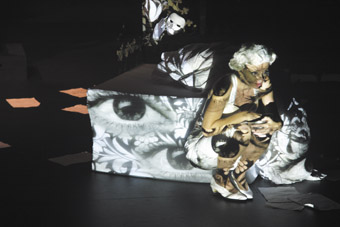
Scotia Monkivitch, A Mouthful of Pins
photo Bev Jensen
Scotia Monkivitch, A Mouthful of Pins
THE NEST’S A MOUTHFUL OF PINS ATTEMPTS TO WRING ENDURING BEAUTY FROM THE TERRIBLE EXPERIENCE OF MELANCHOLIA OR DEPRESSION. KOKO (LEAH MERCER), AS OUR CONTEMPORARY, CARRIES “THE TORN PAGES OF HER STORY UP THE STAIRS OF AN OLD VICTORIAN APARTMENT BUILDING IN BRISBANE.” HERE SHE MEETS, OR IMAGINES SHE MEETS, TWO DIFFERENT HISTORICAL CHARACTERS, ONE AN EXTRAORDINARY REGENCY PERSONAGE BASED ON THE LETTERS OF JANE AUSTEN (AOLE T MILLER), AND THE OTHER A 50S HITCHCOCK BLONDE/HOUSEWIFE (SCOTIA MONKIVITCH). THERE IS A SETTEE AND A COLLECTION OF BIRD-LIKE COMMEDIA MASKS SUGGESTING THAT THEY ARE KOKO’S ADOPTED PERSONAS.
Madness is in the air. Nature is outside (flitting bird images) and projected titles record the remorseless succession of days in a series of cryptic notes and quotes: “‘There isn’t a Monday that would not cede its place to Tuesday.’ Anton Chekhov.” Live music (piano and violin), song, visual images, the dislocation of narrative units along with highly suggestive symbolic actions invest the piece with deliberate ambiguity. These strands came together most movingly in an extended piece played by a violinist over the recumbent, temporarily enervated and silent figures on stage. At this point it became evident, looking at it from a Lacanian perspective, that “The things we are dealing with…are things in so far as they are silent. And silent things are not quite the same as things that have no connection with words.” At the very beginning, in order to define the space, words on paper are laid out in a circular pattern blank side up so that they are ritually obscured from sight. We are not dealing with a clinical case. What is of primary importance is, in Julia Kristeva’s terms, the rhythms and alliterations of semiotic processes which, combined with the polyvalence of sign and symbol, “unsettles naming.” In the best sense, The Nest’s project is grandiose: attempting to capture the sublime in art.
As a writer, Leah Mercer is obviously conversant with psychoanalytical concerns but (rightly) stops short of fully articulating them: “Sadness is a memory of something long ago, can you call it a memory if you can’t remember it? A memory of something I cannot quite recall, the unremembered, the unrememberable sitting there high in my chest.” Her adoption of a depressed person’s monotonous and rhythmically repetitive delivery stems from this sadness lodged in her chest, sentences that, as Kristeva describes them, “come to a standstill.” I admired what amounted to a sustained virtuosic performance of its kind, but questioned whether Mercer’s affects contributed to theatrical efficacy. At times it seemed that the beating heart of the production had also come to a standstill, and surely the beautiful words of her last song—“Singing is breathing, is thinking, is speaking…”—demanded soaring to the heights? The depth of Koko’s situation is encountered through an act of fellatio which, on the surface, seemed to imply for some in the audience a history of sexual abuse. I read it, to the contrary, as a rupture of Koko’s hermetic world. Abruptly propelled into a different space, she finds resources of compassion and forgiveness that lead her to intervene in the ritual self-harm perpetrated by the Monkivitch character.
The choice of a male to play the Jane Austen part had pluses and minuses. It allowed for Koko’s repudiation of the phallic mother in the fellatio scene but didn’t necessarily enable her to resist the circuits of patriarchal exchange within which they function as objects. But I’m afraid that Miller’s drag queen performance militated against any elaboration of this idea. This was a pity, though this richly written role has sent me off in search of Jane Austen’s letters.
Scotia Monkivitch’s hard boiled but vulnerable Hollywood diva displayed symptoms of hysteria rather than melancholia. She points this out herself when she expresses the view that Freud would have labeled all three characters hysterics. In this respect, she also appeared to be less passive than the others—the literal metaphor for her character being that the shoe doesn’t seem to fit. Monkivitch is also the most engaging performer, combining a clown’s panache with acid one-liners that cut (!) through Koko’s unremitting gravitas and the high-handed style of Miller’s Jane Austen. Her eruptive dancing with the latter evokes the sheer possibility of jouissance, of an active resistance. She is a fusion of acting and acting out. Unable to utter the void, she too is “growing a book/ tending slender pages of skin/ to replace you” (her ex-lover). Her brashness only renders her self-laceration more painful to the audience; attacking her own thighs with a knife in semi-seductive fashion negates all concepts of desire. Her most gorgeous and revealing theatrical moment occurs, however, when she comically stuffs her mouth with marshmallows. This action was prefigured when she insouciantly demanded her share of opium drops medically prescribed for her Regency counterpart.
Monkivitch’s excessively mimed bulimia is likewise prescriptive but also contains the idea of a not wholly successful attempt at self-determination. Thus there is unresolved irony as the lights fade after Koko’s apparently triumphal song. Monkivitch crouches like a cornered animal confronting the audience with her steely determination to remain hard boiled (thus untamable), at any price, unless the future manifests the kind of social revolution that legitimately grants women autonomy as subjects. There was much to admire about this brave and ambitious piece of contemporary performance despite a demonstrable need for reworking.
A Mouthful of Pins, writer Leah Mercer; director Margi Brown Ash, performers, Aole T Miller, Leah Mercer, Scotia Monkivitch, visual artist Jaqui Vial, production designer Bev Jensen, lighting designer Simon Johnson, music composed & performed by George Valenti and Moslo, songs & soundscape by Reilly Smethurst; Brisbane Powerhouse, Feb 14-16
RealTime issue #84 April-May 2008 pg. 38
© Douglas Leonard; for permission to reproduce apply to realtime@realtimearts.net
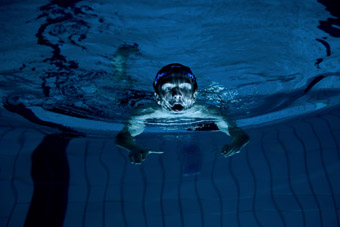
Head Under Water
AS THE GERMAN FILM INDUSTRY GROWS AND PROSPERS, THE GOETHE INSTITUT’S ANNUAL FESTIVAL OF GERMAN FILM ALLOWS CINEFILES TO KEEP TRACK OF THEMES (NOT A FEW OF THEM RECURRENT), TRENDS AND THE DEVELOPING VISIONS OF KEY FILMMAKERS. THE FESTIVAL REPORTS THAT “IN 1997 GERMANY PRODUCED 61 FEATURE FILMS, 14 OF WHICH WERE CO-PRODUCTIONS. TEN YEARS ON AND THE COUNTRY’S CINEMATIC OUTPUT HAS DOUBLED, WITH 122 FILMS BEING SHOT IN 2007, INCLUDING 46 CO-PRODUCTIONS.” THERE ARE 22 NEW FILMS IN THE 2008 FESTIVAL.
Director and novelist Doris Dörrie, who has been making confronting films since 1983, is represented by two works. In the acclaimed Hanami (2008), a man with a terminal illness suffers the sudden death of his wife and journeys to Tokyo where the cherry blossom festival provides final solace. In her 2002 feature Naked, Dorrie has two married couples play a game in which, blindfolded, they see if they can each pick their partner’s naked body: the consquences are unexpected.
Miguel Alexandre’s Border of Despair furthers the ongoing analysis of East German life under the Stasi as witnessed in last year’s controversial The Lives of Others, focusing here on a mother and her children attempting to flee to Romania. The World War II fate of Germany’s Jewish population is returned to in the Academy Award winning The Counterfeiters [director Stefan Ruzowitzky], in which Jewish prisoners are forced into currency counterfeiting. In The Edge of Heaven, German-Turkish writer-director Fatih Akin uses a pair of mature parent-child relationships to explore deeply rooted cross-cultural tensions in which prostitution and lesbianism clash with conservative norms.
Kafka High is the setting for Andreas Kleinert’s Head Under Water, something more than a black comedy about murder in a village school. Also on the teenage front, in Volker Einrauch’s The Other Boy, domineering parents and a school bully trigger unexpected behaviour from an introverted child—the result apparently divides audiences—just what you want in a good festival. Dennis Gansel’s The Wave is based on a true story from the US in 1981, transfered here to contemporary Germany, in which a school teacher created ‘a learning experience’ in fascism. It went terribly wrong, suggesting the ease with which the ideology can manifest itself.
The advance word on these films is good, promising a stimulating festival. Festival guests include leading German actor Jürgen Vogel, who appears in six of the festival’s films, emerging director Martin Gypkens (Nothing But Ghosts, one of the festival films), and leading German film writer and reviewer, Anke Zindler. RT
2008 Audi Festival of German Film, April 16-26, www.goethe.de/australia
RealTime issue #84 April-May 2008 pg. 26
© RealTime ; for permission to reproduce apply to realtime@realtimearts.net
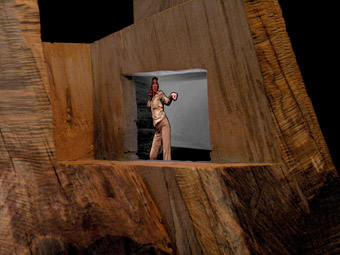
Habitat, LaborGras, Volker Schnüttgen and Frieder Weiss
photo Volker Schnüttgen
Habitat, LaborGras, Volker Schnüttgen and Frieder Weiss
FRIEDER WEISS LIVES IN NÜRNBERG AND BERLIN AND WORKS AS AN ARTS “PROBLEM-SOLVER” IN EUROPE AND INTERNATIONALLY, USING HIS INNOVATIVE VIDEO MOTION SENSING SOFTWARE TO COLLABORATE ON DANCE, PERFORMANCE, THEATRE AND INTERACTIVE INSTALLATION PROJECTS. HE HAS COLLABORATED WITH MELBOURNE’S CHUNKY MOVE DANCE COMPANY ON GLOW, NOW TOURING THE WORLD, AND MORTAL ENGINE [see article RT 81, and RT 83], WHICH PREMIERED AT THE 2008 SYDNEY FESTIVAL. DESPITE THE ONGOING SUCCESS OF GLOW, THE POSITIVE RECEPTION IN SYDNEY TOOK WEISS BY SURPRISE BECAUSE, AS HE SAYS JOKINGLY, “I’M AN ENGINEER, I’M LOOKING FOR PROBLEMS.”
From 1995 to 2006 Weiss was Co-Director of Palindrome Inter.Media Performance Group. Nowadays he works independently, collaborating with artistic partners who are interested in interactive systems. Both Mortal Engine and Glow use the Kalypso program developed by Weiss, where an image of the performer is captured using a video camera and fed into a computer. Weiss’ system relies heavily on this video capture, using infrared sensing from which it detects the outlines of the performers’ bodies and creates various visualisations and transformations.
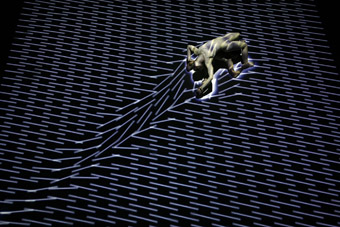
Chunky Move, Mortal Engine
glow & mortal engine
It is this specialised software that allows Weiss to create the mesmerising imagery and interactions that characterise the Chunky Move pieces, with these complex visualisations projected back onto the dancer and stage in real time. When deciding on projects to collaborate on, the important thing for Weiss is the feel of the working environment, and he describes the relationship with Chunky Move as “a good match from the start.” With them he also found an artistic approach that was a particularly “good match” with his software systems. Artistic Director Gideon Obarzanek’s choreography often positions the dancers’ bodies close to the floor and Weiss similarly describes his technology as “getting close to the body.” With the dance floor in Glow and Mortal Engine acting as a horizontal screen, the performers can move across the whole projection area. By having the dancers close to the screen, Weiss notes that it’s much easier for audiences to focus on both the dancer and the visualisations at the same time, as opposed to performing in front of vertical projections where audiences “often watch the screen and lose the dancer.”
One of the elements that Weiss finds particularly pleasing about Mortal Engine is the way that the dancers’ bodies are accentuated not only through spotlighting, but also by darkening the stage at points where the performers are. In this way, the dancers are highlighted through “indirect light” and reflections off the floor, giving depth to the projected imagery and creating “a different kind of shadow.” This provides an interesting symmetry with some of Weiss’ previous works, which have used multi-layered visualisations to multiply and interact with performers’ silhouettes.
shadow play
Weiss created the piece Solo 4 > Three (Shadows) with Australian dancer Emily Fernandez, in which Fernandez performs in front of a single vertical screen projection. As she moves, her shadow is captured and multiplied by Weiss’ software and projected back onto the screen. This creates a layering effect of moving black and white silhouettes which appear and disappear, multiply and dwindle as the piece progresses. Weiss has recently expanded this technology with German dance collective LaborGras into a five screen installation. The flat, black and white shadows of the previous work are transformed into colour, photoreal reflections of the performers, with these images again being multiplied and layered on the multi-screen set-up. Each performance lasts for four hours (audiences can come and go) with three performers alternating in 45-minute sets of largely improvised dance, continually encountering their projected doubles (and triples), creating a combination of real and virtual spatial relations.
performative installation
Habitat, Weiss’ most recent collaboration with LaborGras, is a performance and sculptural installation piece that takes cross-disciplinary collaborations in further directions, incorporating sculpture with dance, computer-generated visualisations and virtual environments. Produced with German sculptor Volker Schnüttgen and performed at Montemor-o-moro, Portugal, in February 2008, Habitat uses Weiss’ interactive systems to facilitate more ephemeral interactions between the dancers, sculptures and the audience.
Installed within a performance space, Habitat is made up of several large, heavy oak sculptures, each with an in-built LCD screen which acts as a “virtual stage” for the performers. While the audience wander freely around the sculptures, the dancers perform the choreography in a separate space. More than simply a “live feed”, Weiss uses his Kalypso software to generate “virtual worlds” that are visible to the audience on the screens, and which the dancers can interact with in real time. Another screen in the performance space means that the dancers “can see the results they’re creating”, such as disappearing behind a wall on the virtual performance space, but remaining visible in their real location. Unlike the Chunky Move pieces, LaborGras uses more improvisation, which also elevates the possibilities of these real and virtual interactions.
Weiss is happy with the result, saying that the interactions between the performers in the real and virtual worlds were “really interesting, in some cases.” However, when asked whether the audience realised that the images were real time projections and not pre-recorded video, Weiss says “to be honest, I think 50 per cent got it without explanation.” While Weiss is continually refining his software and fixing certain issues, it is often the relationship of the audience with the technology and the performance that is most difficult to pre-empt and predict, especially in a work like Habitat when “there’s a separation between the performers and the visualisation.” More than simply a balancing act, Weiss laughs, describing it rather more frankly: “It’s a battle!” When working on such complex multi-disciplinary projects, often performed in non-traditional spaces or set-ups, the key for Weiss is to work with the possibilities and the limitations of the space and the system.
multimedia public art
The flip side to this is the unexpected successes that emerge, both in terms of the technology and audience reactions, as is the case with Weiss’ most recent public installation in Sandnes, Norway, entitled Ønskebrønn, The Wishing Well. Developed with German performance company phase7 for the 2008 European Capital of Culture, Ønskebrønn is an outdoor multimedia sculpture with a horizontal 80 square metre interactive screen. Comprising approximately 260 LED panels, the installation reacts directly to visitors’ movements as they step on and move around the panels, producing colourful and interactive visualisations. The images produced are much like those seen in Glow and Mortal Engine. However, unlike the Chunky Move pieces, which project and reflect light onto the dancers, the use of LED screens means that this installation is visually much brighter, glowing in the long Norwegian winter nights.
Not surprisingly, the challenges involved when installing the sculpture were significant and Weiss was sceptical as to whether it could succeed. As he says, the freezing outdoor conditions with rain, wind and snow are “not exactly what technology likes”, however the installation has proved a huge success with visitors and Weiss says the local community has become “a bit obsessed with it.” The city of Sandnes has held dance competitions on the installation, and if you log-on to the installation’s webcam, visitors can sometimes be seen dancing and playing in the early hours of the morning. For these reasons, Weiss describes it as one of the most fun installations that he’s done. As with Glow and Mortal Engine, he enjoys the chance to reach broader audiences, along with the ongoing opportunities of adapting his technological “tools” to the challenges (and limitations) of new artistic possibilities.
–
Chunky Move, Mortal Engine, Edinburgh Playhouse, 2008 Edinburgh International Festival, Aug 17-19
For video clips and photographs of the works of Frieder Weiss go to www.frieder-weiss.de
Solo 4 > Three (Shadows) http://www.emily.li/
I, Myself and Me Again http://www.euro-scene.de/v2/de/festivals/2007/videos/2007-hp02.php
Habitat http://www.laborgras.com/english/news/newshabitat.html
http://www.volker-schnuettgen.com/habitat/index.html
Ønskebrønnen http://watercolors.demo.coretrek.no/the-wishing-well/category178.html
http://www.watercolours.no/the-wishing-well/category187.html
RealTime issue #84 April-May 2008 pg. 28
© Kate Warren; for permission to reproduce apply to realtime@realtimearts.net
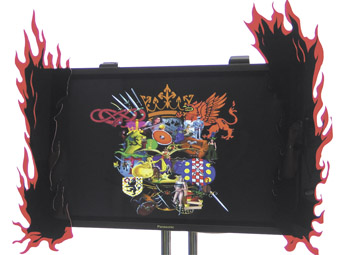
Eddo Stern, Best…Flame War… Ever (2007)
“VIDEO GAMES ARE THE FIRST STAGE IN A PLAN FOR MACHINES TO HELP THE HUMAN RACE, THE ONLY PLAN THAT OFFERS A FUTURE FOR INTELLIGENCE. FOR THE MOMENT, THE INSUFFERABLE PHILOSOPHY OF OUR TIME IS CONTAINED IN THE PAC-MAN. I DIDN’T KNOW, WHEN I WAS SACRIFICING ALL MY COINS TO HIM, THAT HE WAS GOING TO CONQUER THE WORLD. PERHAPS BECAUSE HE IS THE MOST GRAPHIC METAPHOR OF MAN’S FATE. HE PUTS INTO TRUE PERSPECTIVE THE BALANCE OF POWER BETWEEN THE INDIVIDUAL AND THE ENVIRONMENT, AND HE TELLS US SOBERLY THAT THOUGH THERE MAY BE HONOR IN CARRYING OUT THE GREATEST NUMBER OF VICTORIOUS ATTACKS, IT ALWAYS COMES A CROPPER.”
Chris Marker, Sunless
Truncated, repetitive, coin-operated nihilism? To a point. The “insufferable philosophy of our time” is not a single object or symbol, but an array of signs and symbols placed at odds with each other, made to wage a type of war we aren’t told how to engage with. We were told that play would desensitise, depoliticise and disconnect us, and now games are presented by the museum as the latest historical and contemporary cultural artefacts. So what happened?
To come to this point in proceedings exceedingly peculiar trajectories have been followed. The uneasy relationship between playful art practice and gallery culture always provided some friction, but there had always been something gauche about videogames, something beyond the pale. For over 20 years, there has been a relentless drumbeat of deferral—game art was always immature, not practical enough, too ephemeral, not critical enough. Rather than the always expected, never-mature ‘growing up’ of videogames and art, something funny happened on the way to the arcade. Games became permanently happy with their status as technological adolescents, always in the pouty, rebellious but also permanently lame zone of transition.
With very few caveats, the Australian Centre for the Moving Image has to be celebrated for its commitment to furthering the cultural capital of games. As the final months of the excellent experimentally focused Games Lab tick on, and ACMI’s transformation of the ground floor space into a screen culture antipasto takes shape, questions remain about how institutions see computer and videogames. That is, if they see them at all. There was always the threat of endorsement by government bodies becoming a stamp of legitimacy for commerce, but a happy if not always balanced path has been struck at ACMI with great effect.
This version of the monstrously popular Game On show adulterates the ever-sombre Screen Gallery with splashes of neon and carves out a tentative arcadia from what it steals from the abyss. Yet the two bookended iterations of the Game On show tell very different stories about games in galleries. In London’s original 2002 Barbican show, games and art co-existed, perhaps uneasily, but certainly in co-habitation. In Melbourne, a very different show strips back art’s presence but casually, almost without context, places game art at the literal end of the gallery space. The result is almost like a sensory prestidigitation; space designed for the element of surprise.
After a section on Australian-made games and cultural differences made playable, the visitor enters a walled-off screen room that is strangely designed to not appear at all. The ominous stone-cold lighting of ACMI’s screen gallery space has led to some amazing tricks of light in past shows, but the collection of works is being shown in the screening box of this show are like an amnesiac’s sudden flash recollection.
Artist Eddo Stern’s new work, Best…Flame War… Ever (2007) is the standout in this space. The video assembles faces in the style of Giuseppe Arcimboldo’s vegetable people and Jan Svankmajer’s Dimensions of Dialogue. Here, the figures are made up of World of Warcraft character models, desktop icons and other detritus. Their discussion is a monotone retelling of an internet flame war. If the principle is absurd, then the execution is a carnival. The pageantry of this work (crowns and all) demands an answer. At the literal end of the gallery, clustering together game technology, culture (and yes, commerce), arranged to tell a history, game art is positioned as the literal future of games.
It is true that ACMI’s Screen Gallery has always benefited from the sonorous secrecy of these zones, but the gamer logic of the show develops this one room like a secret area, accessible only through a ‘no clipping’ cheat.
A secret place always has aspects of a ‘removed’ existence, being a place that, physically or mentally, is created for retreat, intimacy, enclosure, screening, and protection. These often are places of power and control that cannot be known or invaded by ‘outside’ forces.
Frances Downing, Remembrance and the Design of Place
The secret place is, in actuality, the computer and videogames themselves. Growing up, they become cocoon-like and comforting in their particular idioms, capturing us in parallel zones and offering us an endless virtuality. The conflict with the art gallery was inevitable and will forever be unresolved. There are institutional and contextual tensions visible in Game On, but they are swerves rather than fractures. So how does a space—with contemporary art such as Eddo Stern’s, an independent game such as the furiously kinetic Warning Forever on a slightly grimy PC, and commercial game products such as Super Mario Kart—work? More importantly, what is it called?
Games in the gallery are asked to position themselves between a whole range of forces and bodies, to offer rules for others to play in. They are asked to bring in those who don’t usually come, while infecting them with art and thought. So on the question of the gallery, it will be difficult to imagine game art exhibitions 10 years from now being organised without reference to commerce simply because so much of the aesthetic of seriality is commerce driven. There does not need to be a corporate partner for the vast logical construct of product to rear its Pokemonic head. As Carlota Fay Schoolman and Richard Serra would say, gaming delivers players.
So Game On is the first truly major exhibition of videogame culture to come to Australia, and it is stained with all the baggage that honour provides. The subtle narrative it elicits is more timid than its international predecessors, but retains a glowing core of insight into the problems it poses. Galleries both big and small—and especially ACMI—will have to provide some answers and face up to the challenges that games provide to the categories of ‘art’, ‘commerce’, ‘the origin of the work’, and exhibition itself.
Especially important once the first major show packs up and the planning for the second takes place will be the role of the archive. How to speak about and access history has been gaming’s most difficult problem, and is it where bodies such as ACMI will potentially have the most positive impact? Game On offers some clues about how we will proceed as players, offering up art as a kind of semantic adulthood, but it is in preservation and historical framing that the show’s presence will be most keenly felt. We are already asking why we are disallowed access to our gaming past by corporate gatekeepers. The time has come for arts institutions to intervene; playtime is over.
Game On, organised and toured by the Barbican Art Gallery, City of London; Australian Centre for the Moving Image, March 6-July 13. www.acmi.net.au/game_on.aspx. The exhibition includes 125 games that can be played by visitors, taking them through the history of the form.
RealTime issue #84 April-May 2008 pg. 29
© Christian McCrae; for permission to reproduce apply to realtime@realtimearts.net
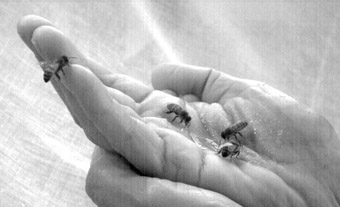
Trish Adam, HOST (video still), original cinematography Carla Evangelista
FOR CHILDREN, BEES ARE THE SUMMER TERROR OF THE CLOVER LAWN. OUT THE CAR, ACROSS THE PARK TO THE BEACH, PRICKLES ARE BAD BUT BEES ARE WORSE. (I’VE JUST CONDUCTED A SURVEY OF ALL THE PEOPLE I CAN IMMEDIATELY FIND WITHIN 20 METRES OF WHERE I’M SITTING AND THEY ALL REMEMBER THEIR FIRST BEE STING.) SO BEES ARE THREATENING, YET HERE BEES ARE, IN TRISH ADAMS’ HOST, GLIDING ABOVE AND GENTLY SETTLING ON HER UNPROTECTED HAND.
Trish Adams has previously collaborated with scientists at the University of Queensland where she worked with Associate Professor Victor Nurcombe on the transformation of her own stem cells into cardiac cells (machina carnis, www.realtimearts.net/article/issue68/7937). This time she worked with Professor Mandyam Srinivasan’s Visual and Sensory Neuroscience group at the Queensland Brain Institute. Srinivasan is famous for his work on bee vision and navigation.
[Three interesting facts about bees: 1. Bees can be trained to detect camouflaged objects. 2. Bees navigate by using the speed at which images move across their eyes—they fly down the middle of a tunnel by keeping the image speed the same at both eyes; they land by adjusting their descent speed so that the image speed at the eye remains constant. 3. Bees are lateralised in their learning, just like people are right and left handed. ]
Into the Bee House goes Adams and finds no protective suits, just your normal everyday science types, thousands of bees and an uncomfortable feeling of vulnerability. A couple of researchers, Dr Peter Kraft and Carla Evangelista, help out by filming the feeding sessions (high speed at 250fps) and providing the skills and patience needed to train the bees to feed from Adams’ hand. Film is edited, a soundscape designed (by roundhouse, www.roundhouse.tv), and the installation set up at the UQ Art Museum—a bland corporate box of a building refurbed into a gallery.
Enter through the glass doors, straight ahead to the far corner and down the stairs. Step off the stairs and a waft of honey rises up, faint, but clear. Small room, low ceiling, padded lowset bench. Sit and face the end wall/screen. Glass panel walls to the right and left shine in the darkness, recursively reflecting the far end projection. This is the installation space, quiet, intimate. Maybe two or three people can get in there without violating personal space rules. The screen shows a video laterally split between two images. One third is honey, dripping in real time, close up, luminous and golden. Two thirds are a cropped detail of hands. The hands are crossed lightly, one nestling in the other. Inside the cupped palm of the uppermost hand is the honey the bees were trained to seek. The hands are still, incredibly so, one slight thumb movement the only action. Around the hand float soft, purposeful bees, huge and close-upped, paced slow by the high speed video. They glide about, land to feed, take off, land on a finger, wait, take off again. They make no sound. It is as if the bees hover weightless above a familiar surface, collecting samples before returning to base.
And throughout are the hands and an unconditional offering of food. The bees too act without conditions, offering their labour to the continuity of the hive. The food they collect is not only for themselves but for others, just as the glistening honey in the palm is not for the palm itself and the outstretched hands are for the bees and not for the hands themselves. The artist feeds the bees, the scientists film the artist. We watch the bees, the honey and the hands. An exchange between systems. Biology.
HOST, artist Trish Adams, The University of Queensland Art Museum, Brisbane, March 6-April 6
RealTime issue #84 April-May 2008 pg. 31
© Greg Hooper; for permission to reproduce apply to realtime@realtimearts.net
THE AUSTRALIA COUNCIL’S INTER-ARTS OFFICE NOT ONLY FUNDS PROJECTS THAT CAN’T FIND TRADITIONAL ARTFORM HOMES BUT IT ALSO ENCOURAGES VERY DIFFERENT ARTISTS TO TEAM UP AND VENTURE WHERE NONE HAVE TROD.
Artlab funding criteria require not tried collaborations but new ones; experimental, research-based and risk-taking approaches; and, if the project involves creating technologies, they must be new. It’s a tough brief requiring a strong sense of vision, teamwork and, not least, pragmatism: significant cash or in-kind contributions have to be found beyond the Australia Council’s $75,000 funding of each project in 2008. Twenty two applications sought a total of $1.5m; two succeeded for a total of $150,000.
Thinking Through the Body comprises the artists Jonathan Duckworth (artist and architectural designer specialising in the development of real time graphical environments), George Khut (artist working in the area of sound and immersive installation environments), Somaya Langley (sound and media artist), Lizzie Muller (curator and writer working at the intersection of art, technology and science), Garth Paine (sound designer, installation artist, interactive system designer) and Catherine Truman (contemporary jeweller and object-maker). The collaborators intend “investigating the use and potential of touch and movement in body-focused interactive art. The group will use a variety of body-sensing technologies to explore the possibilities of interactive art that links technical experimentation and artistic expression.”
The Transmission Project: Wheel, Water, Wind brings together Rod Cooper (hybrid instrument maker), Robin Fox (sound artist working with live digital media), Jon Rose (violinist, composer, writer and installation artist), Jim Sosnin (a specialist in acoustics, audio electronics, sound recording and computer music) and German artist Frieder Weiss [see interview] to develop “a wireless data technologies platform for designing human/machine interfaces. The team will investigate the compositional, installation and performance possibilities of the design, presenting works in progress on the themes of Wheel, Wind and Water during the testing stage of development.”
Andrew Donovan, Director of the Inter-Arts Office of the Australia Council, is pleased with the 2008 Artlab funding results. In his report he writes, “The panel was particularly responsive to projects that detailed a concise and logical research methodology, whilst clearly articulating potential artistic outcomes for the project. The panel was also responsive to applications that were genuinely collaborative in nature, reflecting the objective of the ArtLab program to nurture and support new interdisciplinary, artistic collaborations that offered the best opportunity for the development of new knowledge, artistic innovation and creative risk-taking.”
Donovan told RealTime that he welcomes the diversity of arts practitioners in each project, the range of age and experience and the geographical spread. He’s especially impressed with the number of experienced artists willing to place themselves in very new collaborative circumstances. The assessment panel, he says, were particularly taken with the research and development process embodied in the projects. “This can develop a platform—with innovations in software and hardware—to push hybridity forward, making it easy for other artists in the future to break through technical barriers.” RT
RealTime issue #84 April-May 2008 pg. 31
© RealTime ; for permission to reproduce apply to realtime@realtimearts.net
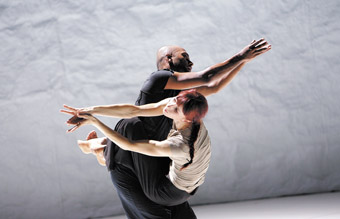
Akram Khan, Sylvie Guillem, Sacred Monsters
photo Nigel Norrington
Akram Khan, Sylvie Guillem, Sacred Monsters
TIME STANDS STILL IN THE MOST INTERESTING WAYS IN EMBRACE: GUILT FRAME. BECAUSE THE PERFORMANCE BALANCES ON A PIVOT OF STILLNESS AND EXTREMELY SLOW MOVEMENT, THERE’S INEVITABLY A PICTURE-LIKE QUALITY TO THE WORK ENHANCED BY THE ACTION BEING RESTRICTED TO A SMALL GILT FRAME THAT LIMITS OUR VIEW TO THE HEADS AND UPPER TORSOS OF TESS DE QUINCEY AND PETER SNOW. IT’S THE TIME OF THE ART GALLERY, EXCEPT THAT YOU CAN’T MOVE ON AFTER A FEW MINUTES OF VIEWING. YOU STAY STILL; THE PICTURE KEEPS CHANGING FOR SOME 50 MINUTES.
What we see pictured remains peristently enigmatic, always suggestive, of individual emotional and physical states, possible relationships, the history of painting even—such is lighting designer Travis Hodgson’s subtle texturing and profiling, his shifts in depth of field, evoking Carravagio, Vermeer, Rembrandt and more.
De Quincey and Snow work their way through a set of states common to The Natyashastra (an ancient Indian text) and Body Weather (the contemporary Japanese movement discipline; see RealTime 83, page 45 for an interview with De Quincey) but never literalise them. A smile is a smile, a grimace a grimace beneath which might be ecstasy or anger. But it’s the slow unfolding of these states that compels one to look for complexities, tensions, shared pleasures, changes in mood. Humans enjoy peering at portraits, painted or photographed, as if endlessly rehearsing primordial encounters with strangers in our evolutionary development. Embrace: guilt frame allows us to read faces with a rare intensity, registering tiny details, forming impressions, re-evaluating, never resolving. It’s a peculiar pleasure made palpable by disciplined performers who ease themselves into a temporal state slower than our own and invite us in.
But there’s more to embrace: guilt frame than faces—radical if slow changes in perspective, supple tonal shifts and endless evocations. There are moments when the performers lean out of the frame towards us, or recede into its deep dark interior; a moment when de Quincey turns ever so slowly, low in the frame, only her head, its back to us, providing support—it looks simple but must require great strength. There are moments that appear Gothic—the prolonged shudder in the residue of a laugh, Snow’s shaded face appearing to fatten with anger. There’s the suggestion of a grim puppet show—de Quincey’s head lolling like a fallen Punch. There’s a rare moment of touch, electric when it happens, other moments of apparent adoration or deep suspicion that suggest a relationship dancing in and out of sync.
Composer Michael Toisuta’s score operates at another level, a reminder with its persistent pulse of time manufactured and multiplied. Inspired by Ligeti’s Symphonic Poem for 100 Metronomes (1962) this surround sound creation is enveloping and some of its more dramatic changes in pace sharply re-shape the mood of the performance. There’s no sense, however, that de Quincey and Snow perform to it; it’s simply there with them; its time is not theirs.
Embrace: guilt frame is a small, intense work by skilled performers in a tiny theatrical frame that enlarges both our sense of time and of how driven we are by our visual curiosity.
The Akram Khan-Sylvie Guillem duet, Sacred Monsters, is a very different experience, but it also has its roots in ancient Hindu culture and it too suspends our sense of time, if speed is more often its means than stillness. The work is very much framed by Khan’s story about himself as a young man wanting to play the god Krishna, but disappointed that he was too short and already losing his hair. He would find his way, he said, by finding the monster in himself, and that monster may well have been his meeting with modern western dance. By the end of Sacred Monsters he appears to have achieved the release and transcendance he has desired, but in a remarkable duet, not just his agonised solo—the god in many, not one.
There is therefore a very strong sense of release in this work. The initial image is of a still, chained Guillem, whom Khan soon frees. He then removes the long chains wrapped around his calves, hidden beneath his trousers, but heard jangling musically in the dance. Towards the work’s end, Guillem gently touches Khan’s bowed head as if investing him with godliness. Although Sacred Monsters largely comprises duets, each performer, while sitting, sipping water, wiping away sweat with a towel, intently watches the other’s solo. There’s a potent sense of mutual support and release.
There’s also a great sense of playfulness, of gentle mockery and brattishness in the dialogue. But the dancing expresses darker tensions between these divas (‘sacred monsters’ is the translation of the 19th century French term for ‘stars’) as they strike at each other, reeling from the impact before being actually hit, as if the work they had created together has been a battle. At separate points in Sacred Monsters, one falls prey to the other, flattened, left limp…ready to airily chat with us and move on. The informality is heightened by the musicians (providing another East-West dynamic) sitting on stage with the performers and the female singer moving around the dancers.
A critical point occurs when Khan sits upstage quietly uttering, “Is this right?”, “Just an experiment!”, as if querying and asserting his melding of ancient and modern traditions. Moving forward on his knees, torso low to the floor, almost abject, his delivery becomes more urgent. His right arm shoots out and withdraws. Suddenly he thrusts his body up, almost erect, suspended, before falling to the floor and moving even more urgently forward again reporting the action. It’s an astonishing and painful dance. And crucially it’s followed by the pivotal duet of Sacred Monsters where Guillem straddles Khan, hip to hip, face to face. She leans back and they become one, an eight-limbed god in a dance of astonishing strength, sensuality and passion, their hands flickering their own finely articulated dance. Krishna.
Khan and Guillem languidly mop the floor with their towels (it’s your sweat, she mocks), preparing for a final, very earthed celebratory dance. Sacred Monsters is a wonderful collaboration, a fine conjuction of styles, traditions and personalities. Guillem’s stories are less elemental than Khan’s, less revealing, but wry and witty, reinforcing the embracing casualness of the show’s chatty framework (audible, if not always, in a concert hall bedecked with extra curtaining to damp the resonance). Her dancing, however, is almost beyond description, long lined and fluent, capable of breathtaking moves, like the reverse flip where her feet seem to barely leave the ground one after the other, and the ease with which she meets the speed and weight of Khan’s lower-placed centre of gravity. Sacred Monsters is a work of reflection and cross-cultural kinship, movingly and bracingly performed with great passion and remarkable skill.
–
Sydney Theatre Company, Wharf2Loud, embrace: Guilt Frame, created and performed by Tess de Quincey and Peter Snow, original concept Tess de Quincey, set designers Russell Emerson, Steve Howarth, construction by erth, lighting designer Travis Hodgson, sound designer Michael Toisuta; Richard Wherrett Studio, Sydney Theatre, Feb 27-March 9
Sacred Monsters, artistic director, choreographer Akram Khan, dancers Akram Khan, additional chorography Lin Hwai Min for Guillem, Gauri Sharam Tripathi for Khan, composer Philip Shephard, lighting Mikki Kunttu, set design Shizuka Hariu, costumes Kei Ho; Concert Hall, Sydney Opera House
RealTime issue #84 April-May 2008 pg. 32
© Keith Gallasch; for permission to reproduce apply to realtime@realtimearts.net
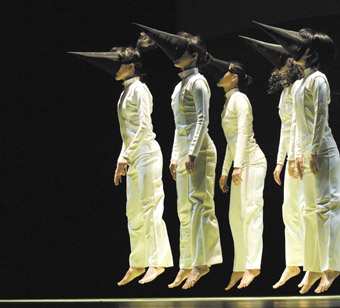
Dance Theatre ON, Ah Q
photo Choi YoungMo
Dance Theatre ON, Ah Q
THE DANCE PROGRAM OF THE 2008 SINGAPORE ARTS FESTIVAL IS PARTICULARLY STRONG, NOT LEAST IN THE WAY IT MORPHS INTO THE THEATRE PROGRAM WITH SOME FASCINATING HYBRID CREATIONS.
In Amjad, choreographer Édouard Lock and Canada’s La La La Human Steps challenge romantic ballet in the shape of Swan Lake and Sleeping Beauty. Lock was born in Morocco where Amjad, a name for children both male and female, means “greater glory”—the choice of title suggestive perhaps of Lock’s desire to transcend the inherent violence of gender divisions, not least in classical ballet. He requires of his company both ballet skills and hard-edged, fast contemporary dance.The multimedia set is by French-Canadian sculptor Armand Vaillancourt and the music mix comprises works by Gavin Bryars, David Lang, noise artist Blake Hargreaves and, of course, Tchaikovsky.
Romanian Edward Clug is the house choreographer and head of ballet at the Slovene National Theatre in Maribor, Slovenia’s second largest city. His Radio and Juliet is Romeo & Juliet performed to the music of Radiohead and tells the tragic tale in reverse. In another major work, The Architecture of Silence, Clug choreographs his company as fish-like dancers in virtual waters to contrasting requiems by Mozart and contemporary Polish composer Zbigniew Preisner (who scored films for director Krzystof Kieslowski). This epic production features 45 dancers, 80 singers and the Singapore Festival Orchestra.
In Japanese artist Nibroll’s No Direction, an exercise in miscommunication and an argument against homogenisation, eight performance artists “haphazardly inhabit a grid on stage, absorbing each other’s idiosyncracies and sporadic urges in a continuous interplay of music, movement, and visual images.” What began as an installation for Tokyo’s Metropolitan Museum of Photography has become a major performance work with the multimedia collective formed in 1997 by Yanaihara Mikuni. No Direction is dance and much more.
In Ah Q, South Korea’s Dance Theatre ON employs the Quixotic character from Luxun’s novel The True Story of Ah Q to explore the effects of ignorance and foolishness. Choreographer Hong Songyop’s productions are well known for their rich symbolism and surreal effects in their ventures into the psychological interior.
In the festival’s theatre program dance makes some intriguing appearances. In For all the Wrong Reasons, a collaboration between Belgium’s Victoria and the UK’s Manchester-based Contact, leading experimental theatre director Lies Pauwels addresses stupidity. The setting is a faded end-of-the-pier revue, the performace a set of dances, songs and confessional monologues replete with sheer silliness and moments of profundity (you can enjoy a delicate if bizarre dance segment on the festival website).
In Nine Hills One Valley, dancer-director-designer Ratan Thiyam and the Chorus Repertory Theatre of Manipur celebrate the traditional dance, theatre and other cultural forms of the remote regions of Manipur in eastern India, but they also lament the passing of these ancient and often interdisciplinary arts. Although not dance-based, Awaking, a new interdisciplinary work from Ong Keng Sen and TheatreWorks with contemporary Chinese composer Qu Xiao Song, looks to the literature, theatre and music of the past in very different cultures. Awaking addresses love through the works of Shakespeare and Ming Dynasty poet and playwright Tang Xian Zu, of Peony Pavilion fame. Both writers died in 1616. The performance features the Singapore Chinese Orchestra; the Musicians of the Globe led by Philip Pickett; and the kunqu opera actress Wei Chun Rong and her musicians from the Northern Kunqu Opera Theatre in Beijing.
The festival also includes Forward Moves, commissioned works from three female Singaporean choreographers: Ebelle Chong, Neo Hong Chin and Joavien Ng. Continuum from the Singapore Dance Theatre presents the Asian premieres of Evening by Graham Lustig (USA), The Grey Area by David Dawson (UK) and Glow-Stop by Jorma Elo (Finland).
On the experimental theatre front, Singaporean visual artist and filmmaker Ho Tzu Nyen [RT80, p54] and co-director Fran Borgia have been commissioned by the Singapore Arts Festival and Brussel’s Kunstenfestivaldesarts to create The King Lear Project: A Trilogy. The three productions, played over three days, work from well known critical essays on Shakespeare’s tragedy, realising them as audition, rehearsal and post-show discussion, worrying at the right way to stage the great work.
As for Australian content, in the 2008 Singapore Festival Geelong’s Back to Back Theatre continue on their quiet path to world domination with the remarkable Small Metal Objects. RT
The 2008 Singapore Arts Festival. May 23-June 22, www.singaporeartsfest.com
RealTime issue #84 April-May 2008 pg. 33
© RealTime ; for permission to reproduce apply to realtime@realtimearts.net
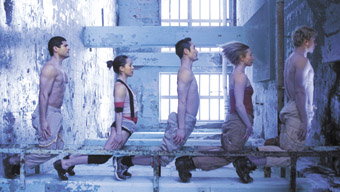
Pilobolus
photo John Kane, courtesy of the Joyce Theatre
Pilobolus
IN A 2005 ARTICLE IN THE NEW YORKER ON WHAT SHE SAW AS A SURREALIST REVIVAL IN DANCE IN DOWNTOWN NEW YORK, CRITIC JOAN ACOCELLA IDENTIFIED PILOBOLUS AS ONE OF THE PIONEERS OF THE MOVEMENT WHICH MORE RECENTLY HAD BEEN TAKEN UP BY CHOREOGRAPHERS LIKE TERE O’CONNOR AND FORMER MEMBERS OF HIS COMPANY INCLUDING UP AND COMING CHOREOGRAPHER/PUPPETEER CHRISTOPHER WILLIAMS. SHE EXAMINED CHUNKY MOVE’S TENSE DAVE, TOURING NEW YORK AT THE TIME, IN THE SAME SURREALIST LIGHT.
Taking its name from a sun-loving fungus, Pilobolus emerged in 1971 when a group of dance students at Dartmouth College interested in “a collaborative choreographic model and a unique weight-sharing attitude to partnering” decided to form a company. Pilobolus is still a deeply collaborative entity with three artistic directors and the company’s seven dancers all contributing to the repertoire. Merging dance and biology into an inventive and eloquent physical vocabulary, this is also a company with a mission “to use their organization and creative methodology to stimulate, educate and expand the audience for dance through innovation, collaboration and public service.”
Pilobolus is visiting Australia for the very first time in May, performing a five-work show in the hotbed of Adelaide Festival Centre’s variegated dance program, Pivot(al), including Day 2, set to the music of Brian Eno and Talking Heads which “captures the awe of evolution and the wonder of existence.” Let’s hope there’ll be time while they’re here for a little cross-pollination of ideas on artistic sustainability.
Speaking of survival, Dean Walsh is a highly accomplished Australian dancer/choreographer who has been evolving his own idiosyncratic body of work over a decade and, at the same time, performing with companies such as Australian Dance Theatre, DV8 Physical Theatre in the UK and No Apology Company in Amsterdam.
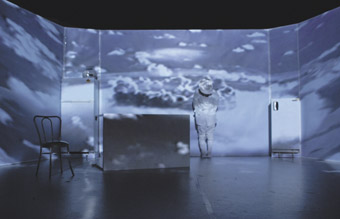
Dean Walsh’s Back From Front
photo Heidrun Löhr
Dean Walsh’s Back From Front
Walsh’s new work, Back From Front premiering at Performance Space in May, draws on stories from veterans of World War 2 through to the Iraq conflict. Walsh defines this as “a piece about the lingering impact of wartime experience on soldiers and their families—from the immediate challenges of re-adjusting to post-war life, to the continuing cycles of violence that can penetrate families for generations to come.”
Clearly referencing the territory of some of Walsh’s earlier, intimate solos, Back From Front is his first large-scale group work. With a strong cast and a team of production collaborators (including John Levey, Rolando Ramos, Simon Wise, Nikki Heywood) the work combines video imagery with lighting and movement.
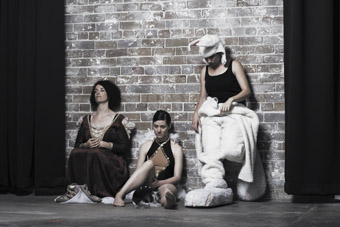
Elizabeth Ryan, Jane McKernan, Emma Saunders, The Fondue Set, No Success Like Failure
photo Irèn Skaarnes
Elizabeth Ryan, Jane McKernan, Emma Saunders, The Fondue Set, No Success Like Failure
Adaptation is what it’s all about for The Fondue Set (Elizabeth Ryan, Jane McKernan, Emma Saunders) and if their new work sounds a bit ‘under’ as they say on So You Think You Can Dance, it’s intentional. For a while now this talented trio has been performing serious experiments—taking dance apart and trying to put it back together in some semblance of order—while simultaneously masquerading as good time girls. In No Success Like Failure, their collaboration with the idiosyncratic UK choreographer Wendy Houstoun, they have distilled hours of serious experiment into an intriguing evening of performance in which they’ll be “lying, dying, singing, trying and trying again.” And as if that weren’t enough they also promise “motivational dancing, negative cheering, successful snoring, hypnotism, word bingo and more!”
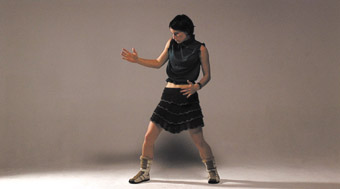
Sara Black, Dance Like Your Old Man, Chunky Move
The highly adaptive hybridiser Chunky Move, working across dance, film and interactive media, is currently thriving with the international suucess of Glow and now an invitation to stage their Mortal Engine at the 2008 Edinburgh International Festival. In works like Singularity and I Want to Dance Better at Parties, the company has also been evolving a repertoire of choreographic works that intersect with everyday movement. In the film Dance Like Your Old Man, Gideon Obarzanek and Edwina Throsby’s joyous and thoughtful 10-minute dance documentary, six women do just that, proving once and for all the power of body memory. As they recall their moves, the women also remember the men who made them (in more ways than one). With this film the company has collected a couple more trophies, namely the 2008 ReelDance Award for Best Dance Documentary and Best Documentary at this year’s Flickerfest Short Film Festival. RT
–
Pivot(al), Pilobolus, Her Majesty’s Theatre, May 6-10, www.adelaidefestivalcentre.com.au; Dean Walsh, Back From Front, Performance Space at CarriageWorks. May 1-10, www.performancespace.com.au; Fondue Set, No Success Like Failure, The Studio, Sydney Opera House, June 4-8, www.sydneyoperahouse.com; Campbelltown Arts Centre, June 12-14 June; Arts House, North Melbourne Town Hall, August; Chunky Move, Dance Like Your Old Man, Reeldance 2008, www.reeldance.org.au; Chunky Move, Mortal Engine, Edinburgh Playhouse, 2008 Edinburgh International Festival, Aug 17-19
RealTime issue #84 April-May 2008 pg. 33
© RealTime; for permission to reproduce apply to realtime@realtimearts.net
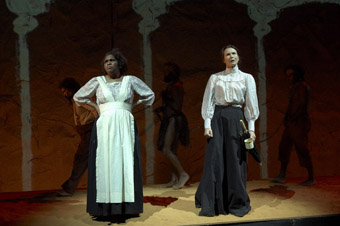
Ningali Lawford-Wolf, Margaret Mills, Kelton Pell, Tony Briggs, Jimi Bani, Jandamarra
photo Gary Marsh
Ningali Lawford-Wolf, Margaret Mills, Kelton Pell, Tony Briggs, Jimi Bani, Jandamarra
AFTER A ROCKY PREMIERE, JANDAMARRA BECAME A SUPERB WORK OF EPIC THEATRE, AKIN TO NEIL ARMFIELD’S CHEERY SOUL (1993) OR CLOUDSTREET (1998). DIRECTOR TOM GUTTERIDGE ECHOED ARMFIELD BY FILLING THE WINGS WITH PARTIALLY VISIBLE INSTRUMENTS, WIND-MAKERS, AND OTHER THEATRICAL MACHINERY WITH WHICH THE OFFSTAGE ACTORS VOICED THE ACTION. WITH ELDERLY INDIGENOUS SINGER GEORGE BROOKING SEATED BEFORE A MICROPHONE, THIS GAVE A SENSE OF MEMORY, BREATH AND RITUAL TO THE WORK, BRINGING THE ACTORS, FORMS AND HISTORIES TO LIFE.
Zoe Atkinson’s design for Jandamarra consisted of cliff panels—parting to reveal a vulva crease into which the protagonist stalked—bounded below by a sandpit from which set elements emerged or into which they were planted (fires, trees, graves). Platforms atop enabled split level performance, languid Indigenous scenes floating above tense European exchanges. Also remarkable was how Atkinson’s crinkled surfaces, projections of translations and Indigenous animations turned the space into a worn chapbook onto which histories and dreams were screened.
Jandamarra tells the story of the eponymous Aboriginal resistance leader in the Kimberley region in the 1870s, focusing on his complicated standing with whites and his own people. Never formally initiated into his clan, Jandamarra was befriended by the sporadically ruthless Constable Richardson before killing him and leading the Bunuba people against the graziers. The Bunuba attributed Jandamarra’s prowess to his magical skills, redefining him from tribal outcast to a key figure in their mythos.
Steve Hawke’s script was compiled with the traditional owners and Jandamarra’s story is portrayed in environmental terms above those of race or war. Jandamarra becomes one who, even without initiation, could read the land’s pain and recognise those waterholes which neither Bunuba nor white should disturb. Eventually, Jandamarra claims he fought not to defend his people per se, but the land itself. Although subplots involve black-white relations—notably the awkward reconciliation between the placeless station-owner’s widow and Jandamarra’s mother—the play comes across as somehow apolitical, being more about issues of the natural rather than racial oppression and armed resistance. It’s hard to imagine depicting the Irish resistance to English farming after 1600 in similar terms, despite the significance of Indigenous land use to both.
This recasting of identity in spiritual terms also characterised Tero Saarinen’s Borrowed Light. The Finnish choreographer drew on that American modernist archetype the Puritan sect, the Shakers. Together with the Amish, the Shakers’ austerity in their much collected furniture and quilts was central to 20th century American aesthetics, influencing architects (Frank Lloyd Wright’s furnishings), composers (Aaron Copland’s Appalachian Spring, written for Martha Graham) and dancers (Doris Humphrey, Twyla Tharp and Graham all produced Shaker pieces). The dialectic between Protestant restraint and the ecstatic seizures of devotees to such 19th century US ‘campfire meetings’ fascinated choreographers from Mary Wigman to Ruth Saint-Denis. Despite the hostility of these sects to modernism (the Amish do not drive) and social norms (the Shakers are celibate), they were central to post-WWII America’s self-definition as a streamlined, modern, yet lyrical, nation.
Saarinen sets aside these national references but embraces a nostalgia for disciplines of physical and emotional frugality and the tragedy of their loss. Borrowed Light is a hymn for a lost idea of what modern art was. Amidst the sustained simplicity of a choir (the Boston Camerata) singing Shaker hymns, Saarinen’s dancers twist and sway in unison (recalling Wigman’s “choric dancing”) before succumbing to individual contortions and an emptying out of the body via tension and release.
Bodies begin as trapezoids, with wide stompy legs (emphasised by the men’s black robes and the women’s dresses) rising to a dynamic torso. This alternates with expansion of the chest outward with arms not just flung back but curled into neurotic filigrees. Saarinen’s work is dramatically classical in its precision and sculptural form, yet its grotesque details recall butoh. The design also echoes Euro-American modernists, notably Adolphe Appia and Edward Gordon Craig, who advocated tides of directional white light between rising stairs to create a hierarchical space for the individual to strive for his or her spiritual ascent. Bounding the space, these flights and levels (differentially tinted black, grey and white by Mikki Kunttu) become a parable for the dancers’ terrestrial embodiment and their eternal striving, through and of the body, to free themselves. As dancers collapse and drag themselves across the space, the insufficiency of modernist ecstasy—as well as its joy—is performed.
A different sensibility is found in the work of Chrissie Parrott and Jonathan Mustard. Each piece in their trilogy, Metadance in Resonant Light, includes projection: animated figures in Recording Angel and Metadance, computer code in Metadance, and noirish Expressionism alongside the black-bobbed women of Split. Film noir is the dominant style in the latter, a duet supported by video showing dancers silhouetted in doorways. Head shots also feature, with hair swirling about visages, obscuring personalities even as they are suggested. Split evokes a house of memory and angst, affectively placing it in a predigital realm. This is further enhanced through haunting, aged-sounding music by Set Fire To The Flames. Split is animated by doppelgangers—the women’s other selves, and their struggle against their own otherness; femme fatales of their own desire. While similar to In Absentia (1997) by Sandra Parker and Margie Medlin—another work evoking uneasy memories through projection—Parrott’s work is more dramatic, with suggestions of specific (if opaque) characters.
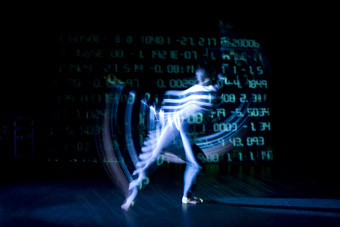
Metadance
photo Jon Green
Metadance
Metadance has four dancers within a sea of floating and spinning text which codes music and avatars. As with Merce Cunningham’s Biped (1999), Parrott uses the X-Y-Z coordinates so generated to devise the choreography. Nevertheless, the movement remains recognisably hers. Hidden amongst translucent screens bearing rows of letters and grids, dancers under spotlights mark a constrained area with taught precision and line. Full limb extensions are common. Although each body often crouches low with one leg moving out at 30 degrees under the hips while the other bears the weight, aggressive twists or bends are rare. The dance retains Parrott’s sense of lyric control and clarity. Mustard’s music is less characteristic, departing from his 1980s MIDI palette to create a weft of ringing metallic strikes echoing away eternally, radiophonic quotations (a French vaudeville song for the juggling interlude, complete with projected balls), shuddering percussive fields and whining tones.
Recording Angel is the most impressive of the trilogy, simplifying and extending Metadance. Dancer Joshua Mu perches, birdlike, head down, arms spread, barely visible under tints of blue, posed beside his virtual double. The separation between live performer and avatar is blurred, both defined by slight glows within an ill-defined space. The measured choreography also imparts a sculptural feel, challenging not only distinctions between body and projection but dance and installation. It is often hard to see the movement. This is combined with Martin Tellinga’s music, recorded so well that, even in stereo, it sounds like its windy sheets and angry shimmering textures are charging behind us. Beyond narrative, meaning, or choreographic or dramaturgical evolution, Angel is a durational, experiential piece, affectively holding spectators in a profoundly sensual yet indeterminate fashion. As such, it avoids clichés of oscillating between technological visions of Frankensteinian disaster or naïvely utopian transcendence, to suggest a state neither liberating nor oppressive, yet intensely affective.
Perth International Arts Festival 2008: Black Swan Theatre Company with Bunuba Films, Jandamarra, writer Steve Hawke, director Tom Gutteridge, associate director, performer Ningali Lawford-Wolf, musical director Paul Kelly, designer Zoe Atkinson, lighting Andrew Lake, projected animations Kaylene Marr, Clancie Shorter, performers: Margaret Mills, Jimi Bani, Geoff Kelso, Emmanuel Brown, Tony Briggs, George Brooking, Simon Clarke, Peter Docker, Danny Marr, Kelton Pell, Dennis Simmons, Kevin Spratt, Sandra Umbagai-Clarke, Perth Convention Centre, February 9–23; Tero Saarinen Company and the Boston Camerata, Borrowed Light, choreographer, performer Tero Saarinen, musical director Joel Cohen, design & lighting Mikki Kunttu, costumes Erika Turunen, sound Heikki Iso-Ahola, His Majesty’s Theatre, Feb 27–Mar 1; Metadance In Resonant Light, choreography Chrissie Parrott, lighting/projection Jonathan Mustard, performers Joshua Mu, Sharlene Campbell, Sally Blatchford, Jacqui Claus. PICA, February 14–21
RealTime issue #84 April-May 2008 pg. 34
© Jonathan Marshall; for permission to reproduce apply to realtime@realtimearts.net
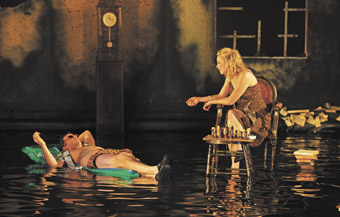
Chris Ryan, Meredith Penman, Chekhov Re-cut: Platonov
photo Jeff Busby
Chris Ryan, Meredith Penman, Chekhov Re-cut: Platonov
THE ANXIETY OF INFLUENCE, TO HIJACK HAROLD BLOOM’S TERM, IS PROBABLY MOST EVIDENT WHEN IT BESETS AN EMERGING DIRECTOR. YOU KNOW THE SORT—THE YOUNG TURK WHO WANTS TO REINVENT THEATRE, BREAK THE MOULD, SHAKE OFF THE SHACKLES OF AN ARTFORM OSSIFIED INTO RIGID PREDICTABILITY. OFTEN THE RESULT IS A LAMENTABLE MESS THAT MERELY ENDS UP IMITATING OTHER REBELLIOUS THEATREMAKERS WITHOUT BEING CONSCIOUS OF THE TRADITION BEING FOLLOWED. SOMETIMES, THOUGH, THE DELICATE BALANCE BETWEEN AN ORIGINAL VISION AND AN AWARENESS OF HISTORICAL TRADITION MAKES FOR SOMETHING GENUINELY NEW AND EXCITING.
Matthew Lutton and Simon Stone are both 23-year-old directors who have arrived on the stage from different directions. Lutton studied in a now defunct cross-disciplinary program at WAAPA before going on to establish his own theatre company and working as an associate director with Black Swan. Stone, on the other hand, comes from an acting background—the VCA grad’s self-formed company The Hayloft Project features many of his old classmates. And though they evince very contrasting aesthetics, both directors are proving capable of rubbing shoulders with theatre veterans twice their years.
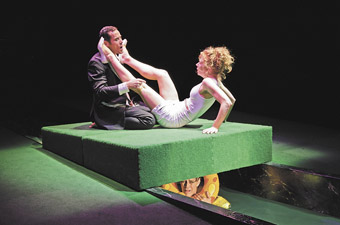
Marcus Graham, Alison Whyte, Barry Otto, Tartuffe
photo Jeff Busby
Marcus Graham, Alison Whyte, Barry Otto, Tartuffe
malthouse’s tartuffe
Lutton stepped in to direct Malthouse Theatre’s first 2008 production, Tartuffe, at (quite literally) the last minute. The assistant director was informed on the first day of rehearsals that Michael Kantor was handing over the reins in order to undergo medical treatment for a coronary irregularity. It’s testament enough to a certain amount of sheer gumption, I suppose, that Lutton didn’t baulk at the announcement but set to work. And though Kantor’s own artistic imprint is still visible in the final work, Lutton brings enough creative license to the piece to finally make it his own.
Tartuffe is freely adapted by Louise Fox after the Molière play of the same name. Where the original was a satirical swipe at the hypocrisy of organised religion and the greed of the aristocracy, Fox’s version is a bawdy, carnivalesque skewering of contemporary Australian mores and misdemeanours. Marcus Graham plays the titular holy roller who infiltrates a wealthy, soulless Toorak family and profits from their moral bankruptcy and desire for the kind of spiritual satisfaction only money can buy. Barry Otto and Alison Whyte are the heads of the vacuous clan, and this trio makes up the central dynamic of the piece.
Lutton’s version pushes the comedy to suitably manic extremes. Like any good sit-com there’s rarely a line that isn’t some kind of gag or a moment without some physical foolery. He makes the most of a lavish set, complete with a long lap-pool, three-level balcony edifice and numerous trapdoors. But where a lesser work would simply devolve into zany clowning and frothy farce, this Tartuffe outdoes itself in a final directorial choice near the work’s end. In Molière’s original, the sudden, improbable intervention of the King neatly resolves the tale. Translating this into a more interesting contemporary parallel was always going to be difficult, but Lutton’s decision is a stroke of brilliance. Where much of the production is an hysterically amplified take on the real world of today, Lutton’s Tartuffe climaxes with the hilarious entrance of Jesus in robes and beard, arriving to set all aright. Rather than undoing the cop-out of Molière’s deus ex machina ending, Lutton turns it up a notch to go beyond satire into something approaching meta-theatre, exposing its own internal cracks as much as those of the flawed characters it has so far ridiculed.
hayloft’s platonov
Simon Stone’s Chekhov Re-cut: Platonov takes the early work by the canonical playwright and treats it with the irreverence one would expect from an emerging talent. This is only Stone’s second production—the first, Spring Awakening (to be seen in June at Belvoir Street in Sydney), was an equally riveting work, and Platonov continues his trajectory. It cuts and shuffles Chekhov’s sprawling five-hour play to less than half that. It updates the setting, to a point, to lend it both a contemporary relevancy and a generous respect for its source. And, visually, it’s a beautiful gift to its audience.
Platonov is a liberal misanthrope, an existentially despairing tragic who turns his bleak desolation on the humans around him. Numerous affairs and betrayals seem to entertain his love of power games, but when the precarious house of cards he gradually builds brings about his ruin the audience must ask whether this self-destruction was in some way willed. He’s certainly not a sympathetic figure at any turn, but he is a fascinating one.
In Stone’s hands Platonov, like Spring Awakening, is very much an actor’s piece. The performers are given full rein to explore and embellish characters with gusto, and each proves more than capable. There’s plenty of stage business making full use of the space, but this adds a tactile dynamism and energy to the work rather than appearing contrived or unnecessary. With the exception of a superfluous second-half opening in which the feverish Platonov is beset by a ghostly chorus of his peers, the production aims for heightened realism instead of heavy-handed symbolism or obvious directorial intrusion. Most encouraging of all, it’s a realism that meshes perfectly with theatricality, too often seen as exclusive opposites.
Evan Grainger’s set is a sure contender for a swag of accolades. The entire playing space is flooded with black, rippling water fringed by shattered and burnt walls; piles of mouldy books and decaying antique furniture jut from the water like lilies. A subtle lighting design creates a warm and cloying sense of brooding intimacy which shimmers as the performers wade, splash or retreat from the pool.
Simon Stone, like Matthew Lutton, displays a powerful ability to reinvent an old work, making that reinvention the point of the exercise. Both bring an understanding of and respect toward their respective sources while remaining unafraid to depart from them in order to produce a superior work. Are you paying attention, class?
Malthouse Theatre, Tartuffe, writer Molière, adaptation Louise Fox, director Matthew Lutton, performers Laura Brent, Marcus Graham, Francis Greenslade, Peter Houghton, Rebecca Massey, Barry Otto, Ezekiel Ox, Luke Ryan, Alison Whyte, designer Anna Tregloan, lighting designer Paul Jackson, composer Peter Farnan; CUB Malthouse, Feb 15-Mar 8; The Hayloft Project, Chekhov Re-cut: Platonov, writer Anton Chekhov, adaptation, direction Simon Stone, performers Jessamy Dyer, Amanda Falson, Angus Grant, Adrian Mulraney, Eryn-Jean Norvill, Meredith Penman, Chris Ryan, Simon Stone, designer Evan Granger, lighting design Danny Pettingill, sound Jared Lewis; The Hayloft, Footscray, Melbourne Feb 27-Mar 16
RealTime issue #84 April-May 2008 pg. 36
© John Bailey; for permission to reproduce apply to realtime@realtimearts.net
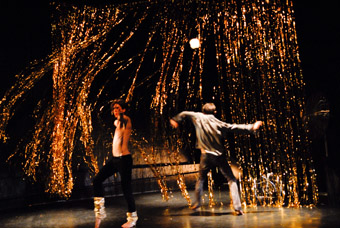
Alex Grady, Matthew Prest, The Whale Chorus
JANIE GIBSON’S THE WHALE CHORUS IS MYSTERIOUS AND CHAOTIC, A DREAM MUTATING INTO NIGHTMARE AMBIGUOUSLY HOSTED BY A YOUNG WOMAN (GIBSON) IN DARK WEIMAR CABARET PERSONA, ACCENT AND ALL, A SET OF TRULY EERIE TALES AND, IN THE CLIMAX, SPECTACULARLY STAGED SUPERNATURAL POWERS OUT OF THE MATRIX AND THE RING CYCLE.
Two competitive young men (Matthew Prest, Alex Grady) prance about like centaurs, revealing their love-lorn inner states via intensely delivered pop songs; two women (Phoebe Torzillo, XX) engage in more gnomic behaviour, sometimes gratingly cute but also tinged with dark prophecy.
Like the vigorous, ambitious ensemble dancing, the production constantly threatens to fall apart. Save for Gibson’s disturbing, blackly comic tales the writing is thin, the other female roles limited and the production’s grand symbolism opaque.
As a director Gibson is courageous, her vision reminiscent of Melbourne playwright Lally Katz’s anarchic theatrical magic but, unfortunately, there’s little sense of The Whale Chorus being through-written. Nevertheless the production proved oddly memorable. Alex Grady is a subtle presence, Gibson has a magnetic, quiet intensity, and Prest a vibrant nervous energy. Above all it was exhilarating to see a young ensemble performing with total commitment.
The Whale Chorus, director Janie Gibson, performers Alex Grady, Matthew Prest, Phoebe Torzillo, XX, Janie Gibson, sound James Brown, costumes Lucy Thornett, magic maker Michaela Gleave, lighting designer Frank Malnoo; PACT Youth Theatre, Sydney, Feb 28-March 9
RealTime issue #84 April-May 2008 pg. 36
© Keith Gallasch; for permission to reproduce apply to realtime@realtimearts.net
REACH INTO YOUR POCKET AND BRING OUT YOUR WALLET. YOU DON’T RECOGNISE THIS WALLET. REACH INTO YOUR BAG AND BRING OUT YOUR MOBILE PHONE. YOU DON’T RECOGNISE THIS MOBILE PHONE. LOOK AT THE NAME ON THE PIECE OF PAPER YOU’RE HOLDING. YOU DON’T RECOGNISE THIS NAME. IS THIS A NIGHTMARE OF LOSS OR A FANTASY OF FREEDOM? EITHER WAY, IT WAS THE EXPERIENCE OF PARTICIPANTS IN LIFE EXCHANGE, A PROJECT ORCHESTRATED BY BERLIN-BASED ARTISTS WOOLOO PRODUCTIONS.
Between October 31 and November 6, 2007, 10 people were sent blinking into the streets of New York with just a stranger’s possessions to guide them. Martin Rosengaard and Sixten Kai Nielsen, of Wooloo Productions, interviewed participants who were each willing to swap lives with a stranger and matched them into pairs. The longest exchange took one week; the shortest was 24 hours.
Surely you’d have to be crazy to trust a stranger with your house keys, your credit card, your job, your relationships? Participants didn’t just swap material possessions but also met each other’s lovers, worked in each other’s jobs and (although not in all cases) lived in each other’s homes.
For some, this demand for trust might seem like a nightmarish risk, but Rosengaard says it is one of the project’s strengths. Particularly in America, he says, there is a “performance of distrust” carried out by the state, which encourages people to be suspicious of each other’s motives and exploits an inherent conservatism of fear. In contrast, Life Exchange invited a very un-public display of trust and openness.
In fact, the relationship between two strangers was not the central experience of Life Exchange—after all, they didn’t really meet. One participant, occupying the life of Guilio d’Agostino for a day, found himself flirting with a woman on the subway. Twenty-four hours later he had returned to his identity of Ektoras Binikos, who is gay. Obviously, Life Exchange did not affect Ektoras’ sexuality, but it did encourage him to do something outside his normal experience. Crucially, this change in behaviour was not because Ektoras stole Guilio’s identity, but because for a time he was bereft of his own.
Participants in Life Exchange knew nothing about their ‘new life’ until the moment they inhabited it; and for each piece of someone else’s persona they acquired they lost the corresponding accoutrement of their own—their own mobile phone, their own best friend, their own routine. The process must have seemed more like a loss than an acquisition. In this light, the man who flirted with a woman on that November morning was not Guilio d’Agostino (who knows if he flirts with women on the subway?) or even a performance of ‘Guilio d’Agostino’ (having never met him, how could Ektoras know how to perform?). Instead, it was an anti-performance of Ektoras Binikos—a man whose codes and imperatives of behaviour had suddenly been stripped away.
In a city that was playing host, at the same time, to the dead-eyed ‘re-enactments’ of Alan Kaprow’s Happenings [RT 83, p17] , this seemed like a breath of fresh air. Kaprow wrote scores to encourage people to meditate on the experience of living and to blur the definitions of art and life. But, a year after Kaprow’s death, these re-enactments, watched in a packed warehouse in Long Island, were like the hammy cousins of an art historical moment that was never meant to be played to an audience. In contrast, Life Exchange seemed to promise a very real experience—the “sensory becoming” that Deleuze and Guattari describe as the true effect of a work of art.
But while Binikos found the experience of Life Exchange liberating, the project encouraged self-reflection in a very controlled way. The precedent for Wooloo Productions’ 2007 Life Exchange is Nancy Weber’s Life Swap (1974, written up in a book published by Dial Press in the same year), in which Weber changed lives with another woman. Her swap was precipitated by months of discussion, note-taking and written instructions between the women, but it ended badly with each accusing the other of dishonesty and misrepresentation. Life Exchange, however, removed the possibility of any such accusations, because it took responsibility for the project away from the people taking part.
It was Wooloo Productions (rather than any of the people whose lives were exchanged) who provided legal documents and disclaimers; Wooloo Productions who carried out interviews and made matches; and Wooloo Productions who conducted a Life Exchange Ritual at the beginning of each swap. This meant that ‘exchangers’ were free to concentrate on their personal experiences. And, unlike the earlier project, they could never accuse each other of sabotage, because they didn’t own the processes that governed their behaviour. These processes were owned and issued, instead, by Wooloo Productions.
In other words, Wooloo Productions institutionalised Weber’s model. If Weber’s Life Swap was carried out like two women bartering in a market, then Wooloo’s exchange was more like people ticking ‘yes’ to the terms and conditions on a website. This overt mediation concentrated the experience on each participating individual, but it also rendered them strangely passive in the process. Even when exchanges ended badly—as did one between Jane Harris and ‘Joanna’, cut short after just a few hours—the participants did not blame each other but the institution that had led them there. “Just be forewarned”, says Harris about Wooloo Productions, “they don’t seem to know what they’re doing” (www.artnet.com).
It is this relationship of trust between individual and institution that lies at the centre of Life Exchange. Harris’ disappointment with the project reveals her desire to trust the institution—if ‘they’ don’t know what they’re doing, then who does?
In fact, during Life Exchange Wooloo Productions acted just like the big cultural institutions that govern our lives—what Althusser calls institutional state apparatuses. This similarity even extends to the “performance of distrust” Wooloo’s Rosengaard identified in US federal policy. Like the government’s performance, Life Exchange relied on an entity whose power is hinted at but never explained; participants were even blindfolded during the Life Exchange Ritual that began each swap to reinforce this sense of mysterious power. And, like government performance, Life Exchange demanded casual complicity from its public.
Was Jane Harris right to have doubts about Wooloo Productions? The institutional façade that the organisation erected was flimsy at best. The Life Exchange Ritual, for example, which featured candles and New Age music, was an empty, generic scene such as might appear, Rosengaard says, if you googled the world ‘ritual.’ And unlike US government policy, Life Exchange did not exploit conservatism. Instead, it centred on unpredictability, stripping individuals of their symbols and then leaving them to their own devices.
Life Exchange created a dream of freedom and a nightmare of loss at the same time. It gave its participants liberty from identity, agency and expectations. But in return it enacted a loss of identity, freedom and agency. Creating a mask that borrowed from the familiar processes of big cultural institutions, Wooloo Productions suggested that liberty can only come from the comforting arms of an institution. The question, then, is which institution do you choose? And which liberty?
Wooloo Productions, Life Exchange, New York, Oct 31-Nov 6, 2007
RealTime issue #84 April-May 2008 pg. 37
© Mary Paterson; for permission to reproduce apply to realtime@realtimearts.net
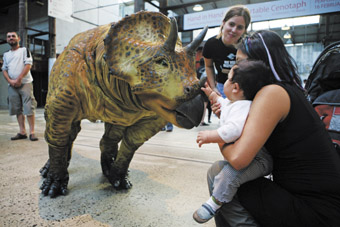
Erth dinosaur, designers Steve Howarth, Bryony Anderson , Chris Covich, Phil Downing, Clalre Milledge, Ferdinand Mana
photo Prudence Upton
Erth dinosaur, designers Steve Howarth, Bryony Anderson , Chris Covich, Phil Downing, Clalre Milledge, Ferdinand Mana
TWO DINOSAURS ROAMED THE VAST FOYER FOR THE JOINT LAUNCH OF THE 2008 CARRIAGEWORKS AND PERFORMANCE SPACE PROGRAMS, A PALPABLY EXCITING MOMENT AFTER THE 2007 SETTLING IN FOR BOTH ORGANISATIONS. THE AMIABLE BEASTS ARE UTTERLY CONVINCING CREATIONS BY ERTH PHYSICAL & VISUAL THEATRE INC, ONE OF THE COMPANIES RESIDENT AT CARRIAGEWORKS.
Like big, slow puppies, the dinosaurs mingled with the large, if surprised crowd, making a brief appearance before leaving for Los Angeles—they were commissioned by the Los Angeles County Natural History Museum. A proud Scott Wright from Erth declares that the creatures are anatomically correct but is at pains to point out, because they’re often asked about it, that the company has nothing to do with the multi-million dollar Walking with Dinosaurs show. Wright is emphatic, these are human-driven body puppets; look, no animatronics!
Festivals at CarriageWorks in 2008 include Platform 1 Hip Hop Festival, Sydney Writers’ Festival, the return of Underbelly public arts lab + festival (after its successful celebration of underground and emerging artists in 2007), the Sydney Children’s Festival and the second Destination Film Festival, curated by Megan Spencer. Synergy Percussion will present two concerts (one of Reich and Xenakis compositions, the other with Swiss drummer Fritz Hauser and sound designer Bob Scott) across the year, and Sydney Dance Company three productions with new works by Meryl Tankard, London based choreographer Rafael Bonachela and New York-based Aszure Barton. The year’s program also includes young experimental theatre company The Rabble in Salome and newly resident company Force Majeure in a return season of their Sydney and Adelaide Festival hit, The Age I’m in.
The Performance Space program is well under way. Soon the space presents Experimenta Playground [RT 81, p34], the biennial of media art, ReelDance Festival 2008 [see page 22], Back from Front, a major new dance work from Dean Walsh [p33] and Branch Nebula’s Paradise City [on its Mobile States national tour after its trip to South America]. In the winter program there’s a new dance work, Ground Up, from Bernadette Walong, inspired by the Rainbow Serpent, the Live Festival of works in development with the special appearance of London’s Pacitti Company, and a life-sized house created by a Matthieu Gallois as part of an installation program titled Makeshift, Suspended House, and Habits & Habitat.
Visual and sound artists David Haines and Joyce Hinterding will present their large-scale sculptural installation, Anechoic Chamber, in the Performance Space’s Spring program. The chamber will be properly anechoic—totally sound-proof and devoid of resonance. Townsville’s Dance North, after their successful collaboration with Splinter Group on the acclaimed Road Kill, will perform Underground (set on a subway in rush hour and slipping into a dream world) and Tess de Quincey [p32] her new work, Triptych, focusing on air, electricity and water and using large projections wrapped around the audience.
It’s a big year for CarriageWorks and Performance Space, offering programs which will maintain continuity, sustain innovation and make the future. The venue will be busier than ever, the new Anna Schwartz Gallery (to open with a major Mike Parr exhibition later in the year) will add yet another dimension to this new home to the contemporary arts. RT
www.cariageworks.com.au
www.performancespace.com.au
RealTime issue #84 April-May 2008 pg. 37
© RealTime ; for permission to reproduce apply to realtime@realtimearts.net
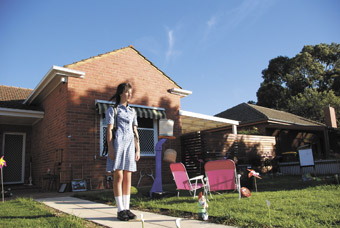
Hard Rubbish
IN A SEARCH FOR INDUSTRIAL RELEVANCE AND NATIONAL PROMINENCE, THE SOUTH AUSTRALIAN SHORT SCREEN AWARDS (SASSA’S) HAVE UNDERGONE A SERIOUS FACELIFT IN THE LAST TWO YEARS. WITH REJIGGED ELIGIBILITY GUIDELINES AND A SLICKER PRESENTATION, THE REMODELLED FORMAT WAS AN APPROPRIATE FORUM TO REVEAL A CORNUCOPIA OF HIGH-CLASS DRAMA, COMEDY, EXPERIMENTAL FILM AND ANIMATION, AND TO SHOWCASE A TALENT POOL RICH IN TALENT. WHILE THE VENEER OF GLITZ MADE THE OCCASION INTERMITTENTLY FEEL SLIGHTLY OUT OF STEP WITH THE REALITY OF SHORT FILMMAKING, THE SASSA’S ARE NOW ELEVATED TO A FAR MORE MEANINGFUL STATUS IN THE CONTEXT OF THE WIDER INDUSTRY.
This year the eligibility guidelines were broadened to allow professional filmmakers to enter—which was always a grey area to police anyway—and has ultimately shifted the SASSAs away from being grassroots encouragement awards to a wider celebration of the South Australian industry. It did mean students were competing against hard bitten veterans with feature credits, but within this mix the 2008 awards managed to maintain a natural leaning toward the underdog and the previously unrecognised as well as a convivial and supportive atmosphere.
While there were many examples of technical excellence throughout the craft and genre awards, perhaps it would be felicitous to focus on the Best Film category, as the nominees provide a representative topography of the South Australian filmmaking community. The landscape is divided into quality higher end dramas financed by state and federal agencies (Spike Up, Swing), self-determined independently financed work (You Better Watch Out, Hole in the Water) and films by emerging talent in conjunction with local screen development agency the Media Resource Centre (Hard Rubbish, Caught in a Loop).
With a decision that defied the AFI Awards jury verdict of last December, Anthony Maras’ crime drama Spike Up did not walk away with the Best Film prize. Instead it went to the dark commercial comedy You Better Watch Out, directed by Steve Callen. Privately funded, and with the presence of Stephen Curry, Dan Wylie and Chris Haywood in the cast hinting that the level of entrepreneurship was high, You Better Watch Out tells the tale of two oafish brothers kidnapping a department store Santa under the delusion he is the genuine article, with the intent to extract revenge for their miserable childhoods. What hoists the piece above the Tropfest-style one-gag film is the polished production values and the droll investigation into belief systems. Callen also picked up the Best Screenplay award.
It is easy to see why Spike Up has been well recognised nationally and is already pushing into the international festival arena. An excellent Roy Billing plays a hapless cop whose day, involving the capture of a drug mule, a reunion with an old friend and shifting domestic fault lines, escalates towards a confronting revelation. Delivering assured direction and authentic performances, Anthony Maras is a filmmaker whose star is clearly on the ascendant. Aesthetically the hand-held cinematography manages to be unobtrusive while combining well with an under-lit, steel blue hue that faintly accents some of the interiors. Maras won Best Direction, and the film Best Drama.
Christopher Houghton’s Swing fits squarely in to the coming-of-age drama category, but does so in an emotionally engaging way. A Vietnamese-Australian teenager striving for independence from her family lands a job as a domestic for a blind Vietnam War veteran. The contrivance works through subtle narrative drive and the strong rapport between first time actor Vi Nguyen and the vastly experienced Chris Haywood. Nominated in multiple categories, Swing was unlucky not to collect any awards on the night. [It premiered at the Adelaide Film Festival in 2007, won the Audience Award for Best Short Film, and at the St Kilda Film Festival won Best Short Film and $10,000. Ed]
Refreshingly unbound by convention, Dimitrios Pouliotis’ Hole in the Water is a deeply meditative, enigmatic and at times frustrating piece. In an extended short at 29 minutes and bereft of dialogue, a man suffering from a terminal disease faces up to his own mortality. Whilst the Tarkovskian pacing and straining for philosophical resonance occasionally misses the mark, the striking compositions and choreography of the camera do last in the memory. Well-articulated pastel neon light slices through the frame with powerful effect, and the protagonist’s desolate dreamscapes are vividly rendered. The opening shot, gliding in extreme close up along a river’s surface to pull wide and reveal a rowboat engulfed in flame, is indicative of the production. Aaron Schuppan beat a vastly more experienced field to take home the Best Cinematography award.
Sarah CrowEst also had a more abstract approach in her Caught in a Loop, a series of black and white vignettes of actors lip-synching to recorded personal testimonials of obsessive-compulsive behaviour. The result is bittersweet and humorous, a mood piece rather than narrative driven, yet accessible enough to make the final 16 of the mainstream Tropfest competition. A well executed concept, it was a deserving winner of Best Experimental Film at the SASSAs.
The brightly designed Hard Rubbish, directed by Adam Lemmey, a cheerful and slightly twisted comedy about an 11-year-old girl who throws out her embarrassing family with the rubbish, rounded out the nominees. Its multiple nominations across nine categories reflects the consistent class across all elements of its production, despite not picking up a specific prize (though Director of Photography Maxx Corkindale won the Best Young Filmmaker Award). Although veering toward cutesy, the film’s climax subverts the general sentimental expectation.
It appears that in finally changing the SASSAs to allow an open field while maintaining a nurturing tone, the presenting organisation, the Media Resource Centre, has struck on a formula that reflects the structure and idiosyncrasies of the South Australian industry itself. The mutual support and tight networks on display here should further help the substantial creative talent blossom further in the short-term future.
SA Short Screen Awards, Mercury Cinema, Adelaide, March 6, www.mrc.org.au
RealTime issue #84 April-May 2008 pg. 26
© Sandy Cameron; for permission to reproduce apply to realtime@realtimearts.net
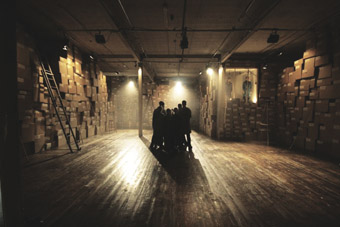
Tenderness: Ugly
photo Marg Horwell
Tenderness: Ugly
THE FIRST DETAILS I NOTICE UPON ENTERING THE PERFORMANCE SPACE AT 45 DOWNSTAIRS ARE LABELS CONTAINING KIDS’ NAMES ON CARDBOARD BOXES STACKED 10 DEEP THAT TOTTER TOWARD THE CEILING. IN PLATFORM YOUTH THEATRE’S DEPICTION OF THE COLLISION BETWEEN ADOLESCENT DREAMS, HORMONE PUMPED DESIRE AND THE DULL THROB OF ADULT LIFE, GOOD KIDS EXPECTED TO REACH GREAT HEIGHTS WILL SPIN OUT, AND COME CRASHING TO THE GROUND.
Tenderness, created from reseach with young people from Melbourne’s northern suburbs, consists of two plays residing at opposing ends of the gender equation, but both tell a similar tale. In Ugly by Christos Tsiolkas, Slim drops out of school, realising it has no place for him, nor he for it, in his dream of becoming a prizefighter. In this righteous rush of blood he fails to realise that the relationships formed in the schoolyard will continue to permeate his young life. In Slut by Patricia Cornelius, free thinking Lolita fucks everything that moves, instinctively responding to a diffuse sexuality that is at once admirable in its honest expression of unconditional love, but will be judged by her schoolyard peers as the immoral behaviour of a nymphomaniac.
Slim loves his girlfriend Sil with a vengeance. But his recently acquired lifestyle of dropping eccies and planting the porpoise no longer adheres to Sil’s father’s career-directed intentions for his daughter. Frustrated, Slim fractures the skull of a taxi driver and is set to suffer the consequences. Conversely, Lolita is pack-raped at a party by a conga line of quivering phalluses, and is only ever capable of maintaining destructive relationships characterised by violence and self-abuse. Like the theatre itself, it is during moments of transition between two worlds that Slim and Lolita experience the helplessness derived from standing up for your beliefs in a world that couldn’t care less. This irony synthesises the two plays, Slut and Ugly, into the one performance, Tenderness.
The grand finale is a striking suggestion of the possibilities of theatre as installation, and an underlining of this show’s curious moral code. Cardboard boxes are bustled away, revealing a split level glass case. Slim, naked and sexually shamed, sits crouched in what might be a prison cell. Above, Lolita’s suspended form is frozen in a sustained and terrified scream. Combined, this iconography presents as an image of the Crucifixion, and even though such a compelling visual statement must have proved irresistible to its creators, it struck me as an affirmation of the same Christian morality which has prompted Slim and Lolita’s sad decline. That is, until my sight is drawn towards blind performer Maysa Abouzeid and the collapsible cane she has carried throughout her performance, reminding me of a line from a Judith Wright poem, of a “Blind head butting in the dark…” Abouzeid’s presence suggests a less sanctimonious metaphor for the invisible terror arising out of adolescence, and a curt reminder of what the theatre is really about. Acts of courage in the face of enormous adversity, performed by communities not crying out for God, just simple moments of tenderness.
Platform Youth Theatre, Tenderness: Ugly, writer Christos Tsiolkas, Slut, writer Patricia Cornelius, director Nadja Kostich, performers Luke Fraser, Camille Lopez, Anastasia Babboussouras, Chloe Boreham, Maysa Abouzeid, designer Marg Horwell, lighting, Richard Vabre, sound Kelly Ryal, choreography Tony Yap; 45 downstairs, Melbourne, March 7-15
RealTime issue #84 April-May 2008 pg. 38
© Tony Reck; for permission to reproduce apply to realtime@realtimearts.net
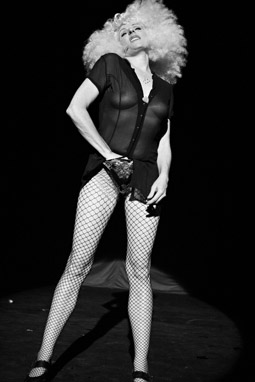
Victoria Spence, Quick & Dirty
photo George Voulgaropoulos
Victoria Spence, Quick & Dirty
OUR HOST CANDY (VICTORIA SPENCE) DESCENDS THE STEEP AISLE, GREETED BY GREAT APPLAUSE. SHE’S “EMERGING FROM 12 LONG YEARS” THAT HAS INVOLVED SOME “DEEP UNDERCOVER WORK CALLED MOTHERHOOD.” BUT NOW SHE’S BACK. IT’S BEEN NINE YEARS SINCE TABOO PARLOUR, ITSELF A SUCCESSOR TO THE LEGENDARY CLUB BENT, APPEARED DURING MARDI GRAS AT PERFORMANCE SPACE, AND FINALLY QUICK AND DIRTY HAS ARRIVED TO FILL THE VOID.
With public acknowledgment of the collective responsibility of Australians for the past now firmly embedded in the national zeitgeist, Spence fittingly acknowledges the traditional Indigenous owners of the land on which tonight’s performance takes place. As she does so, she points also to the struggles for recognition of queer identities, thus framing Quick and Dirty as a gathering of disparate tribes who “continue to weave stories of love, respect, and resilience.” Her opening address received an enthusiastic cheer from the capacity crowd, and established the event as part remembrance, part celebration and part community affirmation all wrapped up within two sprawling nights of performance from a truly diverse range of queer-identified artists.
Each night’s program began with the amiably anarchic foyer carnival of Biffo’s Blow Up Bonanza, featuring an inflatable peepshow and various sideshow acts competing with loud audience chatter. More contemplative in tone were the concurrent durational performances. On Friday, Fiona McGregor’s Borne saw the artist laid out in a coffin, her naked body covered by layers of small gifts that the audience was invited to take. The quiet reverence of the installation was a welcome contrast to the chaos outside, but the effect was somewhat ruined by front of house staff persistently reminding audience members who chose to linger that this was a “durational piece”, and that once we’d taken our gift (a neatly wrapped packet of seeds), we should take our (quiet) conversations back outside. Saturday saw the exquisite intimacy of Sarah-Jane Norman’s Songs of Rapture and Torture (#1: Surabaya Johnny). After a long wait to be singly admitted, I entered to find Norman sitting naked, blindfolded and elaborately bound to a chair, singing huskily in German into a microphone dangling from the ceiling. Clearly, I’d arrived in the middle of some ordeal. After about five mesmerising and strangely anxious minutes, the door opened and I was politely ushered out. Norman continued to sing, lost in a private world of loss, pain and resignation. Despite the brief encounter, the powerful image lingered.
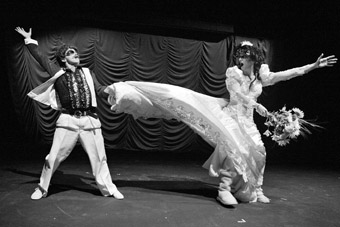
Gwenda & Guido, Quick & Dirty
photo George Voulgaropoulos
Gwenda & Guido, Quick & Dirty
Friday’s in-theatre acts included Trash Vaudeville’s restaging of his 1999 one-off Fool’s Gold using his original video animations. As the images progress he tries to remember what the piece was about, throwing himself from one pose to another, never seeming to recall what happens next. It’s an amusing, if rambling, exercise in media and memory, pointing clearly to the failures of both, but still managing to maintain its sense of humour even as the performance falls apart. This followed the amazing, crimson Chewbacca-esque creature and giant lolly-strewn stage of Buzz’s A Cavity Calamity, which unfortunately failed to provide much interest beyond its extravagant costuming. In The Invisible Woman from Outer Space, Glitta Supernova and Sex Intents presented a cosmic, ultraviolet strip tease, with the performer’s body disappearing as her fluorescent clothes flew away, seemingly of their own accord, culminating in a tiny rocket ship blasting off from her arse. Topping this, the highlight of the night was Gwenda and Guido’s White Heading, an outrageously bizarre Elvis-themed, whip cracking, cream-spraying, cake-eating, candle-inserting romp—sexy, funny and just plain wrong.
Saturday’s program was equally eclectic but far stronger overall. Wife’s Untitled began with a literally unravelling striptease, as a cunningly designed garment fell away forming a single thread. The piece ended with the viscerally discomforting removal of another thread, this time one stitched into the performer’s chest and examined in extreme close-up on video. Matt Hornby, Matt Stegh and Tristan Coumbe’s The Axis of Evil spectacularly queered the War on Iraq with production values to die for—breathtaking costume changes complete with decorated erect rocket penises, thrilling deathly dance routines, and satanic cameos. But the night belonged to The King Pins, whose Mystic Rehab was surely the ultimate in lip-syncing drag performance—performed with dazzling skill and energy, imaginative musical montage and stunningly excessive costumes that combined to produce a jaw-droppingly hilarious spectacle to send us all home wanting much much more. Let’s hope that we don’t have to wait another nine years for Quick and Dirty 2!
Performance Space, Sydney Gay & Lesbian Mardi Gras 2008: Quick and Dirty, coordinator Victoria Spence, lighting designer Clytie Smith, producer Fiona Winning, CarriageWorks; Sydney, Feb 22-23
RealTime issue #84 April-May 2008 pg. 39
© David Williams; for permission to reproduce apply to realtime@realtimearts.net
A LARGE SCREEN UPSTAGE DISPLAYS A SILENT SKY, CLOUDS SKIMMING BELOW, THE COLOUR LIKE THE “BLUE SCREEN OF DEATH” THAT COMPUTERS DISPLAY BEFORE CRASHING. AS CHIKA HONDA: A DOCUMENTARY PERFORMANCE UNFOLDS IT BECOMES INCREASINGLY CLEAR THAT THIS COLOUR IS UNCANNILY APT, FOR THE ARREST, PROSECUTION AND INCARCERATION OF HONDA IS THE STORY OF A SYSTEM MALFUNCTIONING AND A LIFE CRASHING AS A RESULT.
The eponymous Chika, a Japanese tourist who was jailed for over a decade for allegedly importing heroin into Australia, emerges through a collage of images and interviews, live music and movement. Most of the images are stills taken by the show’s producer, photographer and narrator Mayu Kanamori, who regularly visited Honda during her imprisonment and who sits on a stool in front of a microphone for the duration of the performance. Other images include archival footage of the initial police interview and media coverage of the court case. Supplementing Kanamori’s verbal and visual narration are the recorded voices of Honda herself as well as her various supporters. When words fail, Tom Fitzgerald’s evocative music and Yumi Umiumare’s dramatic movement take over; together they gesture towards an angst that lies beyond language.
The storytelling is simple and effective, though perhaps not as self-revealing or self-reflexive as it might be. Unlike, say, William Yang, another documentary photographer who tells personal stories with a wide social significance, Kanamori does not include herself. Even when she admits that she crossed a line from photographer to friend, she does not pause to reflect about why this might have happened, what it might mean, and how it might impact upon the performance. Indeed, between her modest storytelling and Malcolm Blaylock’s minimalist staging, the show seems to shy away from the possibilities of performance. Umiumare aside, the stage is strangely static and the aesthetic more televisual than theatrical. It is as if by minimising its theatricality, the show seeks to legitimate its veracity but in doing so it displays a paradoxical ambivalence towards performance. Even as the creators seem to trust the medium of theatre to convey the truth, they distrust, and even discard, theatre’s more inventive and imaginative methods.
Whatever its implied attitude to performance, the work is rightly adamant about the injustice done to Chika Honda. Throughout the play, the performers are positioned around the edges of the stage, leaving a black hole at the centre, symbolic perhaps of the hole in Honda’s life, her heart, our hearts and, most of all, our justice system. The show ends with Honda’s enigmatic refrain: “Mum is Mum. I am I. I am Chika Honda.” Even though she has returned to Japan, the injustice done to Chika Honda still haunts us and, the show implies, will continue to do so until our legal system produces another type of documentary performance altogether, the one that clears her name.
Chika: A documentary performance, creator, narrator Mayu Kanamori, director Malcolm Blaylock, musical director, composer Tom Fitzgerald, documentary sound Nick Franklin, shakuhachi Anne Norman, koto Satsuki Odamura, lighting design Keith Tucker, dancer, choreographer Yumi Umiumare, taiko drums Toshinori Sakamoto, sound design Andrei Shabunov, Performance Space at CarriageWorks, Mar 5-8
RealTime issue #84 April-May 2008 pg. 39
© Caroline Wake; for permission to reproduce apply to realtime@realtimearts.net
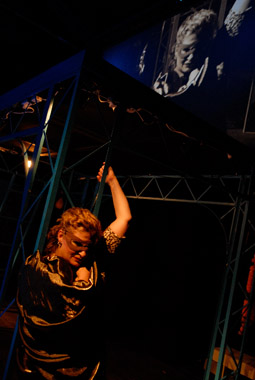
Chris Murphy, Fearless N
photo Heidrun Löhr
Chris Murphy, Fearless N
A POSSIBLY OBSCURE THEME GIVES WAY TO FUN AND FRIVOLOUS THEATRICAL FARE IN THEATRE KANTANKA’S LATEST PRODUCTION, FEARLESS N. BASED ON FEARLESS NADIA, THE ALTER-EGO OF AUSTRALIAN-BORN MARY EVANS, WHOSE UNCONVENTIONALLY STRONG FIGHTING PROWESS AND STURDY PHYSIQUE TRANSFORMED THE ROLE OF WOMEN IN THE BOLLYWOOD FILM INDUSTRY C1950, FEARLESS N TRACKS A REMARKABLY HIDDEN HISTORY—BEGINNING, INTERESTINGLY, ON A DISPLACED BOLLYWOOD FILM SET PLONKED IN THE MIDDLE OF HOMEBUSH BAY.
Enter to tabla drumming and a warm waft of heady incense. Ahead is a shrine-cum-props table, replete with all manner of East Indian paraphernalia. To the right is the pathway for us ‘extras’ to be herded—a role the audience will play to delightful effect throughout the performance. Above the stage sits a film director (Georgina Naidu) who calls the clamouring set to order with humorously intoned requests for singing extras, soldier extras, cowboy extras and dying extras, who should—if asked to die—“please do so without making a fuss.” Naidu’s timbre establishes the self-referential tone that is to underpin our journey: an interpretation of Nadia’s rise to fame through the theatrical contrivance of documenting the story as a Bollywood film. The production hence draws on the tropes of a film genre that is possibly more at home in the theatre itself—using melodrama as the key, farcical connection between the two forms. At the same time, it dips into the politically incorrect giving Fearless N a self-knowing wryness amidst its busy east/west references and marking a “postcolonial field” that even the director admits is “getting pretty crowded.” (Director Carlos Gomes himself appears comically from time to time in a sari as a prostrate beggar with a baby pram).
The production’s most amusing contrivance is its employment of voiceover and live camera work to conjoin disparate stage sequences into the semblance of a ‘real’ cinematic image, projected above the stage action in appropriate sepia tones. Nadia (Chris Murphy) strangles pin-stripe suited villains on top of a moving train (read: Nadia stands above a projection of a moving train and wobbles appropriately); Nadia beats up lazy cowboys who are comically instructed to end their death-fight in the ‘much better’ formation of a human pyramid; Nadia launches into the fight by swinging tarzan-like from a rope, and later, we see her emerge bedecked for a true Bollywood dance-style wedding. At times, the effects are especially revealing, as in a car ride sequence that is generated by a cardboard chassis jiggled in front of a projected moving street scene. Similarly, ‘extras’ dressed as female colonials are given iced tea to sip while their actions are overwritten by suitably plummy voiceovers and a palm-leaf fanning boy behind them.
The text, written by Noelle Janaczewska, offers the potentially awkward theatrical device of an onstage director as narrator, but this actually works well to get a jam-packed story out with ease. At times, there are glimpses of Janaczewska’s signature writing style—a spare prose with tightly spun metaphors that evoke internal character states. This kind of craft is almost out of place in the overall spectacle of Fearless N, but gives it grit and hints at the underbelly of a life that this biography didn’t reveal. The lightness of the production sometimes pushed the narrative into pure parody, and yet the darker textual moments and the question of historical reference hovered temptingly over the work. My desire for real footage of Nadia amidst all of the fakery suggests that Kantanka’s version might just be the first take on a story with more riches to reveal.
Theatre Kantanka, Fearless N, writer Noelle Janaczewska, director, designer Carlos Gomes, performers Rakini Devi, Annette Madden, Chris Murphy, Georgina Naidu, Parth Nanavati, Ahilan Ratnamohan, Rajan Thangavelu, Bruno Xavier, Carlos Gomes, vocalists Ankita Sachdev, Sarangan Sriranganathan, composers Bobby Singh, Ben Walsh, video Andrew Wholley; Sydney Olympic Park, March 7-23
RealTime issue #84 April-May 2008 pg. 40
© Bryoni Trezise; for permission to reproduce apply to realtime@realtimearts.net
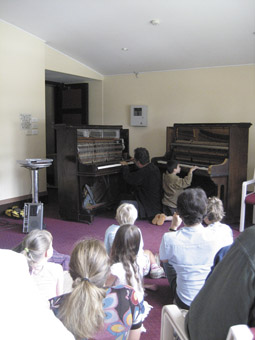
Ross Bolleter, Ruined Piano workshop
photo Shannon O’Neill
Ross Bolleter, Ruined Piano workshop
TAKING THE OPPORTUNITY FOR CHANGE AND RENEWAL, THE ORGANISERS OF THE 2008 NOW NOW FESTIVAL CHOSE TO MOVE THE EVENT FROM “THE POLLUTED, CONFINED SPACES OF SYDNEY’S EXPERIMENTAL MUSIC GHETTOES”, AS THE ANNOUNCEMENT PUT IT, AND “TAKE A DEEP BREATH AND RELOCATE TO WENTWORTH FALLS IN THE BLUE MOUNTAINS.” THIS WASN’T ENTIRELY SURPRISING GIVEN THAT THE AREA IS HOME TO MANY ARTISTS AND MUSICIANS, INCLUDING SEVERAL NOW NOW REGULARS.
The NOW now festival began in 2002 as the brainchild of Sydney improvising musicians Clare Cooper and Clayton Thomas and steadily built a reputation as Australia’s key improvised music event, attracting increasing numbers of local and international musicians and audience members each year. With the founders’ relocation to Berlin last year, the festival’s future might have been in doubt, however the NOW now has always been a community as much as an event, with various members involved in its organisation. This year the three-day festival was run by Jim Denley, Peter Farrar, Monika Brooks, Alex Masso and Dale Gorfinkel.
Booked to perform with the Splinter Orchestra, I arrived at the Wentworth Falls School of Arts on the Saturday afternoon in time for the instrument building workshop for kids and found a hall full of children making a joyful cacophony with a huge collection of bizarre devices. Facilitated by mechanical masterminds Rod Cooper, Dale Gorfinkel and Robbie Avenaim, this was no Wiggles concert!
Clearly this festival was going to be different. Instead of focusing only on evening concerts, there was a packed program of activities, day and night. Alongside the familiar faces were hippies, parents with children, and the elderly. The local community was curious and keen.
Saturday’s events included an all-too-rare appearance by extraordinary vocalist Jo Truman, as well as entertaining interventions by sound poet Emmanuelle Pellegrini on a howling telephone and Brendan Walls in the carpark with his sound art meets Mad Max routine.
On Sunday, after a late night of hanging out and listening to experimental jams at the crowded artist-run space Akemi, a former shop in Medlow Bath which served as the festival club, I returned to the School of Arts at midday for Ross Bolleter’s presentation on ruined pianos. While similar in sound to John Cage’s prepared pianos, ruined pianos are in a sense extremely unprepared, in that they have been neglected to the point of disrepair. Bolleter, who had performed the previous night with Jon Rose, provided fascinating insights into these peculiar instruments. He explained how many of them had washed up on the West Australian coast after being discarded from ships, and he demonstrated performance techniques while sitting on the floor, pointing out how the faulty keys, or ‘non workers’, provided important negative space for the music. He concluded by inviting children from the audience to join him in playing two ruined pianos.
Anthony Magen’s sound walk to Wentworth Falls was squeezed into the program, having been postponed from the previous day due to rain. I tagged along for a while before dropping back to make some recordings of the river and insects, then headed back to the venue in time to see an odd performance by Sam Dobson (double bass), Peter Farrar (saxophone), Alex Masso (percussion), Simon Ferenci (trumpet) and Yusuke Akai (guitar). Commencing with extremely loud bursts of noise that had small children running from the room, the volume control was finally located and the group began to find its way. The players eventually left the room to explore different parts of the building. A ritualistic sound developed, with repetitive drumming and strumming on a single chord augmented by winding saxophone. The performance ended with most of the musicians at the bottom of a stairwell, with the audience watching from above.
Next up was the Melbourne duo of Carolyn Connors and Rosalind Hall whose theme seemed to be the use of different materials to modify sound. Hall plays saxophone with custom reeds. Connors, known for her extended vocal techniques, sang with her face pressed against sheets of aluminium foil and plastic wrap, in a manner that was both humorous and disturbing. The duo produced a range of small, breathy, buzzing, yelping and squeaking sounds, while working their way through the selection of objects on the table behind them.
After a dinner break, the evening’s music began with Metalog, a new group comprising Amanda Stewart (voice), Jim Denley (flute and sax), Ben Byrne (laptop), Natasha Anderson (recorder and laptop), Dale Gorfinkle (vibraphone) and Robbie Avenaim (percussion). There was some suggestion that the group might be a successor to Machine for Making Sense, but apart from sharing two members (Denley and Stewart) there was little similarity in sound. A better comparison would be the Splinter Orchestra (with which it also shares members) albeit with less complex textures, but greater definition.
Beginning with portentous rumbling, the sound from Metalog eventually exploded into electrical hissing and sparks. The musicians moved in shifting combinations and layers, sometimes merging, sometimes distinctive. After nearly an hour of sustained concentration the performance ended with what I can only describe as an ambient techno coda. Overall it was a successful debut, and it will be interesting to see how the group develops. Hopefully there will be a greater role for the usually brilliant Stewart, who was barely audible on this occasion.
French performers Mathieu Werchowski (violin) and Xavier Charles (clarinet) stood either side of local laptopper Daniel Whiting for a dense and often melodic set. Whiting’s echoing sample manipulations of strings and voices were well matched by the sliding tones and trills of Werchowski and Charles. After building to a climax the music finished abruptly.
Local hero Joyce Hinterding delivered her trademark crackles, buzzes and whines, sourced from the electromagnetic spectrum. Moving her large hoop antennae through the air to find new sounds, Hinterding delicately layered them into a subtle and gorgeous soundscape. Glitching rhythmic loops emerged and finally faded back into the atmosphere.
Another local group followed. Ora(ra) consists of Matt Earle (electronics), Adam Sussman (guitar, electronics), Rory Brown (double bass) and Rivka Schembri (cello). Their music was quiet and gently ominous, with throbbing sub bass and cello embellished by microtonal drones. The sounds of the doors opening and closing became audible and interesting. I almost fell asleep, exhausted by the festival so far, but hung on to hear the performance conclude with lovely descending bass tones.
There was no question of sleeping through the final act of the festival. Taste of Teeth from Brisbane are like a 1960s/70s freak rock cult—lots of members sporting afros and over-sized sunglasses, men in dresses, and an enthusiastic entourage who dance to anything. The frontman gave a long, rambling introduction as the band prepared behind him, then threw himself across the room repeatedly, doing cartwheels and backflips. The band started up, eventually settling into a propulsive rhythm, with several percussionists pounding away. As I left to catch the last train back to Sydney, I had the feeling that they might keep playing forever.
The NOW now, curators Jim Denley, Peter Farrar, Monika Brooks, Alex Masso and Dale Gorfinkel; Wentworth Falls School of Arts, Jan 18-20, www.thenownow.net
RealTime issue #84 April-May 2008 pg. 41
© Shannon O’Neill; for permission to reproduce apply to realtime@realtimearts.net
LIKE MANY SOUND ARTISTS I WAS GLAD TO HEAR THAT THE AUSTRALIAN NETWORK FOR ART & TECHNOLOGY [ANAT] HAD ESTABLISHED THE EMBRACING SOUND PROGRAM [ESP], BUT ITS OFFICIAL LAUNCH IN DECEMBER AT THE CHAUVEL CINEMA RAISED A FEW CONCERNS.
While I very much appreciated the level of artistry in the live performances by Ian Andrews, Peter Newman and Robin Fox, it was somewhat surprising that a “sound program” could be launched with such an arguably audio-visually dominated program. Nowhere during the launch was mention made of the artists who produce purely acousmatic works.
I found myself looking away from the projected images in order to fully appreciate the intricate textures of the soundtracks of the audio-visual works. Even with eyes closed it was almost impossible not to be dominated by the rhythms of the projected light. While these works would have been perfect for the launch of a new media audio-visual venture, it seemed ironic that ANAT was actually launching a sound program. Does this indicate a lack of understanding of the aural arts?
The difference between sound works and audio-visual ones is clear. Gary Ferrington has written about “creating multi-sensory images for the mind” which allow individuals to become directors of the ‘movie’ in the mind, where no two people have the same imaginary experience (Journal of Visual Literacy, 1993). Sound theorist Douglas Kahn has commented that, historically, “too many matters of concern for artists interested in a more central role for sound were left untreated…it was left to the film and media studies to provide examples of how sound and signification could be approached” (Noise, Water, Meat, MIT Press, Massachusetts, 2001).
Problems with the launch aside, ESP is an important addition to the cultural landscape, providing a much needed virtual meeting space for sound artists. By being truly representative of all sound practices and expanding its vision, ESP could make dramatic and lasting changes to the sound art scene.
I’d suggest one way ESP could assist the scene would be to highlight the need for an ongoing sound arts time slot on ABC Radio. To achieve long term outcomes there is a need for continuity. A dedicated time slot for both broadcasting and commissioning new works would make the ABC more directly accountable for its ongoing commitment to the art form. In 1997, 27 new, innovative sound compositions (roughly 600 minutes) were commissioned by the ABC’s Acoustic Arts Unit. Perhaps this could be used as a benchmark for an initial quota.
Currently, the most noticeable absence on the ABC is of commissioned long-form sound works. This is in contrast to many European public broadcasters and signifies to the international arts community that Australians generally don’t value their acoustic artists. It also sends a strong message to the broader Australian community that sound arts, especially extended pieces, are not a legitimate art form within the broadcasting landscape. It denies Australians the opportunity to experience, explore and engage in this artform’s imaginative acoustic spaces.
To date, one response to the limited space for broadcast sound art has been the ABC’s online initiative, Pool, “an experimental collaborative media creation web space…” similar to You Tube but developed by the ABC and partner universities.
While this is a great way to make publicly available works that the ABC has commissioned and now owns but has no way of or interest in broadcasting, two immediate concerns come to mind. Who finances the creation of new works? Is it left to the artist to raise the capital and if so, does this mean that our national broadcaster no longer feels the need to commission the same quantity of new works? It seems to me that Pool could be a great way to publicly archive experimental works that have been commissioned by the ABC, but it does little to address the issue of new commissions.
Secondly, as Pool operates under Creative Commons (CC) licensing and has no budget to pay artists for the use of their works, the whole project could be seen as merely a marketing opportunity for the ABC where artists give works away for free. As APRA’s Online & Mobile Licensing Manager, Frank Rodi, pointed out in a recent speech, CC licensing limits the artist’s potential income and gives away control over the context in which the artist’s work is used.
Leaving Pool aside and returning to the possibility of a dedicated sound art program on ABC radio, I’d suggest that it be overseen by an independent panel of arts producers and journalists. They would select a series of sound artists to curate the program so that there would be little chance of the same people always getting the commissions and airplay. We would then have an artist-run space reaching a national audience. This approach is similar to that of the Austrian public broadcaster, Kunstradio. I asked the head of Kunstradio if she had ever pulled the reins on a curating artist. She was surprised by the question, “We must represent everyone on our public station…some works I like and some I don’t.”
I’d also suggest that the program presents artists from across the artistic community and not be limited to practitioners with academic backgrounds at a time when universities are influential in the arts. The 2000 Ars Electronica Jury has argued that universities may not be the new cutting edge for innovation in digital music “because the leading edges of 21st century digital music are elsewhere” (Kodwo Eshun, “Forward to the World”, Ars Electronica, http://www.aec.at/en/archives/prix_archive/prixJuryStatement.asp?iProjectID=2603). Guidelines would need to be set to allow for transparency and for equality of airtime distributed among the artistic community.
An ABC dedicated time slot for both broadcasting and commissioning new works would be a step forward for Australia, evolving with the country’s rapidly growing pool of sound artists. So come on ESP, help realise the potential for a thriving sonic arts ecology.
RealTime issue #84 April-May 2008 pg. 42
© Colin Black; for permission to reproduce apply to realtime@realtimearts.net
AUTUMN IT SEEMS IS THE TIME FOR MUSICAL EXPLORATIONS WITH MARCH TO JUNE OFFERING AN IMPRESSIVE AND DIVERSE COLLECTION OF FESTIVALS.
The first Melbourne International Biennale of Exploratory Music 2008 (MIBEM March 28-April 2) has just wrapped up after six days of ‘boundary-expanding’ music made by over 50 Australian and international artists. Curated by the irrepressible duo of Anthony Pateras and Robin Fox the fare ranged from the ‘erotic killcore’ of Passenger of Shit to Stephen Whittington’s interpretation of Triadic Memories by Morton Feldman.
Following hard on the heels of the Adelaide Festival was the inaugural Adelaide Contemporary Music Festival (April 4-8) directed by Gabriella Smart of the Soundstream Contemporary Music Ensemble. The program included compositions by Andrew Ford, Roger Smalley, Tristram Cary, Sofia Gubaidalina, Alfred Schnittke and others as well as the world premiere of a work by Constantine Koukias for the Dutch ensemble Telesto Duo. The Korean Trio d’anche Suave, also made their Australian debut. Smart is already planning her 2009 festival.
Also biennial is the 2008 Aurora festival (April 11- 20) concentrated in Western Sydney with concerts at Campbelltown and Blacktown Arts Centres, Parramatta Riverside, UWS Parramatta Campus and The Joan Sutherland Performing Arts Centre in Penrith. Directed by Matthew Hindson, Aurora concentrates on living composers, and this year’s focus is on the work of Chinary Ung and Michael Atherton. Ung is Cambodian-born but US-based coming to Western classical music in his late teens. His work Aura, exploring the aftermath of Hurricane Katrina will be performed by the soprano duo Halcyon. The same concert will feature Sydney-based Michael Atherton’s Songs of Stone and Silence based on poems by WWII prisoners of War. Atherton’s UtiLity HoRn GrOove, for five utes, DJ, saxophone, double bass, dancers and a gamelan of mag wheels promises to be a highlight. The program also includes concerts by The Grainger String Quartet, percussionist Claire Edwardes with pianist Bernadette Balkus, and the Austrailian premieres of Michael Smetanin’s Micrographia and Steve Reich’s Daniel Variations (also previewing at the Sydney Conservatorium).
After a break in 2007, Whatismusic? returns with a mini one-day extravaganza at CarriageWorks Sydney (April 11). The marathon evening features Dale Gorfinkel, Marco Fusinato, Chris Abrahams and Cor Fuhler, Maxximal Patterrorist (Anthony Pateras and Max Kohane), festival director Robbie Avenaim and a rare Sydney performance by former festival director Oren Ambarchi. Along with leading Italian electroacoustic composer and improviser Valerio Tricoli, highlights will include the full scale laser show from Robin Fox and Miles and Zai van Dorssen’s Feuerwasser — a monumental clash of the elements of fire and water which must be seen to be heard! There’s a Melbourne leg with a concert at the Toff of the Town (April 14 with artists still to be announced) and Noisemaze, a free outdoor public jam at Grace Park, Hawthorn (April 15).
In May it’s the ACT’s turn with the Canberra International Contemporary Music Festival (May 7-18). Under the directorship of Nicole Canham, tango is set to feature with the French ensemble Tango Futur and Elena Kats-Chernin’s Keating Tangos. Other international guests include Iva Bittova from the Czech Republic, Crash Ensemble from Ireland, So Percussion, The Don Byron Ivey Divey Trio, and purportedly the world’s best theremin player Rob Schwimmer, all from the USA. Combined with the Australian talents of Lisa Moore, Jouissance, Topology, Ensemble Offspring, Robyn Archer, Paul Grabowsky, The Sculthorpe Quartet and William Barton, Canberra might just be the place to be.
Once we hit winter Liquid Architecture will tour nationally and the Australasian Computer Music Conference will be held in Sydney. Along with the first round of successful tours supported through the new Sound Travellers initiative, exploratory music would appear to be alive and well. RT
www.mibem.net
www.adelaidefestivalcentre.com.au
www.aurorafestival.com.au
www.whatismusic.com
www.cimf.org.au
www.liquidarchitecture.org.au
www.acmc08.org
www.soundtravellers.com.au
RealTime issue #84 April-May 2008 pg. 42
© RealTime ; for permission to reproduce apply to realtime@realtimearts.net
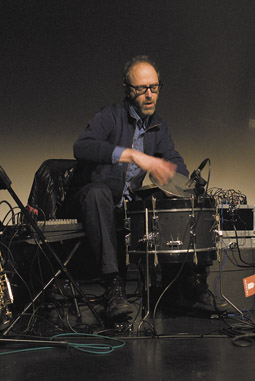
Jason Kahn, Activating the Medium Festival
photo Randy Yau
Jason Kahn, Activating the Medium Festival
JAZZ CRITIC IRA GITLER COINED THE TERM “SHEETS OF SOUND” IN DESCRIBING JOHN COLTRANE’S SAXOPHONE TECHNIQUE OF LONG, CASCADING, RAPID-FIRE LEGATO SOLOS. ULRICH KREIGER’S OPENING PERFORMANCE AT ACTIVATING THE MEDIUM, AN ANNUAL SOUND ART AND EXPERIMENTAL MUSIC FESTIVAL BASED IN SAN FRANCISCO, BORE LITTLE RESEMBLANCE TO COLTRANE’S FAMOUS TECHNIQUES –THIS WAS ANOTHER TYPE OF “SHEETS OF SOUND” ALTOGETHER.
Krieger’s set was not about harmonic sophistication, melodic filigree, soulful lyricism or any of the traditional saxophone signifiers—this was a punishingly loud and unrelenting barrage of noise. Kreiger achieved this critical mass through an effects set-up which might more conventionally be employed by noise guitarists—primarily heavy distortion and long delay. He shaped the sound by layering clouds of sustained blowing into a dense mass of sound. By moving as he played he was able to generate squalls of microphonic feedback which further added to the dissonant mix. The set was short, extremely intense, and all the more powerful for its 15-minute concision.
Now in its eleventh year, ATM is hosted by the 23five organisation and curated by local sound artists Randy Yau and Jim Haynes. Each year it focuses upon a particular aspect of sound art, with past themes investigating field recording, sound and architecture, sound and simulation, sound and performance, the acousmatics of sound with film/video, and the Californian noise scene. This year’s festival theme was “The Instrument”, focussing on “the parallel strategies that [sound artist and experimental musicians] employ in using conventional musical instruments alongside refined conceptual agendas and technological applications.”
I was glad to have picked up a set of the earplugs given away in the foyer. Francisco Meirino (aka Phroq) was up next and he was also very loud. Meirino used a harmonica to generate samples on his laptop and further processing these: looping, regenerating and pitch shifting his harmonica until its sound was vast and organ-like in its breadth. Occasionally he would gesture in mid-air with the contact-miked harmonica, setting off plumes of feedback or fusillades of harsh digital glitching. For those in the audience interested in the performative aspects of the show there was more to see than your average laptop performance—Meirino was busy at work with harmonica playing, feedback controlling, expressive gesturing and hands-on signal processing. Most, however, were content to simply sit, eyes closed, letting the massive waves of sound wash over them.
Jason Kahn is one of an increasing range of percussionists who utilise electronics in their live performances. His drum set is amplified by a number of microphones, which allows him to create and control feedback, using both percussion and the resonant frequencies of the space. Kahn also uses a synthesiser to further enhance and process these resonant feedback loops. In fact, his primary instrument is not percussion, but the room itself. His set began slowly with a swirl of white noise. This seemed static for a time until it became obvious that the surging white noise was in constant but muted flux, gradually modulating in density and timbre. At various points in the performance Kahn could be seen brandishing a cymbal above the drumhead. Controlling feedback with it, he gradually introduced a range of controlled frequencies until he’d generated a layer of sub-bass submerged beneath the white noise with which he’d begun. After a while these deep bassy tones became the dominant sound, filling the theatre with their sonorous resonance before being slowly faded out. Kahn told me, “I want to create an immersive sound experience for the listener; to hear the sound from inside and to feel the sound with one’s whole body.” At this performance he definitely achieved his aim.
Zbigniew Karkowski’s piece began with three wind players seemingly free-blowing as fast and as loud as they could. Acoustically this was like a free jazz freakout, however both saxophone and flute were running through loud distortion pedals giving them the dynamic range and attack of hard rock soloists. This distortion emphasised the instruments’ upper harmonics, giving them a rasping, brittle tone. Xopher Davidson was further processing the ensemble as they played, adding sine waves, ring-modulation and a deep low-end bass tone. All of the musicians were playing hard and fast, evidenced by the accompanying range of grimacing, facial tics and bodily contortions. However, all of the instrumental articulations and gesturings were barely liminal—ghostly artefacts, subsumed within the body of massive noise. There was a strange disconnection between the frenetic physicality and the mostly monolithic mass of sound being produced.
The performance gradually ascended in pitch and density before coming to a sudden stop, revealing a low volume bed of white noise percolating underneath. This layer of sibilance was being slowly modulated and filtered by Davidson. At least that’s what it seemed like—the overall effect could have been the sort of hyperacuity common after prolonged exposure to very loud sounds. Think of the hiss and ringing in your ears after a rock show without earplugs. After a few more minutes of white noise the piece ended with a short coda reprising the harsh noise of the first section. Simple in form and precise in its execution, Karkowski’s piece left many noise fans in the audience shouting for more. I would have preferred more subtlety, timbral variety and instrumental interplay, but it seems that would have been missing the point.
The remit of this Activating the Medium festival was pitched more towards the noise/drone axis of contemporary experimental music. Even so, many of the familiar techniques, technologies and methodologies common to other sub-genres of experimental instrumentation were present: extended technique, electronic processing, instrument preparation, live sampling, use of feedback and room sound, found objects, computer processing, mechanical playing devices and so on. A comprehensive overview of “The Instrument in Experimental Music” would be well nigh impossible for a small festival, nevertheless ATM signposted many of these current instrumental tendencies in a provocative, entertaining and dynamic presentation.
Activating the Medium, Eleventh Annual Festival of Sound Art : The Instrument, Feb 2: performers Ulrich Krieger, Francisco Meirino, Tim Catlin, Zbigniew Karkowski with Suzanne Thorpe, Andy Strain, Ulrich Krieger, Xopher Davidson, Feb 23: performers Phill Niblock, Thomas Ankersmit; San Francisco Art Institute, www.23five.org/activating/atm2008info.html
RealTime issue #84 April-May 2008 pg. 43
© Tim Catlin; for permission to reproduce apply to realtime@realtimearts.net
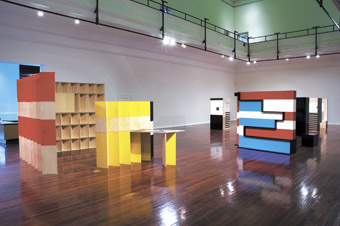
Gail Hastings, Sculptural Situations, 2008, installation view at the Perth Institute of Contemporary Arts
TWO KEY TERMS IN GAIL HASTINGS’ VOCABULARY ARE ‘SCULPTURAL SITUATIONS’ AND ‘ENCYCLOPAEDIA.’ HER INSTALLATION AT PICA, TITLED SCULPTURAL SITUATIONS, CONSISTS OF WOODEN PANELS, SHELVES AND CHAIRS (OR LACQUERED CHAIR-LIKE OBJECTS) ARRANGED IN A FIRM BUT UNBALANCED GRID. UNDRESSED TIMBER AND COMPOSITE BOARD ALTERNATES WITH BLOCKS OF PRIMARY COLOURS AND GLOSS BLACKS AND WHITES, AS WELL AS LEATHER OVERLAYS.
There are strong allusions to furniture—chairs, tables, and especially bookcases for shelving encyclopaedias, or other modular information housings—but also deformations of these. Cubic masses rise to horizontals for a seat, before rectilinear overhangs vex such potentials. At points, these taut minimal forms and surfaces are interlaid with glass panels over text and sketched plans.
Entitled “Encyclopaedias”, these texts cite (possibly apocryphal) conversations between the designers of Canberra—high modernist architects, and sometime Anthroposophists, Marion and Walter Burley Griffin—and their clients. Characterised by clipped dialogue and debates about where art should hang on the library walls, or if a block of colour presented to the viewer is art, the influence of Jorge Luis Borges’ writings on the inaccessible labyrinth of the totalising library is notable. Like the sculptural forms which surround these panels, the texts circle around an absence at the centre of knowledge, art and modernism; a utopian impossibility which nevertheless appeals today.
It is here that Hastings’ art historical references come into play. A pair of leather covered boxes displaying mono-colored squares-within-squares recapitulate the style of Kazimir Malevich (who concluded the square was the ultimate iconic sign of God and purified spiritual essence), while the tonality of red grids alternating with black borders or glistening blocks of red, white and blue incarnates Constructivism and the aesthetic of Piet Mondrian. Like the Griffins, these artists envisaged their work as part of a spiritual and political revolution reshaping society around a purified aesthetic. That the Griffins’ plan for a library on Canberra’s hill was unrealised (the largely hidden structure of new Parliament House occupies the space where it was to be) highlights this failure at the heart of modernism. The Soviet Revolution—which the Constructivists rallied around—proved a nightmare, while the esoteric spiritual concerns of Malevich and the Griffins became the subject of ridicule and absurd conspiracies. Hastings’ work replays the attraction of these radical ideals, yet also their incomplete and impossible conceits.
In place of revolution, Hastings offers “the haptic”—also championed by modernists like Albert Tucker—a profoundly sensorial approach to art which transcends meaning (or at least rational meaning). It is particularly here that Hastings’ model of “the sculptural situation” comes to the fore. Viewers inhabit the same space as the work, while its gorgeous, partially-finished, yet allusive and attractive surfaces encourage one to run one’s hands across them. However it is precisely this which the “sculptural situation” under consideration denies one the ability to satisfy such impulses—the fact that this is “Art!”, as one tetchy museum curator reminded me, not mundane furnishings. Here too is an absence, or a denial. The desire to touch is elicited but prohibited. However one reads Sculptural Situations, this is an installation within whose interstices one imaginatively luxuriates.
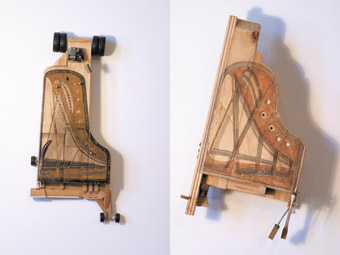
Alwin Reamillo, Mang Emo + Mag-himo Grand Piano Project
photo Bewley Shaylor
Alwin Reamillo, Mang Emo + Mag-himo Grand Piano Project
Alwin Reamillo’s installation at the Fremantle Arts Centre is more welcoming, with Reamillo acting as congenial host during much of the exhibition. It is the product of a residency conducted at the decrepit Manila piano factory of his father, Decimo, which bore the suitably hybrid name of Javincello and Company, and which produced instruments post-WWII under the brand name Wittemberg—a corruption of Martin Luther’s hometown in Germany. Reamillo collaborated with local craftsmen and family to produce two pianos—an upright and a grand—the latter displayed in the gallery. As Ros Bolleter has demonstrated, Australia had a particularly high uptake of German and Philippine pianos as signs of civilisation within the nation’s “empty heart”, while Reamillo discovered that the only remaining caster of piano frames is Watanabe in Japan. With Reamillo’s own transit to Australia, the project traces a history of exchanges which explode simple dichotomies of east versus west, centre versus periphery, Wittemberg pianos having been internationally prized in their day.
The grand itself is an exquisite object, its handcrafted qualities displayed in rich detailing. The panels are a treasure trove of hidden inlays and references. The whale, for example, is a potent symbol in Reamillo’s iconography, its oceanic voyages echoing his own movement between the Philippines and West Australia, while a Pinocchio theme—the wooden automaton animated through his filiation to a paternal Geppetto—also resonates. Appliquéd engravings of these graceful beasts spume and flow across the richly varnished surfaces, as do elusive images of Decimo, that other oceanic visitor to the coastlines of Australia and the Philippines, Captain Cook, matches—which the young Alwin dangerously played with in the old factory—and maps and compasses.
The walls of the gallery document the piano’s construction. The curious mix of industry—the modern piano is a product of sophisticated metallurgy and standardised tuning—and handicrafts appears repeatedly. Reamillo explains that the tuning was particularly vexatious; the grand now adheres to international standards, but given that many of the skills involved in building the Wittemberg design have been lost, the precise coordination of string lengths and pedal actions was devised partly through laborious trial and error. Also on display is an incredible bench turned into a marvellous tangle of tubes and fused matter by years of termites; a testament to the chaotic conditions which Reamillo initially confronted, and which, indeed, attracted him. If one has any doubts regarding the technological sophistication of Philippine craftsmen, Alwin Reamillo also displays Decimo’s patent and mechanism for the Wittemberg “harpitone”, which could be played both as a piano (strings are struck) and harpsichord (strings are plucked).
It is this mass of detailing, allusion, repetition and miniaturisation—both in the illustrations on the grand, as well as within the venue as a whole—that truly enchants. Toy pianos and car-like trolleys with stamped and burned piano-string designs across their backs, small piles of screws, dislocated hammers, keys and dampers, boxed advertising pamphlets and other exquisite cameos of the re-imagining of this world, disperse and multiply throughout the space in associated mini-displays. Even in the absence of live performance (represented by a recording in one corner and a one-off improvisation event), the detritus of the ages sings across the oceans like a whale’s evocative, water-borne cries.
Sculptural Situations, Gail Hastings, PICA, Perth, Feb 7-March 30; Mang Emo + Mag-himo Grand Piano Project by Alwin Reamillo with craftsmen Jaime Pastorfide, Tranquilino Tosio Jr, Sabas Rabino Jr, Fremantle Arts Centre, Dec 8, 2007–Jan 27, 2008
RealTime issue #84 April-May 2008 pg. 44
© Jonathan Marshall; for permission to reproduce apply to realtime@realtimearts.net
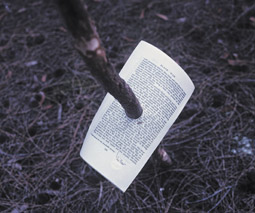
Julie Gough, Some Words for Change,
photo Simon Cuthbert
Julie Gough, Some Words for Change,
AN EAGER HOST AND GUIDE WAIT FOR ME WHERE THE SOGGY DIRT ROAD ENDS. I HAVE DRIVEN HALF WAY UP TASMANIA’S EAST COAST THROUGH STORMY WEATHER TO REACH THE FREYCINET PENINSULA THEN FOLLOWED DIRECTIONS DEEP INTO BUSHLAND AT THE BACK OF A WILD STRETCH OF COAST CALLED FRIENDLY BEACHES. THERE ARE NO SIGNS, LITERAL NOR FIGURATIVE, TO INDICATE ANYTHING REMARKABLE RESIDES WITHIN THIS SEEMINGLY RANDOM PATCH OF COASTAL HEATHLAND, BUT AS I’M TRANSFERRED INTO A BATTERED PEOPLE MOVER—THE ONLY VEHICLE PERMITTED ACCESS PAST THIS POINT—THE EFFUSIVE COMMENTARY OF THE HOST IMPLIES I’M ABOUT TO BE INDUCTED INTO SOMETHING VERY RARE AND SPECIAL INDEED.
Curiosity compelled me to accept the invitation to view this unusual event called Ephemeral Art at the Invisible Lodge. It’s sponsored by Sydney-based owners Joan and George Masterman, whose eco-tourism venture Freycinet Experience Walk (offering guided trekking holidays combined with luxury accommodation) co-presents Ephemeral Art with the Sculpture by the Sea organisation. The site is 130 hectares of land protected by a strict environmental covenant, which means that there is a legally enforceable obligation to prevent adverse impact on the land.
Two Sculpture by the Sea trails, modelled on Sydney’s Bronte to Bondi walk, were held on the Tasman Peninsula property of sculptor Peter Adams back in 1998 and 2001. As anyone familiar with Adams’ art and politics will know, he is a dedicated environmentalist. Consequently, the very popularity of Sculpture by the Sea was a factor in its downfall: the damage sustained to Adams’ land included litter, the impact of vehicles, the accidental ‘assassination’ of a tree by a well-meaning artist, and a view that the event was not financially feasible in the long term, put an end to hopes it had become a regular feature of the local arts calendar. Many of those organisers are now behind the rather different initiative, Ephemeral Art, which had its debut in 2006.
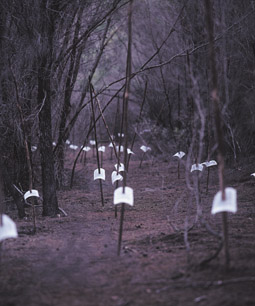
Julie Gough, Some Words for Change
photo Simon Cuthbert
Julie Gough, Some Words for Change
This year’s selection of site-specific installations was curated by a formidable panel comprising Dick Bett of Hobart’s Bett Gallery, the visual arts writer Peter Timms and the founding director of Sculpture by the Sea, David Handley. There was no call for applications, the nine exhibiting artists—Peter Adams, Dean Chatwin, Julie Gough, Colin Langridge, Anne Mestitz, Sasha Reid, Ron Robertson-Swann, Marcus Tatton, Catherine Woo—were preselected and propositioned in “a generous act of patronage”, as Timms puts it in the exhibition catalogue. The works were on display for a month, but there was a catch: the works were seen only by 40 holidaymakers at the price of $1,350 each, and a similar sized group of invited art critics and administrators attending a special viewing and gourmet lunch.
I was a member of neither of the groups above, but the recipient of an informal invitation offered to postgraduate students at the Tasmanian School of Art. My viewing was a heavily mediated one, the attentive hosts not only leading me to each work by foot or vehicle, but also stepping me through the interpretation too—determining the angle of approach, recommending the best vantage points and providing anecdotes about the artists’ aims and processes. All this was done with the best intentions, and perhaps reflects the level of assistance required by regular lodge guests. As a self-sufficient art viewer however this was so like receiving an owner’s tour of a private collection that it became near impossible to engage critically with it as an exhibition of new contemporary art.
For example, standing with the others in front of Adams’ elegant mandala composed of white sand peaks and the seed pods of surrounding casuarinas, I was overwhelmed by a desire to be completely alone with this work. I heard the mantra of breaking waves across the dune and felt sure Adams had intended to create here a place for meditation. But under the circumstances of my guided tour, I found myself resorting instead to a formal appreciation of the spiral form and the tonal quality of the rain-dimpled sand instead—a superficial intersection with what I can only suspect was potentially a deeply spiritual piece.
The catalogue must have gone to print early in the project’s development, for it states: “the work should be made primarily of materials found on-site and…be impermanent. It must be left where it is to fall apart in its own good time.” In fact, very few of the works here reflected any real attempt to meet such ideals. A creative process guided by a leave-no-trace-behind environmental ethic is precisely the expectation the title raises, but works like Robertson-Swann’s tree-aiding apparatuses of steel cables, glass and even a plumb bob, and Anne Mestitz’s delicate intervention into the remnants of a bushfire with reflective plastic tape, were clearly not driven by a concern for using sustainable materials. More pertinent was the fact the artists came and removed their works at the end of the month.
Catherine Woo’s piece was the only unequivocally ephemeral work here. Processing Plant was a collection of natural materials from the ground at the base of a large sand dune, categorised into discrete piles of various sizes. Between mounds of dry fern fronds, charcoal, wombat droppings and banksia flowers wove interlocking pathways of white sand that beckoned the viewer through this little city. Footprints showed an array of native animals had taken up Woo’s invitation, but I was asked to view from the edges to avoid degrading the work. My understanding was that by their very essence, ephemeral art works embrace the disorderly processes of environmental change but it seemed the concern for the work’s preservation was as much about the perceived aesthetic appeal of a ‘pristine’ state, as it was for its physical integrity.
The stewards of Friendly Beaches necessarily treat their environment with a certain preciousness that justifies the exertion of a high degree of control over who is allowed to visit, and the conditions under which they do so. It seemed to me, however, this attitude posed significant problems when applied to the viewing of the artwork they temporarily hosted. A certain degree of freedom is prerequisite to forge the relationship that makes an encounter with art meaningful and moving.
When the tour was complete, I was promptly delivered back to my car by the side of the dirt road feeling amused and bamboozled by the unlikely conglomerate of seemingly conflicting objectives, limitations, aspirations, attitudes and individuals represented in this extraordinary exhibition. One of the major questions the event raised for me was: what is the value in writing a review of an event from which the vast majority (you readers) have been consciously, not just incidentally, excluded?
I am more than happy to state for the record my opinion that the installations themselves were, on the whole, excellent—particularly in dealing with a breadth of stimulating ideas pertinent to a particular landscape. I was also impressed by the elegance and integrity of their all-weather execution. Julie Gough’s dramatic Some Words for Change and Dean Chatwin’s opportunistic inverse doormat, were two of the highlights. Ultimately however, I suspect some reflection on the workings behind this mysterious, highly exclusive art event itself might be of greater relevance to a community of artists and art viewers who will never have the opportunity to view an Ephemeral Art at the Invisible Lodge show for themselves.
Ephemeral Art at the Invisible Lodge, Tasmania, Feb 14-16, 18-20, 21-23, 24-26
Bec Tudor was a day guest of Friendly Beaches Lodge. She drove herself the five hour return journey and brought her own packed lunch. She is a Hobart-based writer, a PhD candidate at the Tasmanian School of Art and was one of the RealTime review-writing workshop team for the 2007 Ten Days on the Island festival.
RealTime issue #84 April-May 2008 pg. 46
© Bec Tudor; for permission to reproduce apply to realtime@realtimearts.net
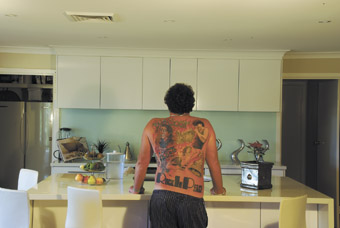
Glen in the kitchen, digital print, 2007, Bon Scott Photo Project
photo Rebecca Dagnall
Glen in the kitchen, digital print, 2007, Bon Scott Photo Project
THE IDEA OF STAGING A BON SCOTT EXHIBITION, SAYS CURATOR JASMIN STEPHENS, CAME FROM THE FREMANTLE ARTS CENTRE’S DIRECTOR JIM CATHCART, A PASSIONATE BON SCOTT FAN. FOR STEPHENS, THE FAC’S CURATOR/EXHIBITIONS MANAGER, THE STATUE OF THE LEAD SINGER AND CO-LYRICIST OF AC/DC (SCULPTED BY FREMANTLE ARTIST GREG JAMES WITH FUNDS RAISED BY THE WA BON SCOTT FAN CLUB AND UNVEILED FEBRUARY 24 THIS YEAR) WAS A FINE TRIBUTE. BUT THERE WAS INEVITABLY SOMETHING STATIC ABOUT THE RESULT, ESPECIALLY GIVEN THE SINGER’S LARRIKIN AND OUTSIDER STATUS. THE FAC THOUGHT THAT THE CELEBRATION OF A LIFE COULD BECOME, SAYS STEPHENS, “AN OPPORTUNITY TO STRIKE UP A CONVERSATION ABOUT PUBLIC ART AND HERITAGE.”
One strand of that conversation has been realised in artist Lucas Ihlein’s popular Bon Scott Blog. Ihlein writes in his introduction, “Lucas was not a fan of AC/DC. You can read about his process of immersion! He is meeting fans, visiting cemeteries, chasing up Bon’s old friends and lovers, attending concerts, and listening to a lot of heavy rock.” It’s a fascinating read. A good starting point is Ihlein’s account of his visit to the Fremantle Cemetery where there’s a humble memorial plaque for Scott, a missing heritage plaque and a steady flow of intriguing pilgrims, including Ben Scott, the alleged love child of the singer. The responses to this entry reveal the wide range of people The Bon Scott Project is engaging.
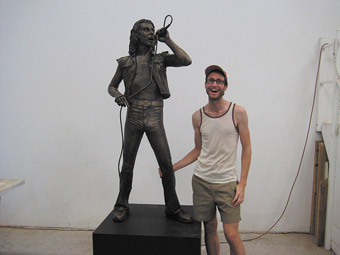
Lucas Ilhein and Statue of Bon Scott
photo Simmo
Lucas Ilhein and Statue of Bon Scott
Jasmin Stephens sees Ihlein’s blog “as a public art work”, playing a much more significant role than the internet’s usually illustrative and educational functions in galleries: “The web is often an afterthought, developed after the conceptualisation of the show.” However, “Fremantle Arts Centre was prepared to make a substantial investment in Lucas for six months of working on the blog and travelling.” A “blogging-as-art project”, as Ihlein describes it, it aims to develop a conversation around the exhibition and be one of a number of dialogues (a fashion show, a tribute band performance, a Bon Scott letters exhibit) with the FAC audience beyond the central exhibition of art works—an opportunity too for substantial audience building.
Another public front is the Ihlein-curated Bon Scott Electronic Sign Project, an LCD screen visible near the old bridge into Fremantle made available by the Fremantle Chamber of Commerce during the exhibition. Ihlein will post messages from fans from all around the world during the course of the exhibition.
How were the participating artists selected for the exhibition at FAC? They had to be interested in the Bon Scott phenomenon but, says Stephens, didn’t have to be fans: “Scott’s fans have shared codes and vocabularies. We wanted artists who are not necessarily fans to break open some of these with a range of responses.” She comments that there are more Scott fans today than when the singer was alive, and they’re often quite young. Themes that have emerged are remembrance, masculinity and rebellion, and a nostalgia for the 70s (as opposed to the 60s lauded by one generation of parents and, says Stephens, her university lecturers). Curious pieces of information emerge from such investigations: there are more AC/DC fans in the northern hemisphere than in the south; many people don’t know that the band is Australian—some think it’s German!
Victorian artist Richard Lewer, who draws, paints and makes video installations, was raised a strict Catholic in a family that saw Scott as satanic. Sydney’s Adam Cullen, who enjoys his own bad boy status, has long been intrigued with how working class male culture expresses itself. Perhaps, says Stephens, “we need a class analysis to understand Bon.” Alex Gawronski, also from Sydney, continues his research into the globalisation of the art world, addressing how being a bad boy can be a career strategy. Western Australian artist Rebecca Dagnall looks at how fans celebrate Scott, photographing them in their homes and documenting the shrines they maintain. Melbourne’s Ian Haig, 11 years old in 1975, recreates the world of the Ringwood Shopping Centre where he saw the band perform. Local artist Bevan Honey is creating an apparition of Bon Scott, sometimes visible, sometimes not, beneath the bridge on the way into Fremantle. Western Australian artist Ryan Nazzari’s suite of paintings evoke the singer’s dark side and are, says Stephens, “very painful to look at, very dark, very black, like imploding stars. What brings a man to the point where he dies alone?”
The sex and death connection is inevitable when dealing with Bon Scott who, although not conventionally handsome, was amazingly promiscuous. Stephens says that the singer was “a prolific letter writer, keeping in touch with the many women he’d met on his travels, often trying out in the letters the lyrics composed and rehearsed on his lonely touring schedules.” Katie Dyer has curated the first ever exhibition of the Bon Scott letters.
As well as the exhibition of artworks in response to the Scott phenomenon and the showing of the letters, there’s a Bon & Fashion night (coincidentally artist Scott Redford’s work will focus on the tightness of the singer’s jeans) and a Perth AC/DC tribute band titled FAC/DC. Stephens reports that once word got out about the exhibition, FAC was swamped with offers from AC/DC cover bands from around the world to come to Perth at their own cost. FAC thought this through and felt happier about putting together a band from strong local talent. It includes two female members, one of them the lead singer, a wry comment on changing times but, asserts Stephens, no less a powerful recreation of the band.
Stephens herself feels that “she’s come to know Bon Scott quite well. Entering his world I’ve met so many men who are his fans and supporters of this project.” That includes Fremantle Mayor, Peter Tagliaferri, but there’s also no shortage of female followers, like Alannah McTiernan, WA Minister for Planning and Infrastructure who turned out to be a huge fan.
The Bon Scott Project is innovative on a number of fronts, providing art with a more public face than is usual, not just because of its subject, a major popular figure, but because it connects with its potential audience through the internet, autobiographically through Scott’s correspondence, and via fashion, live music and intriguing responses from a largely younger generation of Australia’s visual artists. It’s a big conversation, doubtless with a lot of singing along. RT
The Bon Scott Project, curator Jasmin Stephens, artists Stuart Bailey, Guy Benfield, Adam Cullen, Rebecca Dagnall, Cecilia Fogelberg, Alex Gawronski, Ian Haig, Bevan Honey, Matthew Hunt, Lucas Ihlein, Richard Lewer, Michael Moran, Ryan Nazzari, Vanila Netto, Nat Paton, Scott Redford, Eli Smith, Martin Smith, Tanja Visosevic; Fremantle Arts Centre, May 17-June 30; www.fac.org.au/bon_scott_project.php; www.bonscottblog.com
RealTime issue #84 April-May 2008 pg. 47
© RealTime ; for permission to reproduce apply to realtime@realtimearts.net
Alasdair Foster is Director of the Australian Centre for Photography (ACP) in Sydney and Editor of Photofile. A long-standing publication of the ACP, and the only art photomedia-dedicated publication in Australia, Photofile combines quality reproductions, essays, surveys and reviews. Each edition has a different theme and often a different guest editor.
Is there a new editorial vision for Photofile given the new format?
Strong ideas, clearly expressed. That’s the underlying philosophy. And this is a national magazine, the only one dealing exclusively with photomedia art, so it is important that it reflects what is happening nationwide, not just in the southeast and not just in the metropolitan centres. Although there has been some increase in the physical size and number of pages in the new format, there is considerably greater increase in the amount of content. And that increased content is more diverse, both in opinion and in the method of presentation. There are more voices, more ways of showing and telling.
What will change?
[The] way in which the images and ideas are explored in the main body of the magazine will tend to change with the theme and the editor. I’m editing the next couple of issues myself until we resolve the technical and editorial side of the new format. Then it will return to the practice of having guest editors for each issue. This ensures a level of expertise about the theme concerned and allows the magazine to explore with different networks of writers and photographers. Before we have the benefit of hindsight, it is only prudent to look at things from as many perspectives as possible.
Will future issues be themed? What are the forthcoming themes and how do you hope to explore them?
At this stage I want to stay with themed issues, it helps give each edition a focus and allows each guest editor to play to their strengths. This is balanced by the expanded review and preview sections, which allow for a reflection of what is happening more generally. In this way, there can be a balance between thematic focus and currency.
The re-launch issue explores the short and medium term future in the light of exponential technological growth. It looks to a world of the transhuman, when photomedia may not so much be a reflection of the world around us as the perceptual world in itself.
Photofile 69, out in August, looks at Australian suburbia. Australia must be one of the most suburban populations on earth, and this suburbia is by no means the dully conformist mire that received prejudice might lead us to believe. It is a place of contentment and pathos, comfort and irony, fierce individualism and nagging doubt.
In issue 70, Photofile will explore money and power, not simply in terms of its representation in photomedia, but in terms of the fiscal frameworks and patronage which sustain the Australian art world and particularly those who arbitrate the cultural value to photomedia. Like the ‘Futures’ issue, it will reflect not only the ideas articulated through photography, but the framework in which the photographic image reaches us and is valued.
What are the key aspects of photography that you see Photofile debating, showcasing or responding to?
Certainly where things are going. Because we are headed there very fast, faster by the year. As a technological artform, photography is both subject to and well reflects upon the rapid technological changes we are witnessing today. The advent of video, DVD, mobile phone cameras, internet porn…is changing the way we engage with photomedia and the more cultural and artistic practices can hardly remain untouched.
I think it is useful to look at art photomedia from outside the rhetoric of art. To consider what is happening in our ever-changing art world from the perspective of psychology, neurophysiology, physics, economics, history, sociology, consilience theory and so on. To try to understand where art fits into the world at large.
Is the new format Photofile a response to broader changes in the production and reception of contemporary photography in Australia?
Yes. I think this is true in a number of ways. There is definitely a greater plurality of approach to both making and showing photomedia in Australia (and internationally) these days. Things are less dogmatic. There is a wider range of what is shown and that allows for and interesting exploration of the interface between these diverse areas. On the one hand institutions like the Photographers Gallery in London or the Netherlands FotoInstitut in Rotterdam are showing a much wider variety of work–conceptual, documentary, historical, snapshot–and on the other magazines like doingbird, Purple and Big bring together a really diverse range of photographers from international big names to eccentric one-offs and emerging practitioners.
I’m not looking to copy those magazines, but they inform the way in which a readership responds to printed images, and the visual fluency and expectations they might have. So it is important to me that we span a range of work, but work which is of real contemporary interest, whether or not it itself is contemporarily produced.
How do you see your role as curator at the ACP in relation to the direction and content of Photofile? How do the 2 responsibilities inform each other?
They inform each other, particularly during this transitionary period when I am also editing Photofile. Information that comes in for consideration by ACP for exhibition automatically becomes known to Photofile and vice versa. It is important given the national scope of the magazine that it draws its information from a wide and diverse range of sources, and this two-way information flow certainly helps that.
That said, I try hard not to overly influence what is contained in Photofile when another person edits it. I do have strong feelings about how things are expressed, but what is expressed is, I believe, up to the editors concerned. I do passionately believe it is not simply unfortunate but unethical to end up limiting the appreciation of contemporary art through ‘mandarin’ language. It’s very difficult to find ways to express complex and evolving ideas and translate them from the visual world to the written. But no one said it was easy. It is difficult. Let’s start there and get on with the job…
RealTime issue #84 April-May 2008 pg. web
© Mireille Juchau; for permission to reproduce apply to realtime@realtimearts.net
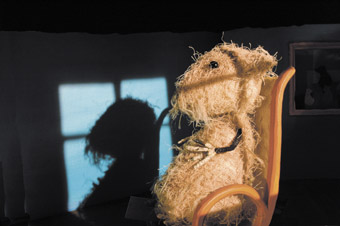
Goodbye Mr Muffin, Teater Refleksion and Teatret De Røde Heste
photo Jan Rüsz
Goodbye Mr Muffin, Teater Refleksion and Teatret De Røde Heste
ASSITEJ 08 [REALTIME 83, P56] IS AN INTERNATIONAL PERFORMANCE FESTIVAL FOR YOUNG PEOPLE, TO BE HELD THIS YEAR IN ADELAIDE. I ASK JASON CROSS, THE FESTIVAL DIRECTOR, ABOUT THE ORIGINS OF HIS PASSION FOR PERFORMANCE. HE DESCRIBES HIMSELF AS VERY FORTUNATE THAT HIS MOTHER HAD WORKED AS A PROFESSIONAL DANCER (WITH HIS FATHER) AND TEACHER BEFORE COMING TO AUSTRALIA IN 1969. CROSS DANCED FROM FIVE YEARS OF AGE UNTIL HE WAS 22, IN CLASSICAL, JAZZ AND CONTEMPORARY DANCE. BUT IT WAS HELEN SIMONDSON AT MELBOURNE’S ST MARTIN’S YOUTH THEATRE WHO INTRODUCED CROSS AND HIS PEERS TO CONTEMPORARY PERFORMANCE.
The next stage in Cross’ evolution as theatre artist was unconventional and anticipated a career in the independent scene: “Through St Martin’s I started working as a child actor doing soapies on TV and some film work. I found it boring a lot of the time. For four to five years I applied to NIDA, VCA and WAAPA and didn’t get in. But at the same time, in the early 1990s, I began a relationship with Anthill Theatre, working with Jean-Pierre Mignon. Anthill was thriving. I was only 19-20 and it propelled me forwards. They introduced me to the likes of Beckett, to various philosophies and ways of thinking. I was encouraged by Jean-Pierre to direct and to make work independently. From the Anthill experience I went on to make several works with David Young [subsequently director of Aphids]; we’d met at St Martins when I was 15 or 16.”
In 1995, Cross, Simon Woodward (whom he’d worked with in the performance company Primary Source) and Tomek Koman began to form 5 Angry Men—the result, he says, of “the Melbourne Festival being prepared to commission work, through Patrick Cronin (then with The Men Who Knew Too Much). It was a fantastic period. We had a studio. None of us had financial responsibilities. We were working from a very conceptual framework in terms of where ideas were developing from and mainly looking at object and sculptural based work in terms of performing the physical action that comes from that object. In particular, we were looking at religious iconography that could be reinterpreted so that it was familiar to the general community, in public spaces.”
Once formed, “5 Angry Men were quickly in Poland in 1995 putting together a new work. We spent two months working together and mucking around at what was called the Krakow Experimental Art Festival of the World. And that led to a whole series of experiences in terms of touring and traveling and working in Europe.” The company folded in 2002: “It took probably two years to mourn. It sounds romantic but there was really a sense of engagement with those people and the rigour that went with the conversations we had.”
The positive experience of being encouraged by Melbourne’s international arts festival gave Cross his first sense of the creative power of festival directorship. In 2002, he took on contract jobs for community based festivals: “I produced the Tet Festivals for Melbourne’s Richmond Vietnamese community. Then, the Big West Festival job came up and with my partner Victoria Raywood (a member too of 5 Angry Men) applied for it as a job-share with the notion of being co-artistic directors. Victoria has a strong administrative bent.”
In 2002 the couple produced Rice Paddies for the 2002 Melbourne Festival: “We’d been travelling in South-East Asia and Victoria envisaged the landscape within the urban Australian context of the rice paddy…That was an interesting period when the festivals had the capacity, desire and willingness to commission public art works. In the late 90s and into the early 2000s, we were receiving significant commissions of $50,000 to $70,000. Rice Paddies cost $75,000, but now for young artists, or any artist, attempting to raise $150,000—which is really a minimum sort of budget for a public art work—it’s not going to happen. That area of practice, of installation performance, object public art, has been completely decimated in the last 10 years. And there’s no peer group any longer.”
Cross co-directed Big West, in Melbourne’s western suburbs, three times: “It’s a biennial, multi-artform festival with a lot of commissioning. And I was fortunate also during that time to be a peer on the Victoria Commissions panel, funding large visual arts projects as well as performance projects. And then Victoria and I just decided to throw it all up in the air and look at other opportunities. And the ASSITEJ job came up. I’d never made theatre for young people, never programmed it, but I thought about it in terms of public art and the politics around access and my own personal background, dancing and acting as a young person.
“I looked at the historical background to performance and theatre for young audiences in Australia and internationally. It’s a fantastic story with an interesting political history in terms of the Communist Party of Australia and the significance of propaganda and the way that young people were a part of that whole movement. And then, of course, the growth of theatre-in-education in the 1960s, particularly in Canada and Germany, England and Australia. And then, for me, the ASSITEJ scenario was about learning about an international organisation and the differences in aesthetics from one country to the next, one region to the next. I came to the ASSITEJ Festival with the perspective that art is made for an audience that can be of any age, some of it suitable for young audiences. I really take a position that theatre doesn’t necessarily in all cases need to be made for young audiences in order for it to be for them.”
This explains why Cross has included shows like KAGE’s Headlock and others not originally staged for young audiences: “Because of my background, I really take the position that ASSITEJ is about artists making theatre for young audiences and in other cases it’s just artists making theatre. I try to avoid the use of the term ‘appropriate.’ One person’s notion of what is acceptable for a young audience can be completely different from another’s.”
The ASSITEJ printed program offers an age-o-meter to help parents and teachers gauge which shows will suit their charges. It’s interesting, says Cross, “the conversations with the companies about the age grouping has not necessarily married up with our expectation of what age group that particular work’s suited to. In a lot of cases, we’ve actually brought the ages down. It’s an exciting and eclectic program that asks where theatre for young audiences is going, and what are the possibilities.”
Programming a diversity of performance forms and styles was central to Cross’ programming: “And from a geographic perspective, the aesthetic styles of theatre for young audiences are so distinctly different, from Asia to Australia to Europe to North America. It’s critical to reflect those differences. I’m not suggesting that one is better or worse than the other. It’s simply about observing and discussing with our international peers what we do. There’s a tendency particularly from a European perspective to see the Central European aesthetic as being the ‘right’ one. And I think that’s important to debate in the festival.”
There’s a strong Indigenous strand in Cross’ program: The Voyage from Okinawa, Never Say Die from Thailand and the Korean production, Gamoonjang Baby, which is presumably partly informed by traditional arts practice as well. “That was the other consideration: looking at, not necessarily the origins of, say, a theatre for young audiences but certainly considering this idea that from an Australian Indigenous perspective, theatre for young audiences is an absurd idea because the idea of dance and song within an Indigenous culture is part of everyday life.”
I ask Cross how much of the festival is about the lives of young people. We know from the UN that there are millions of children in crisis around the world. There are certainly works in ASSITEJ 2008 that view the world from a young person’s point of view: the Arab-Hebrew Theater of Jaffa, whose play focuses on young people engaged in war; or Urban Myth’s Curfew about social constraints on the young; Arena’s Girl Who Cried Wolf or Zeal’s The Bridge. Cross adds Headlock—a young man’s first day in prison. “I’m not sure we need another play about sexual abuse but it comes down to finding points of empathy and similar experience, which young people can identify with. I don’t think that young people necessarily have the desire to see themselves. But I think they require characteristics that they are familiar with from their own experiences in the lives they’ve led to date. And I think that works like Surprise, designed for children as young as two by Dschungel Wien from Austria, or by companies like Adelaide’s Patch Theatre are good examples.
“To some people it’s an absurd notion to create a work for a two-year-old. But these are dramaturgical decisions, the kind Barrie Kosky spoke about at the Performing Arts Market recently. I think the success of artists like Rose Myers [formerly director of Arena Theatre and now at Windmill], Little Patch’s Dave Brown, playwright Angela Betzien and the director of Surprise, Stephan Rabi, comes from their willingness to investigate, to take risks, to fail before reaching an understanding as to how to re-engage yourself as an adult, to find languages that are not for you but for someone who’s in many cases 30 or 40 years younger than you.
“The play Surprise is just extraordinary. It works from one conceptual notion—the surprise, which a two-year old is constantly engaged with. Around every corner, everything in front of them is new. It’s ridiculous that as adults we forget it. The precision of this work is in identifying that one concept and pursuing it without being distracted by adult paradigms. That’s the success of many of the works in the ASSITEJ program.”
The productions in the festival range considerably in scale, partly to address the differences between practices: “We have a work like Nyet Nyet’s Picnic from Snuff Puppets working with Indigenous artists. This is a large-scale stadium-like performance, a fantastic work for this program because it really sets up the festival as presenting not only a process of collaboration but a work of a scale that I think deserves to be presented in Australia right now. And then we go from a 1000-seat auditorium scenario to miniature works for audiences of 50. This gives some sense of the desire I have for, say, my children (I have two) to have a broad range of experiences that allow them to engage with points of difference. For Nyet Nyet’s Picnic, we’ve been encouraging large group bookings so that there are large numbers of people sharing that experience, knowing a story collectively, rather than as just a family unit.”
Goodbye Mr Muffin by Teater Refleksion and Teatret De Røde Heste from Denmark is designed for a very small audience. “Essentially it’s about death, exploring our sense of immortality and it’s for 6-year olds and up. This is about an intimate relationship between the child and a significant person in their life—a parent or grandparent. The performance is about the conversation. It asks each audience member, six or 66, what they think about death. Is it something that you look forward to, something you find frightening?”
Cross is also director of the 2009 Come Out Festival: “Come Out is fantastic. It’s a multi artform festival. It’s been principally led by performing arts and I think that needs to be challenged. Younger people are essentially engaged with far more diverse media platforms in the experiencing and making of art. I think they need to engage with the professional end of this making so that they have a sense of what they’re going to aspire to, because they’re going to quickly overtake most of us. We’re particularly investigating interactive installation based work.”
The day after meeting Jason Cross I interview Marius von Mayenburg, the writer of Moving Target for Malthouse, premiered in the Adelaide Festival [see interview, and review]. The conversation continues about a child’s perspective on the world and the challenge for adults, as Cross puts it, “to re-engage” with a perspective that was, after all, once their own. ASSITEJ 2008 and Moving Target are odd but apt and necessary companions.
16th World Congress & Performing Arts Festival for Young People, May 9-18; www.assitej2008.com.au
RealTime issue #84 April-May 2008 pg. 14
© Keith Gallasch; for permission to reproduce apply to realtime@realtimearts.net
Writers Tim Atack, Rachel Lois Clapham, Mary Paterson and Theron Schmidt, all participants in the Writing From Live Art initiative of Live Art UK, combined forces to respond to the National Review of Live Art program in Glasgow this year. Their daily responses to performances, a mix of reports, reviews, interviews and opinion pieces under the banner We Need to Talk about Live Art, were aimed at provoking dialogue with fellow festival-goers. Here’s a selection of reviews of performances that engaged and intrigued the writers. RT
RealTime issue #84 April-May 2008 pg. 4
© RealTime ; for permission to reproduce apply to realtime@realtimearts.net
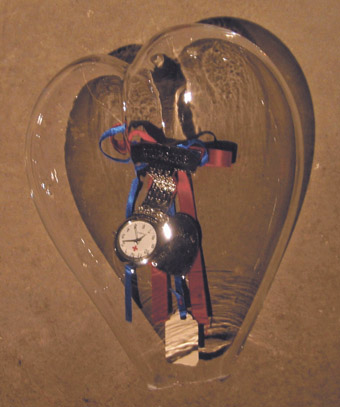
Shelia Ghelani, Covet Me, Care For Me, courtesy of NRLA
SHEILA GHELANI’S COVET ME, CARE FOR ME TAKES A MATTER-OF-FACT APPROACH TO HEARTBREAK. JUST PUT ON PROTECTIVE GLOVES AND A FACE MASK, TAP LIGHTLY WITH A HAMMER (“DON’T TRY TO BREAK IT IN ONE GO,” SHE SAYS), AND IT JUST SHATTERS INTO TINY, SHARP PIECES.
This shattering is repeated time after time inside Stable 4 of the Tramway, which has been remade into a luxury space which is part shrine, part upscale boutique. There are opulent red curtains, tastefully framed illustrations of hearts, a light scent of incense, and Frankie Avalon’s “Why?” pining sweetly away in the background. Arranged across the centre of the room are fifty hand-blown glass hearts, each one containing a numbered nurse’s fob watch, decorated with ribbons and a silver heart pendant.
One by one we are invited to put on protective gear, smash the heart of our choosing, and take the shining tokens next door to be carefully gift-wrapped and placed inside a tiny velvet satchel. On the surface, this all seems saccharine and melancholy. Might it be looking back to a past heartbreak of the artist? Each gift box includes a sponge containing one teardrop shed by the artist. Might the choice of nurse’s fob watch refer to some personal family history, a heroine lost too early? The gift-wrapping is printed with part of an article titled “What are people?”, which suggests that what sets us apart from other primates is our sentimentality, our search for meanings underlying our complex emotional lives. But there’s something else as well. This work doesn’t just nurse old wounds, if indeed it does that at all—instead, it casts itself into the future.
Each gift comes with care instructions (“Buff with soft cloth at regular intervals, Wear from time to time over the heart”), and each person who takes a gift is invited to a future gathering (date and venue tbc). At the entrance to the room is a framed declaration that “what she [the artist] was hoping was that one of them … might find its way from a pair of your caring hands into a heart, into a legacy, into a museum.” Ghelani’s hope, projected into the future, might be the source of this piece’s heartbreak and fragility–not a past disappointment, but a future longing.
Covet Me, Care For Me binds us all up in this hope, each of us carrying our synchronised watches ticking away the same measure of the same time. Ghelani’s work is a kind of service economy, in which gifts are exchanged for a future promise, and for which each gift-taker signs an acknowledgement of receipt. What are people? Sentimental, yes, carrying the memories of old wounds—but also complicatedly intertwined in each other’s lives and each other’s futures. I like this open-endedness, and the construction of alternative economies of exchange and intermingling.
Shelia Ghelani, Covet Me, Care For Me, National Review of Live Art, Tramway, Glasgow, Feb 6
RealTime issue #84 April-May 2008 pg. 4
© Theron Schmidt; for permission to reproduce apply to realtime@realtimearts.net
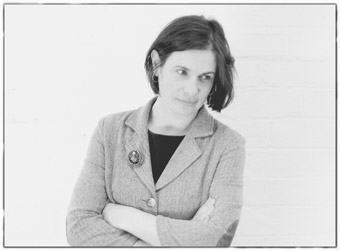
Claire Marshall, courtesy of NRLA
I HAVE NO THOUGHTS AND THIS IS ONE OF THEM IS A SKETCH MADE OUT OF SHADOWS. OVER THE COURSE OF AN HOUR, A WOMAN STANDS ON STAGE AND RECITES A LIST OF PHRASES FRAMED IN THE NEGATIVE. “I WILL NOT…”, “I AM NOT…”, “I DON’T HAVE TO…” SHE CREATES AN IDENTITY THAT IS PART RESOLUTION, PART REALISATION—LIKE A FIGURE HALF HIDDEN, HALF REVEALED BY FLICKERING CANDLELIGHT.
The list mixes up facts, hopes and understandings. Assurances of a western lifestyle (“I will not die of hunger”) tumble after statements of defiance (“I will never acquire ‘a look’”), peppered with the occasional bout of wishful thinking (“I will never drink again”). The character that emerges is middle-class and middle-aged, with all the freedoms and restrictions that entails. Most of it resonates with me and my values, and although I am pleased to remember that “I do not have to hide my body”, it’s sad and poignant to realise that I, too, will never befriend a penguin.
The eloquence of I have no thoughts…comes from the gentleness with which it sketches its cultural location. The text, and its mesmeric performance by Claire Marshall, describes the different ways a life can be curtailed—by birth and by circumstance, as well as by resolve. In doing so, it slips between the past, the present and the future. While some thoughts refer to lessons learnt, and some are literally performative (“I am not afraid…”), more project into a hoped-for future, explaining both the control we have over life and our powerlessness in the face of external events. “I will never have children”, Marshall says, which could be a choice; but the statement “I will never be ripped apart by penetration” does not, of itself, guard against violent attack.
What makes the character built here so realistic, and so three-dimensional, is its sense of becoming. Framed in the negative, her thoughts describe what does not fit, so that her outline is constantly shifting. Occasionally, Marshall refers to other people—a string of somebodies all addressed as “you”—as if she is speaking these thoughts while she lives each encounter. The effect is like a woman walking towards you with the sun behind her; she dashes in and out of focus, a ball of energy remaking its own boundaries.
I have no thoughts and this is one of them, created by Tine van Aerschot, performer Claire Marshall, Tramway, Glasgow, Feb 8
RealTime issue #84 April-May 2008 pg. 4
© Mary Paterson; for permission to reproduce apply to realtime@realtimearts.net
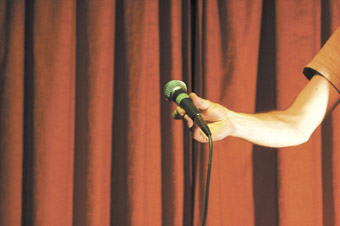
Augusto Corrieri, Quartet (for Anna Akhmatova), courtesy of NRLA
WHEN WE WERE TRYING TO DECIDE WHICH SHOWS WE MIGHT WANT TO SEE AND WRITE ABOUT, ONE OF MY FELLOW WRITERS ON THIS PROJECT SAID SHE WANTED TO AVOID ANYTHING “OVERLY INDEBTED TO THEATRE (CAPITAL T).” I THINK I KNOW WHAT SHE MEANS. PART OF WHAT’S BEEN EXCITING FOR ME ABOUT THE DISCOVERY OF WORK CALLED ‘LIVE ART’ IS ITS REVOLT AGAINST THE ASSUMPTIONS AND EXPECTATIONS OF THEATRE, ITS INVENTION OF NEW FORMS OF ENCOUNTER WITH PERFORMING BODIES, AND ITS AFFIRMATION OF THE VISCERAL AS EQUAL PARTNER TO THE CEREBRAL. AND YET, I’M ALSO STRUCK BY HOW WHAT GOES AROUND COMES AROUND. JULIA BARDSLEY’S GORGEOUS ALMOST THE SAME HAS BEEN THE MOST HEAVY-HITTING AND SYMPTOMATICALLY ‘LIVE ART’ WORK I’VE SEEN SO FAR AT THE NRLA—YET IT’S ALSO DEEPLY INTERESTED IN THE THEATRE SPACE AS THEATRE SPACE, AND FOR ALL ITS PRIMAL SINGULARITY, IT WAS PERFORMED THREE TIMES IN THE SAME AFTERNOON.
Coming from the other direction, Augusto Corrieri’s Quartet (for Anna Akhmatova), though thoroughly immersed in the contrivances of the theatrical, has been one of the most ‘live’ works I’ve seen. Quartet begins with Corrieri introducing to the audience what he’s about to do. He talks about his discovery of a story of something which happened at Milan’s La Scala opera house in 1913, in which the orchestra conductor failed to start the music for a solo dance sequence by visiting ballerina Anna Akhmatova. She performed her routine in silence, and when she left the stage, the music began, playing to an empty stage the score that was intended to accompany her.
Corrieri’s telling of this story is just a casual introduction, the sort of thing that happens all the time as audiences sit comfortably in their theatre seats—and yet his gracious, attentive manner creates a real sense of openness and a gentle feeling of co-presence.
As expected, Quartet takes place in four parts, each introduced by Corrieri. The lights go down and come up between each part, but otherwise there are no lighting effects and no surprises—nothing but the bare stage, a microphone on a stand, a tennis ball, a glass of water, and Corrieri himself. In the first part, The Movements, Corrieri stands and moves on the stage through a series of mimes, pauses, indecipherable gestures and minimal dances. He interacts with the objects but does not move them—for example, he reaches for the cup of water and leaves it where it sits while miming raising it to his lips and drinking. In the second part, The Objects, only the objects move. Of course, they won’t move on their own, so Corrieri has to manipulate them, but he does this while standing to one side of them, moving beside the trace of his previous movements. In this section, for example, he raises the cup of water but at arm’s length, and pours it where his lips previously were but where now there is nothing but air.
In the third section, The Music, three music tracks play, as Corrieri stands to one side. And when the final section is revealed to be The Words, I expect everything to be recovered, to be packaged up and made sensical. Partly, this is what happens; some of the more bizarre movements are given a somewhat plausible rationale by the accompanying text. But mostly what is striking is the way that the text keeps opening outward, referring to stories of events, stories told by other people, memories half-forgotten, and dreams and fragments linked only through their performance. “Everything around us is possibly on the verge of disappearing. Only a few things make it into memory,” Corrieri says (at least as I remember it). “This movement. This microphone stand. This shirt. This. This. This”, he says, without gesturing to anything. “This. This. This. This.”
I’m pretty sure that this suddenly wide-open space—written and overwritten with traces of presence and representation, what I saw and what I thought I saw—is Theatre (capital T).
Augusto Corrieri, Quartet (for Anna Akhmatova, National Review of Live Art, Tramway, Glasgow, Feb 7
RealTime issue #84 April-May 2008 pg. 5
© Theron Schmidt; for permission to reproduce apply to realtime@realtimearts.net
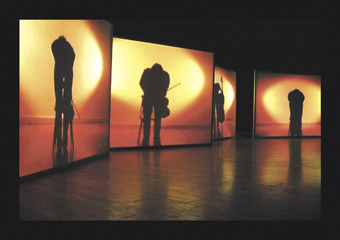
Hannah Wasileski, Virtuosic, courtesy of NRLA
THE SIZEABLE GLOOM OF A DARKENED TRAMWAY 1 FRAMES FOUR SMALL VIDEO PROJECTIONS, HUNG JUST BELOW EYE LEVEL AT THE CENTRE OF A PROSCENIUM ARCH FORMED BY BRICKWORK PILLARS. ON EACH SCREEN, ONE OF FOUR SEPARATELY RECORDED MEMBERS OF A STRING QUARTET PLAY THROUGH THE SENTIMENTAL CADENCES OF THE ALLEGRO FROM SCHUBERT’S DEATH AND THE MAIDEN.
The bowsmiths appear in silhouette from a variety of angles. They play consummately, no small feat given that they are all—in the first instance—playing alone. The ‘quartet’ is only manifest once edited together—and at first it appears that this rendition of Schubert will be a conventional one, albeit mediated by the pixel and the projector beam. Sure, there’s an oddness to the interactions of tones and harmonics, something akin to some of the weirder sonic experiments of the 1970s when overexcited studio engineers attempted to multi-track entire orchestras rather than have them play in unison. But these subtleties are nothing compared to the glitchy cadenza that follows.
Cello notes are suddenly bent into foghorn moans. The fireside glow of the projections abruptly slams on and off; the sound follows suit. Wasileski edits the living crap out of Schubert, chopping phrases, repeating strokes, warping the score into passages which resemble a whistle-stop tour of modern composition, sliding through serialism, rattling around in the new complexity for a bit, bouncing around in the silliness of Zappa or the phase shifts of Reich. All of which suggests a primarily musical exercise; but the tiny details within Virtuosic manage to nudge the proceedings into another arena altogether. Its staging, for instance (projections angled slightly, human in scale) recreates concert conditions. At first I find the silhouetted images of the performers something of a disappointment, almost a cliché, with Disney’s Fantasia springing to mind; but as the figures flash unpredictably from screen to screen with increasing rapidity they morph into another type of animation altogether—the scratchy tone poems of Norman Maclaren or Len Lye, speaking of something organic, something imperfect; far from sleek and mechanical, as you might expect from such blatant digital splicing.
So here’s the interesting question: once we’ve emerged from the final barrage of mashed-up strings, once the projections finally fall back into the last, bittersweet moments of Schubert proper, and the virtual performers silently lay their instruments down, what do you think the audience does? A ripple passes around the scattered assembly, a few nervous giggles—are we going to applaud? Is it really called for? Would it be rude not to? The players stand. Bow. And of course we applaud.
Hannah Wasileski, Virtuosic, National Review of Live Art, Tramway, Glasgow, Feb 7
RealTime issue #84 April-May 2008 pg. 5
© Tim Atack; for permission to reproduce apply to realtime@realtimearts.net
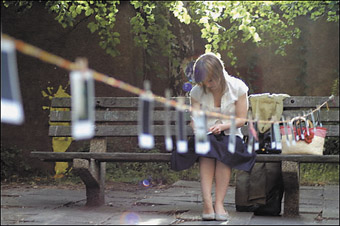
Jenna Watt, Bench, courtesy of NRLA
SOMETIMES IT HAPPENS AT NRLA. YOU’RE SHUTTLING FROM ONE PERFORMANCE TO ANOTHER, DIVING IN AND OUT OF QUEUES, NOT HAVING TIME TO EAT AND BEING CAUGHT UP IN THE MADNESS. THEN YOU STUMBLE ACROSS SOMETHING PERFECT, SOMETHING JUST FOR YOU AND JUST AT THE RIGHT MOMENT. FOR ME, ELEVATOR ARTIST [AN EMERGING ARTIST CATEGORY. ED] JENNA WATT’S BENCH WAS JUST SUCH A WORK.
Bench is a quiet, simple, low-fi live installation in which Watt sits on a wooden bench on the upper floor of Tramway waiting, taking time out from the NRLA crowds and queues, enjoying an inbetween moment and taking the occasional Polaroid to record relatively little for the purpose of posterity. Watt doesn’t take many Polaroids—mostly she sits, wanders around to chat with her friends or goes off to the toilet—but when she does take a shot she writes on it then hangs it on a string stretching across the bench area.
Photographic highlights of Bench include a shot of the bench itself, one of an adjacent staircase, a picture of a family friend who came to visit the installation and a partial pic of Jenna’s legs and feet. The writing on the Polaroid of the bench says, “You don’t have to queue for this one!” “I’m not going to take my clothes off”, reads another. And on the far side of the string I pick up a sparse looking installation shot that says “Eventually, you get into a state where you appreciate the crap you talk.” Quite. The meagre installation, the humble photographic subjects and throwaway Polaroid, not to mention the artist’s flippant approach to her own art, all combine to choreograph the specific inbetween moment or deliberate non-event that is Bench.
These make me smile and I chat to Watt a bit about the installation then carry on looking. Two minutes later she takes a shot of the wall next to the Tramway upper floor toilets and writes on it, “And I’m wondering why you’re even up here—it just confirms to me that you’re a dickhead.” This comment completes my perfect moment with Bench. Watt is right to question my festival fervour, my motives in coming up here specifically to seek out a woman quietly trying to remain undetermined and wasting time in the name of live art. In coming here to witness I have transformed Bench into something entirely more definite and spectacular than the productive inbetween the artist is trying to articulate, and in the process I have been called a dickhead. It serves me right. It’s a long time since anyone called me a dickhead so directly—and no-one ever did it in a piece of live art. Because of this I smile all the more. Such an antagonistic response to audience is a beautiful and all too rare thing in live art.
The carefully constructed low profile of Bench, with its bold questioning of its audience and acute sense of self awareness, represents a brave move for a young artist caught in the headlights of NRLA. Bench is also one of the only live works this year that has responded overtly to the specificity of its NRLA context in form, content and concept. Bench is a deliberately inbetween work by a not-quite-yet-arrived artist; it acts as NRLA program down-time or a filler and it is installed in an architectural space specifically designed for lingering or waiting.
Bench was a much needed antidote to other more earnest and overtly staged works at NRLA and the scripted ‘looking away’ Watt achieved perfectly harnessed the notion of waiting, killing time or purposeful lingering to which audiences and artists at NRLA are so accustomed. Watt says she is at her most productive in these inbetween moments, and I believe her.
Jenna Watt, Bench, National Review of Live Art, Tramway, Glasgow, Feb 9
RealTime issue #84 April-May 2008 pg. 6
© Rachel Lois Clapham; for permission to reproduce apply to realtime@realtimearts.net
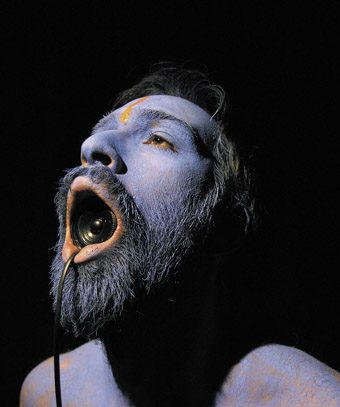
Harminder Singh Judge, Live Sermon, courtesy of NRLA
HARMINDER SINGH JUDGE EMERGES FROM THE VOID, BLUE-FACED AND BAREFOOT, CLAD IN A SARONG, A SMALL SPEAKER WEDGED FAST WITHIN HIS MOUTH, TIGHT AGAINST HIS PALATE, FAR BACK ENOUGH TO BE UNCOMFORTABLE, DEEP ENOUGH TO MAKE BREATHING SOMETHING OF AN ISSUE, A SOLE WIRE DROPPING FROM THE CURVE OF HIS LIP AND ACROSS HIS BARE CHEST, WHILST FROM THIS OBTRUSIVE SPEAKER A DEEP VOICED chant is crackling, guttural yet pure, clear of purpose, beautiful but basically forceful, and as Judge flexes the muscles of his throat in order to swallow, the edges of his mouth warp the essential formants of the song, and there is a voice in his throat, and it is not his own, and after a short time there is another voice in his throat, and it is also not his own, higher, quietly ecstatic, and even though we might not be able to decipher the precise tongue, it is undeniably a sermon, delivered with the clarion call of spiritual truth, self-evident, words falling like dominoes, spiralling away in preordained sequences, rising to god, reaching to you, feeling for your collar, wanting to hold your hand, and Judge is its vessel, beneath a single spotlight, head tilted back, in the service of whatever it is you care to imagine, however you picture it, hands clasped at his sides and the knuckles occasionally twitching, eyes full of a half-dead resolution, a general acceptance, like he does this all the time, like he does this all the fucking time, standing in this moonfull of milk, this white roundel, altar, temple, tabernacle, this slight ablution, holy river, petri dish, just enough to contain him, a pool of liquid and light, the rest of the room dark, the rest just void, void but for you and me, we the attendees, the tourists, acolytes, heathens, gawpers and hangers-on, the uninitiated, the unenlightened, wondering at this ceremony, not quite with it, not informed enough to be against it (the words not making sense) every gesture or every lack of gesture meaning something, a million stories falling off this static figure like leaves, memories and images floating to the ground around his feet like an autumn blanket of everything you thought about every church you ever went to, every shrine, pagoda and dagobah, every homily you made, every time you took your hat off and walked backwards from the cross, image upon image, the sing-song monk in the underground temple outside Matara, the amplified distorted call to prayer wafting across Chinatown in Singapore, the candles and offerings bobbing in the water off Copacabana beach as new year strikes, the serene icons regarding you inscrutably, the portals to the places you’ll never see, because you were not of it and you were not in the loop, because instead you were on the phone, or down the pub, or watching TV, or driving down the motorway listening to the radio and whilst you were doing that, he was here, under the light, the speaker in his mouth and the intertwining tones gently distorting upon his prone tongue, whilst you were riding your bike, kissing your boyfriend/ girlfriend or having a laugh or at the bar or queuing to see some other show or whatever the fuck it was you were doing, Judge was here, carrying the sermon, suffering for it, whatever, but not in that self-aggrandising flagellant way, not in that fakir way, not in that forty days in the desert way you keep hearing so much about, no, this is the quiet suffering, this is the downtime when your voices are not your own, when you’re just another cog in the machine, because that’s the ritual, that’s what the ritual does, wheels within wheels, one cog turning another, ritual makes it look easy, makes it look simple, a simple action to keep the sun rising, a simple action to stop your soul from dropping off the edge, because it’s just something that has to be done isn’t it, bricks in the wall, shoring up against death, and you wonder how long he can last up there, you wonder if the breathing is exponentially difficult, phlegm and saliva coagulating around the little magnet where his words should be, oesophagus held open, eyes blinking in the heat of the light above, do the tinny distortions of each word begin to hurt more, does he feel it as the night wears on, feet rooted, a monolith, a blue-faced statue worn by the wind of the stare from every pair of eyes in the room, shaving off his edges, blurring his boundaries, making him something else, then, like a sigh, his head tilts forward, the tones on his face darkening purple and grey, and gobbets of liquid trail the length of that cable like ectoplasm and you know it’s done, you can see the milk-white footprints as he returns to the void, but you also know he’s going to return once you’re gone, because if there’s one thing you’re certain of it’s that he does this all the time, and he does this all the time, and he does this all the time, and he does this all the time.
Harminder Singh Judge, Live Sermon, National Review of Live Art, Glasgow, Feb 8
RealTime issue #84 April-May 2008 pg. 6
© Tim Atack; for permission to reproduce apply to realtime@realtimearts.net
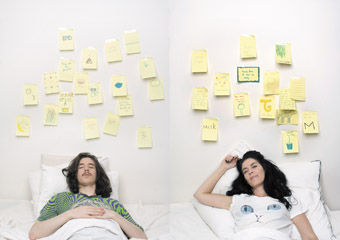
Sean Peoples, Veronica Kent, The Telepathy Project, 2007
photo Michelle Tran
Sean Peoples, Veronica Kent, The Telepathy Project, 2007
AS THE INTERNET WEAVES THE WORLD TIGHTER AND TIGHTER, OR GIVES THE ILLUSION OF DOING SO, ART OF ALL KINDS ATTEMPTS MORE VISCERAL INTIMACIES (ALBEIT OFTEN HAND IN HAND WITH THE NEW TECHNOLOGIES). REAL BODIES GATHER IN REAL PLACES, NOT JUST AS AUDIENCES BUT AS ACTIVE PARTICIPANTS IN ARTIST-CREATED SCENARIOS. AT THE 2008 NEXT WAVE FESTIVAL YOU MIGHT FIND YOURSELF IN A SLEAZY HOTEL ROOM, A NIGHTCLUB LOO, THE ‘DUNGEONS’ OF FEDERATION SQUARE, ON A JOGGING EXPEDITION OR A MISGUIDED TOUR OF A MAJOR ART GALLERY. BUT WILL IT, IN THE END, BRING US ALL CLOSER TOGETHER? THIS IS THE HOPE OF NEXT WAVE DIRECTOR JEFF KHAN.
“Closer Together” is the theme for Next Wave in 2008. The festival’s promo broadsheet reads, “The force gets stronger as two objects move closer together. The force gets weaker as the two objects move further apart…” Jeff Khan “invites artists and audiences to explore the space for vulnerability, intimacy, transgression and exchange in an increasingly globalised world.”
Khan believes that to combat globalisation’s rhetoric of closeness, there’s a need for a festival with real dialogue, diverse and alert to vulnerable areas such as lives impinged on by the forced sameness of the free market. He’s an optimist but one who recognises that it’s an attitude that has to be underpinned by the experience of works “that reveal the claustrophobia and darkness of restriction.”
It’s too early for Khan to announce all of his program, but in our interview he mentions enough to indicate just how he and his artists plan to draw us closer together. The Agents of Proximity (Amy Spiers & Victoria Stead) counter the global tourist trend with its giant carbon footprint by setting up a travel agency whose terrain is totally restricted to touring the Melbourne suburb of Brunswick.
X:Machine’s Serial Blogger, a large scale collaboration, takes up the challenge of merging the virtual and the actual with direct audience engagement. It looks into the dark side of the festival’s ‘closer together’ theme by “asking audiences to pry into the lives of a group of bloggers who get a little too close to someone stranger than themselves…a serial killer. The interactive journey will lead audiences from an online video narrative to a street located touchscreen interface and end at an underground warehouse for a gruesome live performance finale” (www.xmachine.com.au). The X:Machine team comprises artistic director Olivia Crang, co-artistic director Alex Gibson, multimedia artist Pierre Proske, video artist and sound designer Jarrod Factor, set and costume designer Harriet Oxley and a team of performers.
Khan applauds this kind of venture which he says represents “a new fearlessness about art and politics in younger artists, in which hybridity isn’t just a formal exercise but is driven by ideas.”
On a very different front Next Wave explores how, in The Nightclub Project, venues can be transformed in the name of art. Next Wave is determined to “push the arts experience into the social sphere.” Here artists take over the Billboard dance club with installations and acts and the Men’s strip club for a night of feminist and queer performances. “Ephemeral interventions”, says Khan, “but it’s interesting to see how far you can you push them.”
In direct contrast with such large scale events there’s Sydney performance group Post (Mish Grigor, Zoe Coombs Marr & Natalie Rose) performing to one audience member at a time in a 10 minute show (in three-hour stints for the performers).
On a larger scale, but with some intimacy, in Dear Art, Please Touch Me in the National Gallery of Victoria, performance artist Danielle Freakley offers an alternative audio guide to the gallery’s permanent collection. The guide comprises the recorded responses to the artworks from 15 viewers not educated in the visual arts (from a five year-old to a retiree and across a number of professions) to a score by WA sound artist Elizabeth McGechie. The NGV came to the party, providing use of their audio guide system.
For proximity of a very different order, and low tech as you can get, there’s The Telepathy Project. The photographer, installation and screen artist Veronica Kent will appear with fellow artist Sean Peoples at the Forum Theatre for a week. They’ll be installed in the shop window there where they’ll send and receive messages which will be posted for passersby to read (and perhaps recognise!).
In his career in the visual arts, Jeff Khan has worked at PICA in Perth, Gertrude St in Melbourne and on the curatorial committee of the 2006 Next Wave. He’s always been fascinated with interdisciplinary practices. Most formative of all, he says, was four years at Gertrude St watching resident artists make work. It’s not surprising then that he’s passionate about Next Wave’s Unsheltered Workshops which bring together artists from the USA, New Zealand, Canada and Australia in a residency program that allows them contact with audiences who can intervene in their work at the VCA Gallery. These are visual artists who are committed “to workshopping with the public”, says Khan, “at art’s interface with the social.”
To achieve his “closer together” goal in 2008 Next Wave, Khan envisages engaging “a large audience on an intimate scale”, whether in big institutional spaces like a major gallery (with earphones for private listening) or in more sequestered spaces, like a strip club, or a basement performance with an online dimension, or a room for three performers and an audience of one. It requires fearlessness all round, from artists and audiences. RT
Next Wave Festival, Closer Together, May 15-31
RealTime issue #84 April-May 2008 pg. 8
© RealTime ; for permission to reproduce apply to realtime@realtimearts.net
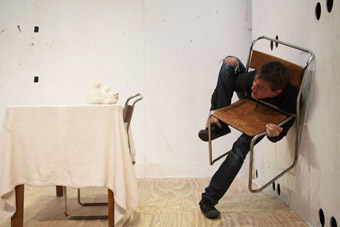
Hamish Michael, Moving Target
photo Tania Kelley
Hamish Michael, Moving Target
FIVE DAYS IN ADELAIDE GAVE US A MERE GLIMPSE OF THE 2008 FESTIVAL PROGRAM. WE SAW PRODUCTIONS OF MOVING TARGET, THE RED PRIEST AND THE ANGEL, THE DAY THE RAIN STOPPED, AINADAMAR, DON’T LOOK BACK, MUCH OF THE VISUAL ARTS PROGRAM AND, ON THE FRINGE, THE BORDER PROJECT’S TROUBLE ON PLANET EARTH. IN THIS BRIEF ENCOUNTER, THE MALTHOUSE PRODUCTION OF GERMAN PLAYWRIGHT MARIUS VON MAYENBURG’S MOVING TARGET WAS A REVELATION, AINADAMAR ENGAGING BUT OVER-PRODUCED AND THE LOCAL WORKS, THE RED PRIEST AND THE ANGEL AND THE DAY THE RAIN STOPPED, DISAPPOINTINGLY INSUBSTANTIAL. IN THE VISUAL ARTS WORKS EXHIBITED AT THE SAMSTAG MUSEUM, EXPERIMENTAL ART FOUNDATION AND JAM FACTORY PROVED MORE TELLING THAN THE ADELAIDE BIENNIAL ABOUT CONTEMPORARY ART FORMS AND COMPULSIONS.
moving target
Marius von Mayenburg’s play was created for Melbourne’s Malthouse in close collaboration with the director Benedict Andrews and a skilled team of actors over a long period [see interview p13]. This is reflected in the intense physicality of the production—built around the hide-and-seek game played over and over—and a spare text—brief, crisp lines in rapid alternation, suggestive at once of a single consciousness and a schizoid condition. It’s a play in which writer and director allow the actors’ bodies to speak powerfully for themselves.
Six characters, with the first names of their performers, inhabit a small concrete-walled room with a lounge, a table, tablecloth and chair, a carpet and some toys, a sleeping bag and a microphone attached to a wall. Clearly adults, the characters nonetheless behave like children (while never actually imitating them): playing, sulking, intimidating and bullying, sinking into moments of self-obsession, forming fragile allegiances, being easily spooked. The obsessive playing of hide-and-seek seems mostly triggered by moments of anxiety they’ve generated amongst themselves. Sometimes it’s the result of an external force signalled by loud sounds: “like an earthquake, annoying but not alarming”, but later, “like being hit by a bus.”
These impacts are gradually revealed to belong to someone they simply refer to as “she.” Soon we realise these people are not simply inside a room, they’re inside “her”, and “she” is unpredictable and frightening; later they are terrified at the prospect of having to negotiate with her. What is more alarming is that “she” is a child, an alien creature they conjure, seeing her holding a doll with one eye dangling by a thread…and there’s a stain on the floor.
The game these characters play with the commitment of obsessive-compulsives is a kind of collective defence mechanism that protects them as adults from dealing with the reality represented by the child. As von Mayenburg says of writing Moving Target, “it was very joyful to turn it around and say kids are dangerous and parents are scared. I think a lot of parents are scared of their children. You don’t know what they’re thinking, what they know and what they don’t know.” A rapid series of utterances skirt around issues about children, reflecting the self-censoring evasiveness of adults where the actual topic goes missing or is not named: “Well, she’s started.” “And how old is she?” “Oh, she’s eight.” “They usually start at 10.” This fear, this resistance, puts “she”, the child, at risk at the end of the play, by which time she’s considered a possible terrorist and, even if not, “then better off dead…just in case.”
Moving Target unfolds unconventionally, suspensefully and powerfully, the narrative structure building firmly around a motif (hide-and-seek) and constant, relentless variations on it as the game playing becomes more and more inventive, and then desperate and then destructive with players ruining each others’ moves. Between the hiding-and-seeking there are moments of boredom, small and full-scale intimidations and the release provided by wild crashings into walls. There are sudden ritual responses to “her” huge sonic incursions (electronic noise, songs)—the characters lining up and gesturing peculiarly as if to appease a god. However, in the final section, when the child’s fate becomes the focus of the action, the characters realise that something has to be done, and their world changes. As the media and state fantasy of a child terrorist escalates into spectacle, the room is flooded with a cycle of rich single colours, a visual playground totally at odds with the unfolding horror and the panic of its helpless inhabitants.
Moving Target’s power comes not only from its dramatic stucture but also from its patterned thematic reversals: the adults are child-like, the adults are inside the child; the adults are afraid of the child; the adults are complicit in the child’s demise. The inner child of these adults is still at play in their endless inventiveness but they are dangerously manipulable, prey to cliche and stereotyping, they are evasive, and only unanimous in their fear and prejudices. These are the collective parents of “she”, symbolic of a society out of touch with itself. In the end, they swing between “she’s only a child” to “she’ll get ideas” to “she doesn’t know what’s going on inside of her.” And when a sniper shoots her, they say, “We all felt it”, “But it was not unpleasant”, “We prevented the worst.”
The ensemble playing in Moving Target is exemplary. Julie Forsyth Matthew Whittet, Rita Kalneijais, Alison Bell, Robert Menzies and Hamish Michael create both idiosyncratic characters and a collective psyche with a single purpose, survival, even if it means sacrificing its own offspring. With Andrews they generate remarkable versions of hide-and-seek, moving from the obvious to slapstick to astonishing sculptural forms, moments of magic, lateral takes (hiding identities by exchanging clothes and disappearing into non-human forms)—all with the limited means of a few props and disciplined bodies. Robert Cousins’ concrete bunker-like box of a room is another of those indeterminate, spare spaces Virginia Baxter wrote about in RealTime 83 [p14], in which contemporary directors make their magic. Paul Jackson’s lighting shifts subtly across Cousins’ grainy surfaces, highlighting the interiority of the room’s inhabitants and the sudden incursions of the outside world before launching boldly into the final mad nightmare flattening of the world with extreme colour states. Moving Target is one of the strangest and most rewarding of theatre experiences of recent times.
when the rain stops falling
From the 1960s to 2039 the lives of a family and those they connect with through love, marriage and coincidence unravel while an abused Earth turns barren. Fish are extinct but one falls from the sky (as they and frogs can do in freak storm conditions), a symbolic trigger for a journey of recollection across 80 years. Gabriel York cannot believe it’s a miracle. This is a world without miracles, one where love is cruelly punished or refused, fathers abandon children, and sexual abuse becomes the original sin, for this family at least, extending on to apparent suicides, or are they serial killings?
In outline, When the Rain Stops Falling would seem to have the cosmological potential of Greek or Elizabethan tragedy, linking family turmoil with the turbulent elements, the wrath of the Gods or the indifference of fate. But, beyond providing a grand if grim metaphor for a family drama, environmental disaster is rather peripheral to Bovell’s saga. It’s not, that I recall, of immediate concern to any of the characters, which is curious for a play written in this moment. Without the immediacy and urgency of this context and burdened by the narrative baggage of generations (including three Gabriels and one Gabrielle), When the Rain Stops Falling drifts perilously close to melodrama. Hossein Valamanesh’s spare design is not allowed to stand on its own (being unsympathetically mixed with video projections), nor seems representative of his vision. Actors Neil Pigot and Paul Blackwell get some of the best of the writing and excel with it.
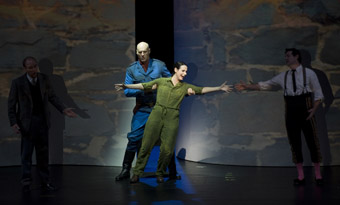
Ainadamar
ainadamar
Oswaldo Golijov’s opera Ainadamar (Fountain of Tears) melodically juxtaposes and merges the music of the Christian, Sephardic and Arabic cultures of Spain’s history in this account of the death of poet and playwright Lorca [see RT81, p5]. It’s a work of reflection: an ageing actress, Maria Xirgu, guiltily recalls failing to persuade Lorca to come into exile with her in 1936. Lorca in turn reflects on his muse, the revolutionary Mariana Pineda, executed in 1831. We witness Lorca’s capture by the fascists, the terror and pathos of his interrogation and ‘confession’, and his execution. But his spirit endures through Maria Xirgu to another generation.
Director Graeme Murphy gives Ainadamar the grand opera treatment. Curved moveable screens by Brian Thompson move about the large Adelaide Festival Theatre stage like giant sculptures. Tim Gruchy projects potent images onto them, effectively evoking the historical moment and Lorca’s symbolism. The all female chorus dances. A huge upstage waterfall (a curtain of real water in odd addition to Gruchy’s projections) evokes the Ainadamar Dountain. The spirit of Maria Xirgu and of the fountain are embodied in a frequently present dancer, who despite the occasional flamenco inflection appears to have wandered in from a Sydney Dance Company production. Overall, the scale of the production and the opera itself didn’t seem to match. The principals sang well but rather quietly, the orchestra seemed likewise restrained, although the pulse of their playing was right. Much of the opera takes the form of intimate duets. It feels like a chamber opera,but here the performers seemed dwarfed by the production.
While guitarist Slava Gregorian appeared onstage early in the work, he and his brother Leonard remained in the pit for the later moment of reprieve, Crepuscule deliriant (“Delirious sunset, an interlude of light and orchestra—guided by two Arab guitars”). Instead of intimacy we got more of the dancing spirit of Jan Pinkerton. Problems of scale aside, Kelley O’Connor’s deep mezzo made for a fine Lorca, Jessica Rivera sang an aptly passionate Maria Xirgu, and the production proved a tolerably cogent introduction to the opera.
the angel & the red priest
More problematic was The Angel and the Red Priest by Adelaide playwright Sean Riley. Vivaldi’s flirtation with the inmate of an orphanage school allowed the priest to break new ground in composing for the soprano voice. But he leaves her behind once he has secured a position with the Austrian court. There’s not much of a story to tell in this ponderous and thoroughly chaste production, imagining little beyond the bare bones of the facts. Dialogue scenes stolidly alternate with passages from Vivaldi’s compositions (led by Gabriella Smart on harpsichord) so that any opportunity of creating a work of music theatre dissipates—instead, it’s a play with music refusing any creative interplay.
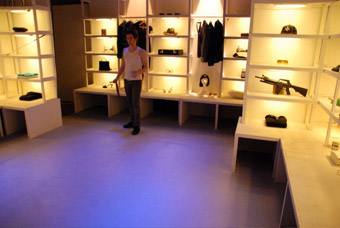
The Border Project
trouble on planet earth
With almost eight hours of material comprising 113 scenes, 24 possible endings, 20 characters and a mere five onstage performers (plus one pre-recorded), The Border Project’s Trouble on Planet Earth is nothing less than ambitious, not least because the audience choose the direction the story will take—inevitably different ones each night. The choosing is made easy by an invention from Matthew Gardiner (creator of Oribotics), a hand-held device like a slightly large-ish i-Pod that, simply moved to different planes, registers your choice from the options displayed onscreen above the playing area and slickly voiced by Amber MacMahon. The glow of red, green or blue rippling through the audience or massing in blocks adds its own frisson and bouts of amusement as responses to the blunt options become wilder and sometimes shocking. The alarming collective choice, for example, to “blow away” a villain is tempered by the parodic outcome, the performers running with the moment as in an edgy improvisation.
The setting, a stylish contemporary gift store, provides the performers with the props (including clothing and matching artillery) to follow through on audience choices. The script, however, is the major arsenal, written by Finnegan Kruckemeyer in collaboration with The Border Project. Much of the writing is parodic, the use of genres (film noir, sci-fi, soap opera etc) allowing the audience to play with formulae they know. Given that the choice-making moments slow the pulse of the action (if only a little because the technology is remarkably efficient) the best writing is brisk (some of the longer dialogues outstay their welcome) and quirky, pushing genres into surreal territory. Enjoyment will possibly hinge on how tolerant you are of surreal slippage into silliness and the dominance of US popular culture genres (in the performance we saw). At its slightest, Trouble on Planet Earth is knowingly kitsch entertainment, at its best it pushes an always dodgy old interactive cinema model into some wickedly amusing theatrical territory and does it with verve. The more demanding the choices, the better. But that might depend on the audience with whom you find yourself making them. “I didn’t like the ending”, could mean much more than it used to.
don’t look back
Don’t Look Back is an elaborate performance installation in which three audience members at a time are largely self-guided (it’s an illusion, but well designed) though a former land titles office (The Torrens Building) decked out as a 19th century Victoran registry—largely of deaths. The feel is distinctly gothic as a series of images—a ghostly bride, red roses, a dark violinist, a journey by water—accumulate via projections, maquettes and installations, the latter inhabited by top-hatted clerks endlessly filing death certificates, or a single official obsessively guillotining documents (the swish and thump you hear on approach). The UK’s dreamthinkspeak have exploited the old building to great effect, distributing the work across small offices, up and down stairs, in an elevator (suddenly missing an exit), dusty basements and, finally, a black hole of a tunnel where the bride at her most ghostly drifts out of the dark. While the student performers ably acquitted their roles, there’s no doubt that a greater age range would have made for a more complete experience.
Don’t Look Back is an anxiety-inducing creation, not because of the imagery which is predictably gothic, or the story—there’s not much to tell—or the meanings of the setting—the work is only very laterally site-specific. It’s because the building is magically transformed into an eerie, disorienting labyrinth.
Malthouse, Moving Targets, writer Marius von Mayenburg, translator Maja Zade, director Benedict Andrews, designer Robert Cousins, lighting Paul Jackson, sound Hamish Michael, costumes Fiona Crombie; Odeon Theatre, Adelaide Festival of the Arts, Feb 29-March 8
Brink Productions and State Theatre Company of South Australia, When the Rain Stops Falling, writer Andrew Bovell, director, dramaturg Chris Drummond, performers Neil Pigot, Carmel Johnson, Ann Lise Phillips, Paul Blackwell, Kris McQuade, Michaela Cantwell, Yalin Ozucelik, designer Hossein Valamanesh, lighting Niklas Pajanti, composer Quentin Grant, video design TheImaGen; Scott Theatre, Adelaide Festival of the Arts, Feb 28-March 15
Ainadamar, composer Osvaldo Golijov, libretto David Henry Wang, director Graeme Murphy, conductor Giancarlo Guerrero, principal performers Jessica Rivera, Kelley O’Connor, Leanne Kenneally, dancer Jan Pinkerton, design Brian Thompson, costumes Jennifer Irwin, lighting Damien Cooper, video design Tim Gruchy, Festival Theatre, Adelaide Ferstival of the Arts, Feb 29-4
The Border Project, Trouble on Planet Earth, conceived & devised by the Border Project, writer-deviser Finnegan Kruckemeyer, director Sam Haren, performers Cameron Goodall, Amber McMahon, Katherine Fyffe, Alirio Zavarce, Jude Henshall, David Heinrich, sound Andrew Russ, andrew Howard, set Matthew Kneale, lighting Ben Snodgrass, zigzag controllers Matthew and Ray Gardiner, video Daniel Koerner, video & controller operation Nathan O’Keefe; Fringe Factory, Adelaide Fringe, Feb 26-March 16
dreamthinkspeak, Don’t Look Back, artistic director Tristan Sharps, Torrens Building, Adelaide Fringe, Feb 29-March 16
RealTime issue #84 April-May 2008 pg. 10
© Keith Gallasch & Virginia Baxter; for permission to reproduce apply to realtime@realtimearts.net
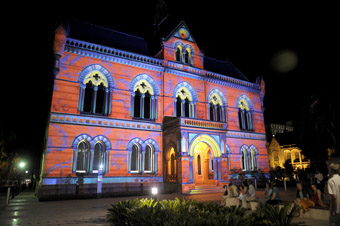
Northern Lights, Adelaide Festival
A STRONG CHILHOOD MEMORY FROM THE 1950'S IS OF ADELAIDE'S FLOWER DAY, AN ANNUAL DAY AND NIGHT FREE EVENT WHEN NORTH TERRACE AND KING WILLIAM STREET WOULD BE AWASH WITH VIVID DISPLAYS BY FLORISTS, GROWERS AND ASSORTED ORGANISATIONS. THE SENSE OF BOUNTY, OF GENEROSITY AND THE POWER OF FLORAL COLOUR AND SCENT WAS ALMOST OVERWHELMING. THE LIGHTING OF THE BUILDINGS ON NORTH TERRACE THIS YEAR BY THE SYDNEY-BASED ELECTRIC CANVAS YIELDED A SIMILAR SENSE OF OCCASION. FROM THE OLD STATE LIBRARY TO BONYTHON HALL, RICHLY COLOURED, PROJECTED OVERLAYS HEIGHTENED AND PARODIED ARCHITECTURAL STYLES.
Each night, large crowds, many children among them, wandered the precinct, quietly enjoying the transformations as each building morphed through some four states every five minutes. The audience itself was fascinating: everyone seemed to be weilding cameras—the latest tiny digitals or long-lensed monsters on tripods or mobile phones of every vintage—and all doing the photographer dance.
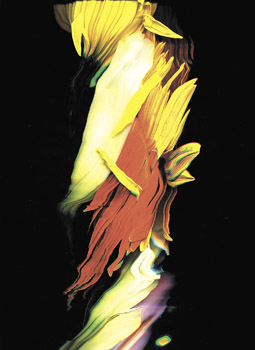
Huang Po-Chih, Flov”er, 2006 (video still), courtesy the artist
In the Anne & Gordon Samstag Museum of Art's show of Contemporary Art from Taiwan, Penumbra (referring to the faint shadow accompanying the eclipse of the moon), Photoshopped flowers danced in wondrous animations, petals and stems twirling and twisting into brilliant, ephemeral sculptings (Huang Po-Chih, Flov”er, 2006, the title an aptly sensual conflation of flower and lover). In Tseng Yu-Chin's Acid Tongue (2007), a four-screen video installation, large images almost reduced to black and white move in slow motion. Each scene evokes communality—a meal, a karaoke party, a car trip to the country, a classroom lesson—but instead of pleasure, which is certainly evident, the mood and tonality are dark, ominous even as faces in moments of awe, commitment or release are stilled and additional light added, the surrounding setting momentarily dropping out. The sense of a memento mori is potent, heightened by the still-but-moving dynamic of this beautiful, demanding work (the opaque title apparently refers to events in the artist's life).
Wang Ya-Hui's video, comprising five works, seamlessly follows a tiny cloud as it descends from the heavens, enters a humble home (once part of the artist's early life), drifts through rooms, past a mirror, up over the stairs and out into a hazy sky. We marvel at this simple magic, the fragility, transparency and the constant vaprous re-shaping of the cloud, and enjoy the pleasure of our inquisitive little visit. Wu Diing Wuu is an indigenous Taiwanese artist. His series of lenticular prints of images of indigenous Atayal people (2007), drawn from anthropological and Imperial Japanese photographic collections, transform as you pass by them—dropping out, for example, a traditional woman weaver but leaving behind her loom and a pair of younger women. People become ghosts and then disappear altogether. The sense of culture lost is palpable, resonating subtly with the more recent domestic imagery of Tseng Yu-Chin's Acid Tongue.
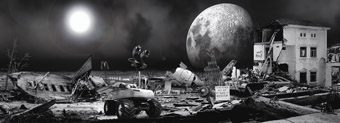
Kuo I-Chen, 41° N, 74° W, from the Survivor project, 2007, courtesy the artist and Galerie Grand Siecle, Taipei, Taiwan
Kuo I-Chin's large scale installation, Lose Contact (2005), is also about a sense of loss—for the sole survivor of an apocalyptic event. The room is dominated by a huge digital print of a ruined, denuded, rubbly Earth over which a massive moon unnaturally hovers. A smaller print shows the moon over a Mars robot. At the room's centre a version of the actual robot swivels its eye as you draw near. Distant radio talk in various languages crackles, crickets click, jungle noises buzz and caw. Close by, a projector and a small globe of the Earth rolling on a horizontal axis throw up images of moonwalkers, newspaper headlines, soldiers and space ships circling the planet, evoking a pre-apocalyptic celebration of exploration. On the floor a large projection of an aerial view of urban Earth—buildings, streets and highways—stutters in and out of view (filmed, apparently, from a camera attached to a balloon-held toy aeroplane). On the large digital print, amidst the overhanging moonscape, a shipwreck and blasted buildings (collaged from Google-sourced images) are handwritten signs: “I'm still here.” “Help! Help!” “Katrina was big. But God is bigger.” Lose Contact conjures a curious mix of boyish sci-fi fascination and very real fear, the intense black and white of its imagery suggesting a documentary of an Earth already lost.
Penumbra's curator Sophie McIntyre tells us about the younger generation of Taiwanese artists represented here. The liberalisation of Taiwan in the 1990s has allowed them to move beyond identity politics to develop a more global outlook, realised through working almost totally with new media. Nonetheless, McIntyre detects a certain melancholy about the rapid cultural and technological transition, a slight sense of disorientation. For her, the word 'penumbra' captures that sense of transition, of a grey area, of a country that is not yet recognised as a country. McIntrye speaks of the “ambiguous poetry” of Flov”er, an apt description for this utterly engaging exhibition as a whole with its ambiguous play of light and dark, of past, present and future.
At the Experimental Art Foundation, German artist Mischa Kuball's Re:Mix/Broca II (Letter/Numbers) [2007] generates more abstract but no less beautiful images. Six Kodak projectors, close to the floor, each rotate, sending out letters and numbers clockwise and anti-clockwise that glide across walls near and far, never going out of focus while changing radically in scale in a mesmeric dance of meetings and near misses. Ten small, burnished metal sculptures, like curled little mountain peaks, momentarily interrupt the projection streams, sparking and bouncing the light around us. The letters and numbers sneak into a neighbouring room where an amorphous projection onto a foil screen generates slow waves and clouds of immersive colour. The synthetic beauty of letters, numbers, fonts (all stripped of their rational functionality) and digital colour distortion is given luminous body in this installation. It makes sense that the artist was inspired by Pierre Paul Broca's pioneering discovery of the brain's speech centre, while the sculptures have been modelled on magnetic resonance images of Kuball's own brain.
At the Jam Factory, in a breath-taking, three-screen animated video work, Last Riot, the AES+F Group from Russia mocks both Soviet Realism and contemporary consumerism. Idealised youths battle innocently, heroically and bloodlessly in exotic locations to the sounds of Wagner and Japanese electronica. The battle gear is stylish street wear, with enough naked flesh to eroticise the players and evoke classical imagery. The impressionistic scenario mingles the filmed battle with animations out of computer gaming detailing terrorist acts, oil piracy and the homegeneity of globalisation. Last Riot appears to enjoy its own lush playfulness more than provide any seriously satirical critique of the narcissism of contemporary popular culture and the concomitant implosion of globalisation, but it's great fun.
Rosemary Laing's large-scale photographic series, to walk on a sea of salt [2004-5], at the Contemporary Art Centre of South Australia, gives Australian landscapes (a salt lake, the bush, a federal government detention centre at night) phantom auras, making them seem as unreal as they are actual, as harsh as they are starkly beautiful. Susan Norrie's Twilight [2005], shot in the Aboriginal Tent Embassy, Canberra, is likewise haunting, the visiting camera moving slowly and casually about the largely deserted site at the end of the day as the breeze pushes at tents and we inspect the detritus of protest and everyday living.
The CACSA show was a satellite exhibition of the festival's Biennial of Australian Art, Handle with Care, a show that included a significant number of environmental works using found materials (including James Darling & Lesley Forwood's immaculately shaped 10.5 tonnes of mallee roots in Troubled Water: Didicoolum Drain Extension, 2008) and others suggestive of the relationship between art and nature (from Bronwyn Oliver, Sandra Selig, Ken Yonetani, Janet Laurence), alongside works of sheer artifice, as in Kate Rhode's epic, kitschy, ironic take on taxidermy, In My Nature [2007-8], with its (too) many elaborately mounted and bejewelled birds and other creatures.
Handle With Care certainly provided evidence of the spread of the new meticulousness in the visual arts with a strong sense of calculated artistry, craft and careful observation, sometimes quite delicate, as declared in the biennial's title. Sandra Selig's framed, real spider webs captured intriguing natural patternings [Universes, 2007], while her videos yielded soft semi-transparent weavings of light. The late Bronwyn Oliver's remarkable copper webbing sculptures as ever made art look like nature. Philipino artists Alfredo & Isabel Aquilizan built a room entirely of purchased goods, creating an ironic, deceptive consumerist solidity [Address, 2008]. Denis del Favero's black and white accounts of the deaths of men destroyed by corrupt systems become film noirish in the intriguing interplay between fact and invention—a huge screen and a tiny one playing out different levels of information [Eclipse (280208), 2008].
Anne & Gordon Samstag Museum of Art, Penumbra, Contemporary Art from Taiwan, curator Sophie McIntyre, Feb 29-April 4; Mischa Kuball, ReMix/Broca II [Letters/Numbers], Experimental Art Foundation, Feb 29-March 28; AES+F Group, Last Riot, Jam Factory, Feb 29-March 16; Rosemary Laing, to walk on a sea of light, Susan Norrie, Twilight, CACSA, Feb 28-April 6; 2008 Biennial of Australian Art, Handle With Care, curator Felicity Fenner, Art Gallery of South Australia, Feb 29-May 4
RealTime issue #84 April-May 2008 pg. 12
© Keith Gallasch & Virginia Baxter; for permission to reproduce apply to realtime@realtimearts.net
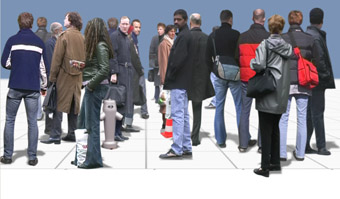
Augenblicke, Peter Aeschmann from Urban Screens Manchester 2007 www.aerschmann.ch
STAGED IN OCTOBER 2007, URBAN SCREENS MANCHESTER 07 BROUGHT TOGETHER A RANGE OF INTERNATIONAL ACADEMICS, ARTISTS, CURATORS, PRODUCERS, ARCHITECTS, DESIGNERS AND URBAN PLANNERS WITH A SHARED INTEREST IN LARGE FORMAT URBAN SCREENS FOR FOUR DAYS OF PRESENTATIONS AND SCREENING EVENTS AROUND MANCHESTER’S CITY CENTRE.
This conference followed the first Urban Screens conference convened by the Institute for Network Cultures in Amsterdam in 2005. Supported by the Cornerhouse and the BBC, Urban Screens Manchester was curated by Dr Susanne Jaschko with a focus on the “creation of content, commissioning/funding issues, curatorship and the architectural possibilities of urban screens in the 21st century” (www.manchesterurbanscreens.org.uk).
Since the 1980s, the roll out of digital networks, the proliferation of mobile phones and the installation of large electronic screens in urban centres, has created novel forms of mediated interaction in public space. Large public screens in particular have rapidly become a symbol of contemporary urban development projects across the world and have emerged as an important site for new forms of commercial branding and aesthetic practice. The global expansion of large-format screens in urban centres was evidenced by a range of case studies presented from around the world, including: Birmingham, Leeds, Liverpool, Manchester (BBC Big Screens); Brussels (Dexia Tower); Dublin (the Digital Hub); Texas (Victory Media Network); Galacia (Fundacion Caixa); Istanbul (Yama); Melbourne (Federation Square); Seoul (Art Centre Nabi); Shenzhen (Shenzen Stock Exchange); Toronto (Dundas Square Filmport Development); Vienna (UNIQA Tower).
large screens & cities of culture
From David Lakin’s (Arup) perspective as an engineer, a large screen is simply an active façade that is integrated with the exterior of a building and provides an opportunity to extend both architectural design and information flows. But large screens have now clearly attracted a new set of expectations in relation to the way culture can regenerate urban sites. In conjunction with mobile media and digital networks, they have helped to reignite the belief that a new interface between art and technology can lead towards more engaged forms of social agency, as well as providing the stimulus for the building of community networks. Jaschko claimed that urban screens are part of new range of communicative technologies for public display such as LED, LCD, plasma screens, large-scale projections and media façades “that offer new and exciting possibilities for artistic and non-commercial use as well as for community development and play” (www.manchesterurbanscreens.org.uk). According to Michael Joroff (MIT), the creative function of large screens oscillates between that of shaping the environment through textual narratives, to a looser engagement with images and sounds that are otherwise considered invisible or non-material. This suggests that large screens operate across a spectrum ranging from what ES Turner, in his classic text The Shocking History of Advertising, called “sky shouting”, to a more subtle emission of signals and spatial ambiances that only register in the background of people’s consciousness.
This uncertainty as to the status of the screen is reflected in the fact that there are relatively few instances of corporations allowing ‘their’ large screens to be used for aesthetic or social purposes (for instance, the ‘Big Screens’ in the UK, CASZuidas in Amsterdam, NABI Art Centre in Seoul and Federation Square, Melbourne). In Seoul the majority of large screens are used as a commercial tool for capturing public attention. Despite the preponderance of utilitarian application, Joachim Sauter argued that the large screen is now part of a broader digital agora. In an optimistic tone he asserted that any new technology that expands the levels of interaction and identification is also creating a space that generates new social experiences. How do we grasp the significance of these experiences? And how are large screens enmeshed in broader processes of social change? As Gunthar Selichar noted, the stress on mobility, consumption and surveillance in contemporary society has rendered the condition of being static as equivalent to being homeless, multiplied decision-making moments, and extended the range of personal experiences that are open to public scrutiny. Is the large screen to a public square what a television is to a lounge room, or even a video monitor to a gallery? The proportions maybe consistent, but is the function, let alone the effect, the same? The great hopes invested in large screens have yet to be tested. However, the Urban Screens Manchester conference and art events provided an opportunity to witness the showcasing of recent practices as well as observe the commentaries on the historical precedents and cultural implications of large screens.
historical precedents
To make sense of the newness of large screens there is inevitable comparison to older communicative devices. For instance, the function of large screens is often described as the new ‘Digital Village’ notice board. Throughout the conference there were numerous attempts to decode images and information on large screens as if they were a conventional form of text. The activity that occurs on these Screens was thus compared to the more familiar forms of writing, scribbling, creating narratives, and telling stories. Alternatively, the interpretation of the visual content on large screens was framed by contemporary visual concepts of abstraction and sonic theories of ambience. In particular, the non-narrative imagery that artists construct for large screens was contrasted to more instrumental uses of large screens by highlighting the way their imagery operated as creative and critical interventions into the urban landscape. These broad interpretative frameworks suggest that a specific language for comprehending the visual and aural impact of large screens is yet to emerge. Large screens appear to be ‘popping up’ everywhere, but their cultural significance is often registered in a loose and uncertain manner.
If there is a consensus on the ubiquity of the Large Screen, there is also much work to be done on developing narratives of how they arrived and what other historical forms they are related to. Uta Caspary (Humboldt University) approached the historical appearance of digital media as part of longer tradition of ornamentation and public scripture. From the triumphal narrative of the Pharoah’s conquest to the use of stained windows in Gothic cathedrals, Caspary argued that there was a constant effort to use architectural façades as surfaces for storytelling. In his keynote paper “Elements of Gigantology or an Archaeology of the Urban Screen”, Professor Erkki Huhtamo (Design/Media Arts, UCLA) emphasised the importance of historicizing public screens as information surfaces within changing cultural, historical, social and ideological frames of reference. Huhtamo highlighted the antecedents of contemporary urban screens and their intermedial relationships with other cultural phenomena, by providing a pre-history which ranged across: Kircher’s mirror projections and katoptric tricks; Samuel van Hoojstraten’s shadow projections: the illumination of public monuments in the Son-et-lumière presentations; the use of magic lanterns and limelight technology in the Automatic Stereoptican in the US in the 1860s in the real time reportage of news; the development of the dynamic screen as ‘adscape’ in nineteenth century urban messages such as fly-posters and sky advertising; and Albert Speer’s use of anti-aircraft spotlights in the ‘Cathedral of Ice.'
In mapping this historical terrain, Huhtamo introduced us to the “hypothetical field” of “Screenology”, a methodology geared to mapping and evaluating contemporary manifestations of the urban screen. Huhtamo is interested in posing the questions: where have giant public screens come from, under what cultural conditions have they emerged, what are the intermediary relationships that facilitated their development and finally to examine the material and discursive manifestations of their emergence? Central to this genealogical process is the importance of discursive notions of urban screens, such as Albert Robida’s XXème Siècle (1882), which in their fantastic prophecies of a screen-saturated society, conveyed the hopes, fears and dreams of a rapidly transforming public media-sphere.
Citing the recent work of Tony Oursler, Rafael Lozano-Hemmer and Krysztof Wodiczko, Huhtamo concluded with a reflection on the extent to which the historical attentiveness of “Screenology” has already been internalised by contemporary artists. Indeed, Oursler’s Influence Machine (first installed in Madison Square Park in October 2000), which recalled 19th century sound and light projection in its captured voices and images of contemporary and historical ghosts, would seem to be a model for a historicist and self reflexive exploration of the impact of screen-based technology on our daily lives.
In his paper, “Who’s Afraid of Blue, Red and Green”, with its invocation of the work of abstract expressionist painter Barnet Newman, artist and academic Professor Günther Selichar (Media Arts, Leipzig) mapped a somewhat different (art) historical trajectory. Presented as part of the Focus Session “Towards a New Aesthetic of Screen Art in the Urban Environment”, Selichar proposed a self-consciously formalist approach to the politics of public space, drawn from his own explorations of the relationship between painting and new media practice. Selichar presented his recent project Who’s Afraid of Blue, Red and Green (2004), a collaboration with Creative Time in New York, which was displayed on the NBC Astrovision screen at Times Square. Devised as an intervention in what he described as the “invasion of the civic territorium” by commercial screen-based advertising, the project took the form of an online competition and public art project “based on the elementary visual building blocks of digital display screens”—the three pixel colours that ground video, computer and television screens. Participants were invited to design an animation comprised of 15 vertical compositions in blue, red, and green, with the three winning entries featured on the last minute of every hour as part of The 59th Minute: Video Art on the Times Square Astrovision. (See the ‘Blue, Red and Green’ website for a full description and project gallery http://brg.adm.at/.)
Drawing upon Barnet Newman’s ‘zip paintings’ from the 1960s, and playing with the notion of the test pattern, Selichar asked participants to both reflect on “our attention to the pervasiveness of screens in our daily life and the complexities that underlie them”, and to intervene in the privatised media saturation of the urban environment through the insertion of spaces of “pause.” This self-reflexive return to a more contemplative, ambient, even auratic, model of production and consumption then, constitutes a kind of “anti-avalanche” of information, contesting the density and inevitability of the mobile adscape historicized by Huhtamo.
conceptual mapping: curatorial dtrategies
One of the crucial questions that has emerged in relation to the introduction of large screens is their potential to initiate a new kind of social aesthetic that goes beyond conventional forms of public broadcasting. Large screens have been seen as dazzling surfaces that not only captivate the 'wondering crowds' but also as sites that inspire new interactive roles. To attract and connect viewers, artists and curators have been forced to conceive of new strategies ranging from ambient imagery to mini narratives. One of the distinctive features of these new strategies echoes the point made by Gerz—the singular artwork that claims an auratic status and requires display as a precious object, is less likely to have the necessary multiple and open forms of communicative functions in real time and the social after-effects that defines the success of an interactive work.
Curatorial models that were presented ranged from small artist collectives such as Trampoline and Transmedia, to gallery spaces such as Art Center Nabi, Seoul, and large-scale commercially sponsored initiatives such as Victory Media Network in Dallas, Texas. This was a salutary reminder that curatorial strategies are context specific and informed by the negotiation of varying economic and content-related issues. Using the Transmedia series of urban screen interventions as case studies, freelance curator Michelle Kasprzak, in her paper “Irreproducible Context: The Challenge of Curating for Urban Screens”, spoke of the expanded audience for artists afforded by the emergent large-screen format, but also of the “poignant fragility” lent to art pieces occupying a space alongside big-ticket events and high-end advertisements. Arguing that the energy of this expanded audience cannot be duplicated, she stressed the importance of ongoing negotiation with commercial interests as a key part of the curatorial role. This sense of the ‘benefits and tyrannies’ of curating for temporary and permanent big screens, was equally central to Professor Mike Stubbs (FACT, John Moores University, Liverpool), who emphasised the importance of curatorial strategies which balance topical intervention and the formation of partnerships as conduits for artistic content. This notion of the curator/producer as negotiator between different stakeholders led to robust discussion around issues of censorship during question time, with Mike Gibbons, Head of Live Sites and UK Coordination for London 2012, stressing the responsibilities and sensitivities incumbent on the curator in programming in public space, for a diverse and mobile audience. In short, the discussion reiterated the points that have been well rehearsed in the public arts domain—that art is both implicated in the social rules, tastes and conventions, and provides an opportunity to critically reflect on their limits.
This issue was also taken up by Dooeun Choi, curator of Art Center Nabi, who presented a range of recent projects screened at COMO, Nabi’s networked urban screen, launched in 2004 and located in Seoul's SKT-Tower and Daejeon SKT Building in Korea. As curator of a privately funded gallery, screening non-commercial content, Dooeun is able to explore COMO’s potential as a live window presenting interactive installations and networked art projects, which intervene in the commercial density of the Seoul adscape, and are geared toward proactive user experiences. Choi emphasised her responsibility to gradually introduce what might be challenging content to a public unused and perhaps uninterested in creative media. COMO tries, she argued, to “reclaim the humanity of media saturated and impersonal cities by recovering and celebrating the individual as a unique player.” However, this process must be incremental, moving forward in ‘small, yet persistent, ways.’ Choi discussed, for example, Nabi’s participation in the real time transmission of Zhang Ga’s The Peoples’ Portrait, between large screens in Adelaide, Seoul, Beijing, Linz and New York. Utilising custom-designed kiosks across multiple sites, the Peoples’ Portrait project enabled passers-by to take snapshots, which were transmitted via the internet to an image database and then retrieved and displayed on large screens across the participating sites, producing a globally interactive and collective portraiture.
The curatorial issues facing Kristin Gray, Director of Victory Media Network, are somewhat differently calibrated. Victory Park is underwritten by exclusive corporate partners, and their current partner, Target, is both a sponsor and a major content creator for Victory, screening a range of artist commissioned advertisements for the site. This commercial material is screened alongside non-commercial content, in a 50% artistic/50% commercial ratio. This balance of public/private content, argued Gray, fulfils Victory’s remit as a mix-use development which aims to “engage the public, educate the community and support artists.” This model of targeted commercial investment supporting the production and creative and community content, is to some extent, determined by the sheer scale of Victory Park, which is home to 4,600 square feet of LED screen space, with 8 vast mobile screen panels, utilising rollercoaster technology to be synchronizable with artists’ video designs to create complex and sophisticated spatial interactions. Touted as a “revolutionary multi-sensory outdoor art centre in one of the most significant master planned urban developments in the history of the Southwest Region”, Gray emphasised the Park’s dual role as both an entrepreneurial space and as a public plaza, and the importance of having sponsors that embrace the Park’s ethos as a site for building community.
According to David Gales (Vantage Technology, which provided assistance in integrating the technology): “A new public media paradigm is being created and, in some ways, still being defined. Whatever it will become, Victory Park is not intended to become another Times Square. Culture and art, rather than advertising, is the driving force of its content engine. (Quoted in Brill, L, 2007, “Victory Park: Deep in the heart of Dallas”, Signs of the Times, June: 92-93.)
The major issue, however, facing Gray in sustaining this unique digital gallery, seemed to be one of content—or more precisely, how to get enough of it. Aside from the Target advertisements, Victory has done little commissioning to date, and Gray stressed that she was exploring ways to attract more creative and interactive content through competitions and global calls for content.
The curatorial strategies outlined in the conference brought into sharp relief broader changes in cultural space and civic agency. The emphasis on the curator’s capacity to ‘negotiate’, the re-definition of citizens as ‘players’ and the new public/private partnerships, are all suggestive of pragmatic shifts in the cultural terrain.
key architecture & applications of surfaces
Animated architecture, or the transmutation of entire buildings into moving image screens, has been presented as a powerful tool that can both hybridise public space and generate ephemeral imagery. The possibility for an individual to intervene in the visual appearance of the skin of a building through interactive media, and to thereby play with the urban terrain rather simply respond to it, has presented a new range of questions regarding both the aesthetic boundaries of buildings and the levels of agency that these new media platforms enable. The visual effects for the general surroundings is also poised between delight for the opportunity to play and disdain towards another gigantic form of visual pollution. Alexander Stubli? from the artist group Mader Stubli? Wiermann, presented a number of projects dealing with time bound media such as light, video and sound, in the public sphere. The LED façade cloaking the UNIQA Tower in Vienna (2006), for example, forms a seamless, integrated grid around the building. Designed as a kind of post-production enhancement of an existing building, LED grid twists and turns in illusionary morphing patterns, visible at night as a light installation.
In her paper “From Architecture to Metadesign”, Els Vermang of LAb[au] presented a case study of the Dexia Tower in Brussels. The tower has 4200 windows that can be individually colour-enlightened, by RGB-led bars, turning the façade into an immense display. Extending the possibilities of animated architecture demonstrated by earlier projects such as Toyo Ito’s Tower of Winds (Yokohama 1986), the light display is programmable and allows for direct public interaction. At the base of the tower, a station is mounted where the public can programme architectural compositions. Once a composition is created, it can be sent as an electronic postcard with a snapshot from the tower, taken from a distant location. In a new project, Weather Tower, the tower will forecast the following day’s temperature, cloudiness, precipitations, and wind, by using colors and geometrical patterns to visualize these data.
The common theme linking these projects is their receptiveness to the use of technological media in architecture to both represent and generate new social relationships in public space. In this respect, architects working with LEDs, as much as large screen operators, could learn from a range of contemporary public space art projects, such as 10_dencies by Knowbotic Research (Tokyo and Berlin, 1997), and the various Relational Architecture projects of Rafael Lozano-Hemmer, where the intent is to develop experimental interfaces capable of producing a range of experiences, including promotion of qualities such as sharing, co-operation and negotiation between individual and collective agency. Works such as Lozano-Hemmer’s Body Movies (Rotterdam 2001) provide exemplary instances in which strangers are invited to participate in a project that stretches communal relations in a public space.
transforming public space?
In his keynote address, Jochen Gerz pondered over the form that public space assumes in contemporary life. He suggested that it is not something fixed or static, but rather something plastic and incomplete like a painting that is painted or a book that is re-written everyday. Gerz noted that public space is both a container for social activity and a medium for creating sense. From this perspective, the form of public life is both historical and ephemeral; it holds knowledge of the past like a bookshelf, but, like a daily newspaper, it is constantly being updated. Jean-Claude Bustros (Hexagram) also claimed that screen technologies provide new possibilities for people to reshape public space. He suggested that the incorporation of media architectonics and interactive informational flows would lead to hybrid landscapes and dynamic forms of social exchange. Public space would no longer appear as a fixed environment but more like a stage that would be transformed by the actions of its users. Gerz argued that changes in the social uses of public space also affect the frameworks for defining creativity. Hence the aesthetic distinction between what is original and common that was central to art history would need to be reconsidered in light of the plural and unpredictable forms that art assumes in public life. The question that continutally emerged throughout the conference was: in what way do large screens make a difference to public life and extend the possibilities of art?
Professor Joachim Sauter (University of the Arts, Berlin and UCLA), the founder of ART + COM, opened the “Urban Screens as Community Interface” session with a selection of projects which also focus on the integration of screen technologies and the built environment. Arguing against the effectiveness of the screen as a flat surface displaying pre-rendered content, Sauter strongly advocated a deployment of LED technology which is installation based, and hence experiential and site specific. Sauter presented ART+COM’s most recent project, Duality, which is under development in a building complex in downtown Tokyo, on the bank of an artificial pond at the exit of the metro station Osaki. In attempting to augment the experience of bodies traversing space and provide moments of contemplation in the information-rich city, the project investigates the putative duality of paired concepts such as liquid/solid, real/virtual, and water ripples/light waves. Pedestrians walk over a 6 x 6 meters large LED plane, installed at the edge of the water. The LEDs are covered with translucent glass diffusing their light. With their steps, the passers-by provoke virtual waves on the LED plane, computed in real-time. When these waves hit the edge of the pond, they are extended into the water as real ripples. Sauter argued that this seamless integration of the virtual and the material runs contrary to the usual practice of art in public space, in that rather than imposing an identity on the space, the transformative power of Duality will be an integrative augmentation of an existing urban context.
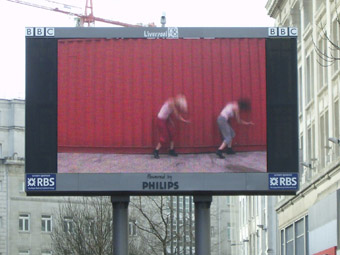
moves 08, BBC Big Screen, Liverpool
This conceptual and formalist approach to public space—with the curator as designer—contrasted starkly with Mike Gibbon’s notion of public screen broadcasting as “animating” public space. Gibbons has spent the last five years building the Big Screens in the UK for the BBC as part of the partnerships with towns and cities. As part of the original Commonwealth Games urban plan in Manchester, large screens were introduced with the explicit intention of both animating public spaces that were in a state of neglect, and to provide a focus point for people to congregate. The Big Screens were intended not just as outdoor venues for sports spectacles, but also as a catalyst for other kinds of communal experiences. The Big Screens are now installed in the city centres of Manchester, Birmingham, Liverpool, Hull, Leeds, Rotherham, Bradford and Derby, with a further roll-out expected across the UK. Drawing on BBC content and creative content from partnerships with local cultural institutions, such as the Cornerhouse in Manchester, the BBC Big Screens have developed through partnerships with cities, their local councils, arts organisations, education bodies and regional development agencies—and hence, function according to a strong social remit of community building and cultural re-development. Much of the programming of the screens is structured around events, such as major sporting events, in an attempt to bring people together in public space. As the Public Space Broadcasting project moves into a new phase of development, Gibbons emphasised the need for evaluative processes to assess the ways in which this outdoor phenomenon been received—asking: what can we learn from public reactions; if it the same everywhere in the world; and can one country and one culture learn from another?
Stephen Brennan, Director of Marketing and Strategy of the Digital Hub Development Agency in Dublin, was also interested in the ways in which large-screen technologies might function within larger public initiatives to bring communities together. The Digital Hub is a €250M Irish government initiative to create a leading knowledge community built around digital media. Brennan has worked on developing programmes that bring together the creative and technical aspects of digital media. The Digital Hub project has been one of the first sites in Ireland to use an interactive urban screen to further this process. Located in the historic Liberties area of Dublin, this initiative will create a mixed-use development, consisting of enterprise, residential, retail, learning and civic space over the next decade. Brennan discussed how the urban screen acts as a creative outlet and also a device by which the community can address some of their concerns about the development/project via SMS or the internet to the screen directly. Hence, the Hub functions as both a platform, forging links between local authorities, local arts schools, museums & galleries and the wider artistic community, and as an interface via which the community can track, assess and discuss the effectiveness of the project itself.
interactive possibilities
Throughout the conference, there was a strong emphasis on possible future directions for public interaction with screens, with most curators and producers focussing on this as a key area of development. Dr Paul Coulton (Infolab21, Lancaster University), who has worked extensively with mobile applications and programming, discussed the manifold possibilities now available in the exploration of inter-media integration of large screen projection and the development of mobile social software with a particular emphasis on mixed and augmented reality utilising location. Arguing that play is an important part of cultural identity, he also, like Dooeun Choi, drew on the idea of participants as players in order to define the new forms of social interaction crossing borders between the real and the virtual world and extending the every-day perception of the city. However, going against the grain of the hype of a placeless virtual world, Coulton also stressed that in the new game programmes and locative narratives there is both a return to emphasising the significance of context and the particularity of place as well as a greater emphasis on the ethical responsibilities of individual identities.
Academic, artist and curator, Maria Stukoff (International Centre for Digital Content, John Moore’s University, Liverpool), presented her doctoral work on the ways in which proximity-based interfaces using mobile telephony might transform urban screens as surfaces for social networking, building a public/social choreography. Stukoff argued that where architectural face-lifts effectively regenerate the urban landscape, artists are able to “engage communities therein: translating locality into enriching content generating artefacts, live events and public art.” The proliferation of wireless communication technologies has become a digital canvas for artists to utilise. She presented her current project, blu_box, an interactive Bluetooth system created in collaboration with Jon Wetherall (ONTECA, Liverpool) exploring game-play, social intervention/interaction and live performance through mobile telephony. By visualizing dataflows, the blu_box system maps the sensitive and complex relationships that exist between virtual and physical environments. Projected upon a large urban screen, Stukoff argues the blu_box network “renders visible the invisible spatial condition of wireless communication flowing between mobile devices, the public and the city in animated moving images.”
Jury Hahn and Dan Albritton (Interactive Telecommunications Program, New York University) also exploit these possibilities for supporting new context-aware interactions. Their MegaPhone project, which screened in Manchester during the conference, is a phone-controlled, real-time, multi-player collaborative gaming platform for big screens in public spaces. Players join the game by making a regular phone call, and they can see their input (either voice or keypad) immediately and use their button presses and voice to control an interactive experience on the screen. Applications on the screen currently include action-oriented games, trivia contests and realtime voting systems. Hahn and Albritton have developed MegaPhone as a means of using new types of gaming to create ad-hoc social connections between strangers in a public space, thereby “turning pedestrians into players.” Significantly, MegaPhone also has trans-national possibilities, in that phones from any service provider in any country can be used. Hahn and Albritton emphasise the possibilities for the global networking of screens and opening up potential cross-cultural public spheres.
future directions: from big impact to small gestures
In her introduction to the Focus Session, “Urban Screens as a Community Interface”, Professor Beryl Graham (Design and Media, University of Sunderland), emphasised the importance of problematizing notions of community in the assessment of the impact of screen-based installations in public spaces. Large screen infrastructure demands significant funds, and in many of the cases cited in this essay, it includes public moneys. To justify such expenditures local governments will need to measure the performance of public screens against civic indicators of social cohesion and cultural renewal, as well as aligning them with their existing economic strategies for developing tourism, attracting inward investment, and promoting the city’s distinctive identity. Graham highlighted the need for rigorous audience research in order to move beyond speculative reflection on the social impacts of urban screens, but also argued for an approach to audience testing which is not reductively demographic. She briefly sketched a hybrid model of artist-based observational studies as an alternative; an amalgam of practice and theory to capture different styles and levels of participation and engagement.
We share her concern for empirical investigation of the impact of large-screen technologies, which is attentive to cultural, economic and social differences. Large Screens represent a critical new intersection of social, cultural and economic interests in the public realm. Urban Screens Manchester demonstrated the global roll out and diverse applications of this technology. But many key questions remain to be addressed at the next Urban Screens conference to be held at Federation Square in Melbourne, 2008. What is “public space” in the context of media-saturated cities? What is the relationship of “public culture” to the new modes of communication and display? How should the emerging genre of “public space broadcasting” be regulated? What are the roles of existing media producers, advertisers, artists and established cultural institutions in shaping this new dimension of public space? What other values and voices might be relevant? Where are “the public” to be found today—in the street, watching TV at home, online, or somewhere in between? What are the consequences of the new forms of mobility for public life, and what are the potentials for using media to create new dimensions of public space and civic agency?
This report was written by Meredith Martin, Sean Cubitt, Scott McQuire and Nikos Papastergiadis and edited by Meredith Martin.
Also in this edition: “Making light of winter”, about the screen and light event coming soon to Melbourne's Federation Square and featuring a screen installation by Canadian filmmaker Srinivas Krishna.
Urban Screens Melbourne 08: Mobile Publics will be held at Federation Square, Oct 3–5. Registrations: http://www.urbanscreens08.net/
The moves08 movement on screen and dance film festival will have its shorts program shown on BBC Big Screens across the UK, April 5-25. www.movementonscreen.org.uk
RealTime issue #84 April-May 2008 pg. 30
© Sean Cubitt; for permission to reproduce apply to realtime@realtimearts.net
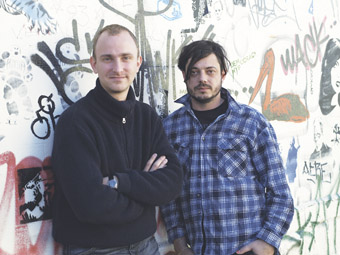
Marius von Mayenburg, Benedict Andrews
“WHEN WE STARTED, BENEDICT AND ME, WE BOTH WANTED TO START WITH NOTHING, FROM SCRATCH. SO WE DECIDED TO JUST GO INTO A REHEARSAL ROOM WITH ACTORS AND SEE WHAT HAPPENED. THE ONLY THING WE KNEW THAT WE WANTED TO TRY OUT WAS THIS GAME OF HIDE-AND-SEEK. I’D HAD THIS EXPERIENCE SOME YEARS AGO. FRIENDS OF MINE HAD JUST MOVED TO A NEW APARTMENT AND IT WAS NEW YEAR’S EVE. THE APARTMENT WAS HALF WAY EMPTY. THEY’D JUST MOVED IN. AND WE WERE A BIT DRUNK AND AFTER MIDNIGHT WE JUST DECIDED, LET’S PLAY HIDE-AND-SEEK AND SWITCH OFF THE LIGHTS. SO, WE WERE A GROUP OF MAYBE SIX OR EIGHT GROWN UP PEOPLE PLAYING IN THIS SPOOKY, EMPTY APARTMENT. AND IT WAS JUST AMAZING, ALL THESE EMOTIONS THAT CAME UP. ALL THESE FEARS OF BEING FOUND AND MAYBE NOT BEING FOUND AND HAVING TO STAY IN THAT HIDING SPOT FOREVER. OR MAYBE EVERYONE GOES TO A BAR AND THEY FORGET ABOUT YOU.”
I’d asked German playwright Marius von Mayenburg about the origins of Moving Target, the Malthouse commission which he wrote in collaboration with Benedict Andrews who had directed his Fireface for the Sydney Theatre Company and Eldorado for Malthouse, and whom he’d worked with at Berlin’s Schaubuehne. He continues his New Year’s Eve story:
“And this strange thing happened. We locked in one guy. It was a cruel, childish thing to do. And it was a game first, but in the end he started crying. It was this strange thing that just erupted within us. And I was really fascinated by all these emotions that came up with the game and I thought I’d like to deal with that onstage and see what it gives. And I think what’s really great about the game is that it provides the structure, the structure of someone counting and structuring time. And then the moment of the hunt. And then in the end, you have all these people standing in a room that they changed because of their ways of hiding. And so, all those different states—I found how amazingly well that works on stage and that it really draws you in.”
In the Melbourne workshopping of what would become Moving Target, long before there were words or a script took shape, von Mayenburg explains that the actors “would play hide-and-seek for three hours. And after the first two rounds, you thought, okay, they are all the hiding spots. There are no more in the room. And then they would come up with new stuff, all the time.” In performance, the demand of playing the same game over and over and having to invent new solutions looks as exhausting as it as fascinating. Von Mayenburg says, “The exhaustion of the actors in the workshop was important. Because only after you reach this kind of emptiness of total exhaustion, can you start to invent hiding spots in an empty room.”
Von Mayenburg started writing initally, he recalls, “about disappearing children and one child who doesn’t want to come out of his hiding spot. In the end, I thought no, I want to change the perspective of the text. I want to take on the parents’ perspective. So that’s why this story of a society scared of its children emerged. I wanted to have a counterpoint to the game playing. And that’s what I wrote 2006 to 2007.”
For von Mayenburg the long time between workshopping in Melbourne and writing in Berlin and meeting with his collaborators again allowed him time to get some distance from their creation. “In August 2007, we had the games and we had the text and we were trying to put it together. For me, it somehow worked but I couldn’t really tell how. So we tried all kinds of different structures. In the end we’re not using all the text I’ve written. We cut some things. So that was last August and then we had another three weeks to put it all together.”
In the emerging play, the game became, in effect, a defence mechanism for a group of child-like adults who compulsively turn to it when in fear of the girl-child whose consciousness they imagine they inhabit, possibly as her parents. It’s a clever dramaturgical contortion, carefully structured so that the audience has to work at putting together the scenario—an apparently perverse inversion of the notion of the inner child. That flips again in a frightening and suspenseful climax.
“What you said about the audience having to work”, says von Mayenburg, “I think that’s one of my ideals. Also for myself as an audience member. I really enjoy having to fill gaps with my own fantasies, my own associations. In this play, the audience asks, Who are these people? Are they the parents of the child? All six of them? And who’s the child? But that’s something that I like, I find challenging.”
Not only is there text left over from edits in rehearsal, but many versions of the hide and seek game. “The great thing is that now because they have this background of material that we don’t use, the performers can change little things all the time. They’re really free. In the final rehearsals we could just grab things as if from a pool of ideas and say, try this again at that spot. And the performers immediately knew what it was about and they could do it. And also, they keep inventing details. And I’ve never seen that in any other production. They came up with new stuff yesterday. And I’m sure tonight [during the Adelaide Festival premiere season] will be a little bit different again.”
Just as frutiful, if doubtless challenging, was the limited number of physical tools the performers had at their disposal for improvising: their clothes, a table, a tablecloth, a long red lounge, a piece of carpet, a chair, a sleeping bag and a couple of toys. “All these things were in our rehearsal room”, explains von Mayenburg, “an old church used by Malthouse as a rehearsal space. They all belong to Malthouse, but were just there to make the place a bit more comfortable. We thought, well let’s start to use them to play hide and seek. So all the things you see on stage, they were all there, even the sleeping bag.”
I ask how von Mayenburg responded to the collaboration. “I really enjoyed it. It was somehow liberating to have all those people contributing to the process. The actors really gave a lot of input. Benedict and I talk a lot. He spends a lot of time in Berlin because he’s working there. From the very first moment we met each other we started talking intensely about theatre and how we like to do it, on an abstract level, but also very precisely and concretely when we work together on shows. I think I wouldn’t have been able to write this text just on my own. So much belongs to this process and to these long walks that Benedict and I had through Berlin talking about theatre, about the whole shape of the play, about what you see.”
Has the Moving Target experience, I ask, influenced von Mayenburg’s subsequent writing? “I’ve written one play after this and I’m just writing another one now. And I realise that I can’t just go back to those very closed, claustrophobic plays I wrote before Moving Target. I was always looking for a way out of that. Even Eldorado is a claustrophobic situation with a man being caught in his own lie. I realise that in writing those plays, one of my ideals was to create closed worlds on stage and a strict logic of character. And I always try to write characters that I would like to see or to play myself on stage. I realised that for some reason I’m missing a sense of lightness. And even though Moving Target is probably not the funniest of plays, it has a lightness of form, I think. This is something I’m looking for now.”
Working from improvisations also seems to be having an effect on how von Mayenburg sees his writing: “I wrote Moving Target in five days because I had the whole background of the workshops. I could just grab anything that came into my mind and use it for the play. I heard on the news about the child in an adventure park that had been eaten by crocodiles. I just took it because it was there, and also the whole story of a baby in the box that people mistake for a bomb. That was a story from Israel that friends told me. I could use anything that came up and it somehow fitted into the story. I think the production of Moving Target has this sense of improvisation as well. And that’s what I like about it.”
There’s a rare, centrally placed monologue in Moving Target with a much less improvisatory feel, if only in the writing, when Julie [Forsyth, the performers use their own first names] tells a story about coming across an ideal picnicking family. They have guns and knives for hunting and she’s astonished that the children don’t shoot their father or stab him. In fact she’s ashamed that her own life can’t match this peculiar ideal. Where’s that coming from, I ask von Mayenburg. He laughs and explains:
“When I wrote it, it was like a joke. If you accept that thought that kids are dangerous, it somehow subverts the whole structure of the family. A lot of plays that are written in Germany at the moment are about child abuse, about dangerous parents or the dangerous uncle and the child as a victim. Of course, in a way, the girl in Moving Target eventually becomes a victim as well. But it was very joyful to turn it around and say kids are dangerous and parents are scared. I think a lot of parents are scared of their children. You don’t know what they’re thinking, what they know and what they don’t know.”
The Marius von Mayenburg-Benedict Andrews-Malthouse collaboration on Moving Target strikes me as a potentially pivotal moment for Australian theatre, one that transcends nationalistic cultural borders. It’s certainly not unusual in Australia’s contemporary performance scene, but it’s otherwise rare enough in theatre. Von Mayenburg comments, “Some weeks ago I spoke with a French journalist. He asked me about if I liked the French theatre and what I think about French writers. It was all about comparing Germany and France as theatre countries, theatre traditions. I got really bored with it because I think I have so much in common with people who make theatre in other parts of the world—like with Benedict and also a friend of mine who’s acting and directing in Argentina and another who’s directing in France. They are much closer to what I do, what I think. They are closer friends than colleagues in Germany. And their theatre is so much closer to my ideals than some shows produced by colleagues in Germany. One of the reasons I really enjoy working with Benedict is because we don’t have to think about the national thing. When I’m here I don’t know in what kind of context this play will fall. Of course, he has seen a lot of theatre in Germany but it’s not important that it’s German… In the end, there’s a chance that this openness can become an identity as well. It’s not about losing [national] identity by opening all the gates and getting lost. You get more than you lose, I think.
See the review of Moving Target on page 10.
RealTime issue #84 April-May 2008 pg. 13
© Keith Gallasch; for permission to reproduce apply to realtime@realtimearts.net
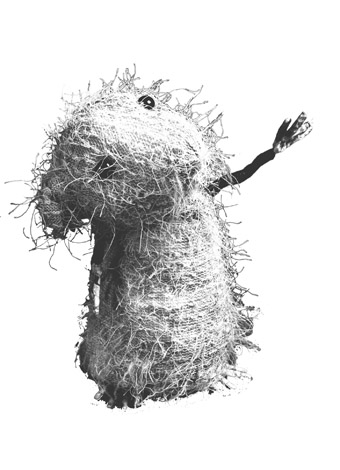
Goodbye Mr Muffin, Teater Refleksion and Teatret De Røde Heste
photo Jan Rüsz
Goodbye Mr Muffin, Teater Refleksion and Teatret De Røde Heste
An imagination freed by the arts is often equated with a return to childhood openness, to a period before experience has been categorised and culturally coded, made safe, useable and sometimes blinkeredly loyal. In this edition of RealTime, young people are the subject of works that challenge our imaginations. Our cover features the Malthouse production of German playwright Marius von Mayenburg’s Moving Target [review p10] which, with child-like glee, gets into the minds of often childish adults terrified by their mysterious offspring. In an interview [p13], von Mayenburg ponders the current focus on children as victims. In his play he reverses this expectation in a series of shocking twists. In his ASSITEJ 2008 international festival of performing arts for young audiences, artistic director Jason Cross has programmed some works not originally designed for children, challenging the notion of ‘appropriacy’, while staging others that profoundly evoke the open imagination of the child [p14]. The image on this page is of the central figure in Goodbye Mr Muffin, a Danish production in ASSITEJ 2008 for children 6 years and up about coping with death, in this case of an aging pet. Cross sees a play like this as being as much for adults as children. In Elissa Downe’s successful new Australian feature film, The Black Balloon, an adolescent struggles with his sense of responsibility for his autistic brother. In Hard Rubbish, directed by Adam Lemmey and nominated in nine categories in the 2008 South Australian Short Screen Awards [p26], an 11-year-old girl throws out her embarrassing family with the rubbish. At the 2008 NOW now improvised music festival, Ross Bolleter, an artist who has turned the playing of ruined and near dead pianos into an artform, introduced child players to its pleasures [p41]. Anything is possible.
RealTime issue #84 April-May 2008 pg. 1
© RealTime ; for permission to reproduce apply to realtime@realtimearts.net
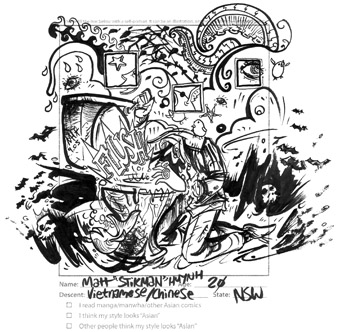
Matt Huynh, from Komala Singh’s All Draw Same anthology
courtesy the artist
Matt Huynh, from Komala Singh’s All Draw Same anthology
WHILE THE RESOURCES BOOM APPEARS TO BE FEEDING AN ARTS RESURGENCE IN WESTERN AUSTRALIA, AN EQUALLY SIGNIFICANT ARTISTIC BOOM SEEMS TO BE REACHING CRITICAL MASS ACROSS WESTERN SYDNEY. WITH THE EMERGENCE OF A DIVERSE RANGE OF NEW AND REVITALISED SPACES, NEW COLLABORATIONS, AND EXCITING VISIONS, COULD WE BE WITNESSING THE RISE OF WESTERN SYDNEY AS A MAJOR PLAYER IN THE NATIONAL ARTS SCENE?
parramatta riverside’s 20 years
One of the great success stories of the arts in Western Sydney has been Parramatta Riverside Theatres, which celebrated its 20th anniversary in February. I remember performing there as a very young aspiring artist shortly after its opening in 1988, but much has changed since then, and now Riverside is a key player in the flourishing cultural life of Parramatta. For Artistic Director Robert Love, Riverside’s growth over his tenure since 2000 has been driven by building culture and economy around the theatre complex itself, developing a sense of value from the communities that call Parramatta home. Bluntly put, this entails attempts at “unleashing the spending power of Western Sydney” by “finding things that people want to attend—local stories, national stories, works that are eclectic but have artistic integrity.”
Clearly part of the challenge of running such a venue is to build and maintain diverse audiences, and as such Riverside’s programming caters broadly. Under Love’s stewardship Riverside has engaged in a wide range of collaborations and initiatives with local artists working in contemporary artforms, including performance poetry, hip-hop and a strong contemporary dance program. Riverside has been the home to Western Sydney Dance Action since 2000 and, currently, Riverside is one of the commissioning partners on Stalker’s Mirror Mirror, a collaboration between company co-director David Clarkson and dancer-choreographer Dean Walsh that will premiere in early 2009. As well as a special concert to mark the 20th anniversary, upcoming theatre works on Riverside’s program include All the Blood and All the Water, a commissioned work by Suzie Miller, and Adelaide playwright Caleb Lewis’ Men, Love and the Monkey Boy. Both of these works were developed through Riverside’s in-house script development program Breakout, itself celebrating two years of operation.
casula powerhouse renewed
After a $13.26 million refurbishment, Casula Powerhouse will re-open to the public on April 5, launching a program that promises an exciting mix of visual arts, performance and theatre. The redeveloped facility features seven galleries, including a climate-controlled exhibition space that will enable Powerhouse to access works from major state galleries for the first time. Other features include artist studios that allow for residencies and commissions, as well as a brand new 328-seat theatre. Artistic Director Nicholas Tsoutas is understandably excited about the project: “It’s a major initiative that will be of enormous benefit to southwest Sydney, providing a challenging diet of contemporary arts.” Tsoutas promises that the program to be launched at the opening will be “ambitious, entertaining and provocative”, effectively straddling “experimental forms, comedy and theatre.” To make it all work, Tsoutas has assembled a dynamic team, including former B Sharp Artistic Director Lyn Wallis who will curate the theatre program.
The refurbishment certainly promises bang for buck, and audiences will be encouraged to cross between artforms as they traverse the interlinking spaces within the building. In Tsoutas’ view, “the interactive nature of the geography allows people to have multiple experiences”, a diversity of aesthetics that perhaps mirrors the heterogeneous identities and cultural diversity of the Liverpool area. Tsoutas stresses that Liverpool City Council has been tireless in its support of the refurbishment, is critically aware that it is “culturally responsible to generate cultural opportunities” and has allocated “a generous budget” to support Powerhouse’s artistic programs. For Tsoutas, partnerships are crucial to Powerhouse, not only with the Council but also with artists, other arts organisations and the diverse communities of the area.
For Tsoutas, the Powerhouse team is not only moving into a wonderful facility, but will also occupy a unique position from which to pose challenges to “rethink the map of multiculturalism” in contemporary Australia. As he observes, “the 11-year Howard agenda was clearly not in sync with Liverpool’s reality” and, reflecting this, his first major exhibition, Australian, will contest and challenge the notion of identity in a changing national culture.
ice/proboscis: lattice
In February and March this year, cultural development of a different scale played out elsewhere in the west. Facilitated by Granville-based ICE (Information and Cultural Exchange), Lattice: Collaborative Anarchaeologies of the City saw artists Alice Angus and Orlagh Woods from UK group Proboscis working with an interdisciplinary group of 15 emerging Western Sydney artists “to develop new methods of sharing knowledge and creativity” in order to re-imagine the possibilities of suburban space and cultures. The first stage of the project, a three-week laboratory workshop, has just been completed.
For participant Matt Huynh, a comic book artist, Lattice was about “igniting ideas about how to use the local area and its communities differently”, to adapt and transform suburban areas through creative intervention, using art to add value and change perceptions. But the core benefit of the workshop for Huynh was “being exposed to a range of artists from the local area and from a range of disciplines—breaking down isolation and finding synergies.” While Huynh envisages that potential outcomes of Lattice will most likely be initiated by the participants themselves, ICE wants to maintain the creative dialogues that Lattice has established, and to nurture these emerging interdisciplinary collaborations.
c3 west: panthers meets mca
A very different scale of value-adding through creative intervention presented itself in C3 West, launched in mid March, on the surface an unlikely collaboration between Penrith Panthers Rugby League Club, the Museum of Contemporary Art and additional partners Casula Powerhouse, Penrith Regional Gallery, The Lewers Bequest, Campbelltown Arts Centre and Panthers’ World of Entertainment. The three C’s of the title give some indication of the project’s approach: community, culture and commerce. In the words of comedian HG Nelson at the launch atop Penrith’s CUA Stadium, C3 West sees “Rugby League and Art in bed together, and we’ll see what pops up in 18 months time!”
According to MCA Director Elizabeth Ann Macgregor, “artists have a much wider role to play than simply delivering art to galleries.” For her, C3 West promises collaboration rather than patronage as a mode of corporate sponsorship of the arts, with the emphasis on ways in which artists might “inject creative thinking into businesses, rather than on the creation of conventional artworks.”
Max Cowan, Marketing Manager of Panthers, agrees: “The traditional relationship between business and art is one of patronage. This is not that. Panthers is not buying or commissioning any artworks or installations. Artworks will emerge, but the focus is on commercial outcomes for Panthers’ business. Panthers’ business is based in the community, and if this business is profitable, this has positive community outcomes.” In Cowan’s view, some of the quality of the club’s community engagement has been lost, and “needs to be re-found.” Enter the artist as corporate community saviour.
Will a marriage of art and Rugby League really be able to achieve such an outcome? No one is really too sure, and each of the speakers at the launch noted that the project was a grand experiment that may well fail. But the project certainly has enlisted a group of fascinating artists for its first 18 months of operation. Brisbane-based Craig Walsh promises photographic portraits of fans and players that capture the “intense emotional responses to the outcome of the game”; Western Sydney-based Regina Walter will present a “theatrical light spectacular for the stadium, creating a series of black panther sightings”; and French artist Sylvie Blocher has proposed a series of creative interventions into and modifications of the Playrooms of Panthers’ World of Entertainment involving lighting, interior and landscape designers. Each of these projects will be developed in-residence at Panthers over the next two Rugby League seasons.
With a fantastically diverse range of initiatives occurring over a broad sweep of suburbs (add the extensive Campbelltown and Blacktown Arts Centres’ programs already under way), it’s clear that the arts in western Sydney are indeed ready to kick off into the major league.
Parramatta Riverside
www.riversidetheatre.com.au;
ICE/Proboscis’ Lattice
sydney.latticeproject.net;
Casula Powerhouse
www.casulapowerhouse.com
RealTime issue #84 April-May 2008 pg. 15
© David Williams; for permission to reproduce apply to realtime@realtimearts.net
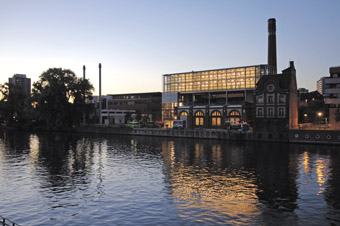
Radialsystem V, Berlin
photo Sebastian Bolesch
Radialsystem V, Berlin
THERE ARE SOME UNCANNY SIMILARITIES BETWEEN SYDNEY’S CARRIAGEWORKS COMPLEX AND BERLIN’S NEW RADIALSYSTEM V. BOTH BUILDINGS ARE FORMER INDUSTRIAL SITES CONVERTED RECENTLY TO CULTURAL USE. BOTH SEEK TO PROGRAM A RANGE OF ARTS AND COMMERCIAL PROJECTS TO MAINTAIN A SUSTAINABLE ECONOMY ACROSS THEIR LARGE PREMISES. BOTH ARE SEEKING TO BRING SOMETHING NEW TO A CROWDED CULTURAL SCENE AND BOTH ARE STRUGGLING TO MATCH THEIR POTENTIAL WITH PUBLIC FUNDING.
In a conversation with Solon Ulbrich, producer of Tanja Liedtke’s choreography, at a Goethe Institut seminar in Berlin in 2007, these coincidences and many more struck German freelance producer and project curator Lisa Stepf. Her work with Radialsystem V encouraged her to research a project to bring CarriageWorks and Brisbane’s Powerhouse into a nascent network for post-industrial sites being investigated by Radialsystem’s producers.
kampnagel
In Germany, Kampnagel in Hamburg is the high-profile forerunner to Berlin’s Radialsystem. Its new director, Amelie Deuflhard shares Stepf’s enthusiasm for the proposed network. Kampnagel was a former ironworks, armament factory and iconic industrial site for Hamburg from 1865 to 1981. It subsequently became the locus of an exhilarating range of radical artistic experiments under a series of visionary producers and artist-entrepreneurs, and now operates as a production house and festival and events venue for contemporary arts from Germany and the world.
104 paris
Radialsystem V is also in dialogue with 104 Paris, the huge new arts space which opened in late 2007 in central Paris. It’s a 26,000 square metre, glass ceilinged, arcade style interior which operated from 1874 to 1997 as a centre for the municipal funeral service. Curated by Robert Cantarella and Frédéric Fisbach, it is dedicated to all types of contemporary art. The complex includes 19 workshops, screening rooms, living quarters, theatre and studio spaces, event rooms, restaurants and boutiques. There are artists in residence and a busy calendar of performance and presentation projects.
zone attive, rome; matadero, madrid
In Rome, in 2008, Zone Attive will open a 10,000 square metre complex dedicated to innovation in the arts in the city’s former abattoir. In Madrid, the Matadero is also housed in a former abattoir that covers an area of 148,000 square metres. The warehouses in the complex are currently being renovated to house a training and education space, production and exhibition venues, with an emphasis on international exchange and experimental arts. Radialsystem V’s producers have also come across a forthcoming venue in Brooklyn, cast from the same mould.
network forum
In the context of the possible network project, Stepf proposed a project called New Spaces for the Arts—FestivalForum for 2009, with the hope of including some Australian work in the program. She knew that no funding was available for the research she needed to undertake: Radialsystem V is as yet only project funded, with no ongoing support for organisational development or running costs. Like many freelance producers, Stepf is used to juggling multiple roles and projects at various stages of funding. She was interested in returning to Australia where she’d spent some time as teenage exchange student. Stepf is confident that her project will ultimately attract funding because of the high quality of performances she saw in Australia and the credibility of Radialsystem V and its producers.
radialsystem v
Stepf’s faith in the venue seems justified. Radialsystem V was completed in September 2006, combining state of the art contemporary spaces within the shell of the city’s former sewage pumping station directly located on the banks of the river Spree at the confluence of three buzzy Berlin districts. Comprising one 578 square metre main hall seating 300 and an adaptable 394 square metre second venue as well as three large studios, offices and event spaces and two terraces overlooking the river, the venue, which is named with an ambition to connect outwards, is a new cultural hub for Berlin.
Purchased by a private investor cognisant of the city’s insistence that such historical monuments operate a public cultural program, Radialsystem V was always going to have to fight for subsidy in a city which professes itself bankrupt whilst maintaining an inspiring range of public cultural institutions. Radialsystem V’s new owner quickly appointed producers and they launched a program of ticketed art events and high income generating commercial activity to get the initiative off the ground and onto the cultural map of Berlin.
Not just any old producers, Jochen Sandig of Sasha Waltz & Guests and Folkert Uhde of the Akademie fur Alte Musik Berlin, are bright stars in Berlin’s cultural galaxy. They met whilst collaborating on Waltz’s Dido and Aeneas in 2005 and were keen to extend the collaboration between their high profile music and dance organisations. Rehearsing and presenting site specific work at Radialsystem V as well as starting to conceptualise in-house productions will reap obvious rewards for the organisations they continue to run. They are also clear that their home is open to a diversity of forms and thus Stepf’s project fits their bill perfectly as one of the first projects for which they will seek project funding and a profile for Radialsystem V as a producer.
the australian connection
In Australia for close to two months, Stepf visited the Sydney Festival’s Movers and Shakers dance program and was assisted by the Australia Council’s Community Partnerships and Market Development division and Dance Board as well as Sydney’s Goethe Institut. She visited the Australian Performing Arts Market in Adelaide and met with artists and presenters from Brisbane and Melbourne in between time. Aside from planning to involve the producers at CarriageWorks and Powerhouse in the 2009 forum, examining programming and producing policy and exchange, Stepf is looking for productions to present in a festival format. Radialsystem V seeks to present hybrid work, in line with the aesthetic of its producer partners, but also as a pragmatic choice for a city with an abundance of art-form specialist presenters.
Sated by the dance in Sydney, Stepf saw as many music, cabaret and visual art productions as she could attend at APAM, the Adelaide Festival and Fringe. Without confirmation of funding, she cannot yet commit to companies and is therefore understandably cagey about her presenting ideas. She hopes to be able to create further presentation opportunities outside the festival forum, with partners such as Kampnagel or Haus der Kulturen der Welt which is running its Asia Pacific Week during her September 2009 forum.
Halfway through her trip, I met Lisa Stepf in Melbourne, following her Sydney Festival experience and enjoyment of a night of free symphonic music at the Sidney Myer Concert Bowl. “Now that’s what I call audience development!” she exclaimed, impressed by the mass turnout and relaxed attitude of the Melbourne concert-goers. Her impressions of Sydney audiences were similar. Stepf was moved by their enthusiasm and open appreciation of the performances she saw in the dance program and at presentations by Meow Meow and Coda. “People appreciate the arts here in a different way,” she commented, “they are not hyper-critical, as they are in Germany.” Stepf went on to marvel at the unpretentious way in which many artists deliver their work, its virtuosity and attention to production details, and the self-deprecating Australian humour.
Should Stepf’s enthusiasm remain undaunted, her project could give rise to new opportunities for Australian and German contemporary arts exchanges as well as a network of hybrid arts presenting venues beyond. Stepf is convinced that the dialogue between the performing arts cultures in Australia and Germany has a profound and far-reaching trajectory to take.
www.104.fr
www.zoneattive.it
www.mataderomadrid.com
RealTime issue #84 April-May 2008 pg. 16
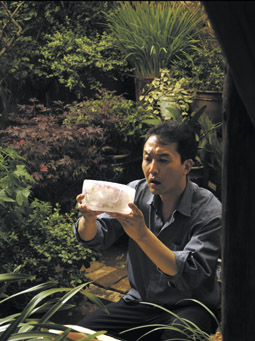
The Case
PRODUCER LOLA ZHANG CALLS HER YUNNAN NEW FILM PROJECT A “LONG MARCH.” IT’S HARD TO IMAGINE A SCHEME ON A SIMILAR SCALE IN AUSTRALIA. COMPRISING 10 FEATURES BY 10 YOUNG FEMALE DIRECTORS, SOME OF WHOM HAVE NOT DIRECTED BEFORE, THE PROJECT IS FRAUGHT WITH CREATIVE AND COMMERCIAL RISKS—NOT TO MENTION THE PRODUCER’S UNABASHED TALK OF BRINGING ART AND COMMERCE TOGETHER. DISCUSSING HER STRATEGY OF USING DIRECTORS DRAWN FROM A RANGE OF CREATIVE FIELDS, ZHANG EXPLAINS, “I WANT TO BRING FRESH PERSPECTIVES TO THE MOVIES…THIS IS GOOD FOR FILMMAKING, AND ALSO GOOD FOR ART.”
So what motivated Lola Zhang to undertake the mammoth task of producing 10 films by 10 inexperienced directors? It’s not the first time she has taken on such a scheme; a job at an investment company at the turn of the decade led to her formulating the New Film Project for Chinese Directors, an earlier series of 10 works designed to give emerging talent a leg-up into the industry.
Zhang was inspired to take the series concept further when a film shoot in Yunnan piqued her interest in the area. The southern province’s humidity and lush vegetation are a world away from Beijing’s desert clime. Bringing together female creative figures from around China (including Hong Kong and Taiwan), Zhang asked each to craft a work set and shot in the tropical locale. Her own background is in arts-related documentary making and conceptual photography, which may go some way to explaining her unconventional producing style.
A small amount of financial support was garnered from the Yunnan Provincial Government, but the films have predominantly been funded by private means. Superficially, China has all the elements required to sustain a strong commercial industry that should have room for such experiments, including internationally recognised stars and directors, a network of studios and, perhaps most importantly, an unimaginably vast domestic market. But mainland Chinese filmmakers operate in an environment of rampant piracy on one hand and strict government controls on the other. Censorship is frequent and arbitrary. Ang Lee’s Lust, Caution, for example, had over 30 minutes excised for its release. It’s a measure of Lola Zhang’s passion, as well as creative bravery, that she’s managed to pull the teams and the funding together for the Yunnan New Film Project in this difficult filmmaking environment.
Publicly at least, Zhang and her executive producer, ET, are unfazed by the milieu in which they work. The constraints, says ET, simply require them to be “more clever.” The first two Yunnan Project films, completed last October, indeed demonstrate it is possible to produce worthwhile experiments while passing the censor and garnering official recognition.
the case
The Case is a startling, David Lynch-like tale of repressed small town desires by documentary filmmaker Wang Fen. After Zhang whittled her initially broad list of potential directors down to 10, she took her team south to allow the creative juices to flow in Yunnan’s tropical heat. On the trip, Wang Fen stumbled upon a small village nestled at the foot of a mountain near the Vietnamese border. “During the day the town is a bustling tourist centre”, the director recalled at a recent screening in Beijing. “But at night it’s a deserted ghost town.” Intrigued by this duality and the languid tropical ambience, Wang knocked up a draft script in just two days.
Wang Fen's dark, absurdist tale focuses on Dasam, a harassed middle-aged man running a small guesthouse with his highly strung wife. Waking one morning to find a suitcase floating in the river outside his window, Dasam excitedly pulls the trunk from the water and stows it in his garden. After repeated interruptions from his ever suspicious wife, he forces the case open and is horrified to find an array of body parts neatly encased in blocks of ice. As the ice melts, Dasam’s repressed desires and obsessions begin to emerge from murky depths, materialising in the form of a sultry femme fatale (Wu Yujuan) who checks into the guesthouse.
The premise echoes David Lynch’s Blue Velvet (1986), transferred to a south China village, with the case’s contents taking the place of Blue Velvet’s severed ear. The film’s debt to the surrealist aesthetic is made explicit when Dasam sneaks into his bathroom one night to furtively examine a book of European Surrealist Art. The final 15 minutes sees the uncertain border between dreams and reality, truth and fiction, life and death become utterly blurred as the narrative folds in on itself in an endless, maddening spiral.
The Case is an uneven film of abrupt shifts that aren’t always successfully pulled off. But it’s also an arresting, darkly humorous work and a rare attempt at bringing a genuinely surrealist spirit into the realm of commercial feature filmmaking.
the park
The second Yunnan film is an altogether more sober affair by poet, novelist and essayist Yin Lichuan. At the outset, The Park feels like another predictable, if well acted, tale of parent-child alienation and generational conflict. But this initial familiarity is misleading. Step by step this understated film evolves into a surprising and deeply moving meditation on age, the complexities of human relations and the corrosive, unstoppable effect of time on us all.
June is a 29-year-old TV presenter living in Yunnan’s capital, Kunming. In the opening scene, a visit from her elderly widowed father finds her asleep in the arms of her boyfriend; he hightails it out the window and Dad moves in, doling out constant criticism and gently trying to take control of June’s life. Their relationship goes from bad to worse when June does a story on the matchmaking activities of elders in a local park and finds Dad hawking her details to prospective parents-in-law.
Despite the father’s wilful interference in June’s life, The Park manages to skilfully balance viewers’ sympathies across the generational divide. When June finds one of her suitors is a documentary maker who has interviewed her father about his motivations for being in the park, she demands to see the tape. Her subsequent viewing is beautifully handled in the film’s most subtly effecting scene.
The Park’s restrained but emotionally charged melancholic tone builds to a quiet tear-jerker of a finale that wordlessly conveys an aching sense of life’s transience. Superficially a genre melodrama, this small film contains riches that only yield themselves upon multiple viewings.
a low-budget filmmaking model
Like much Australian cinema, the Yunnan films sit in the difficult middle ground between art house product and full-blown studio-produced commercial cinema. In a story that would be familiar to most Australian producers, Lola Zhang has had a hard time generating interest amongst theatre chains with a series of films by unknown directors and devoid of big stars. Nevertheless, she has persevered and The Case and The Park are currently doing the rounds of cinemas across eastern mainland China. The third Yunnan title, Finding Shangri-la (directed by Taiwanese theatre actor and director Ismene Ting) is currently in post-production in Taiwan. The remaining seven films are in various stages of pre-production.
Low-budget Chinese features over the last few years have largely been disappointing, with the recent Pingguo (Lost in Beijing, director Li Yu) typical of the aimless portrayals of those doing it tough in the new China that tend to characterise these productions. The first two Yunnan New Film titles are something different—modest but memorable slices of low-budget genre cinema that demonstrate what is possible with a small cast and a handful of well used locations. Their success is a tribute not only to the directors’ creative skills, but also Lola Zhang’s creative vision in bringing diverse talents together. Here’s hoping the remaining seven films maintain the high standard.
The Case, director Wang Fen, writers Wang Fen and Zhang Cheng, producer Lola Zhang; The Park, writer/director Yin Lichuan, producer Lola Zhang. Both films produced under the auspices of the Yunnan New Film Project, Filmblog Media, People’s Republic of China, 2007
The writer would like to stress that the views on the Chinese film industry expressed here are solely his own and do not necessarily reflect the views of anyone involved in the Yunnan New Film Project. Thanks to Wang Yi for her help translating the interview with Lola Zhang.
RealTime issue #84 April-May 2008 pg. 17
© Dan Edwards; for permission to reproduce apply to realtime@realtimearts.net
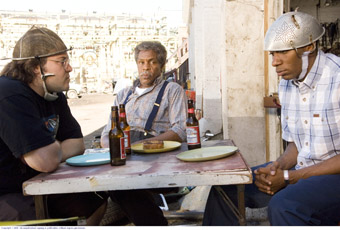
Jack Black, Danny Glover, Mos Def, Be Kind Rewind
BE KIND REWIND, THE LATEST FILM FROM MICHEL GONDRY (THE SCIENCE OF SLEEP, ETERNAL SUNSHINE OF THE SPOTLESS MIND), IS A WHIMSICAL COMMENTARY ON THE STATE OF CINEMA. THE FILM INVESTIGATES HOW CHANGES IN TECHNOLOGIES OF PRODUCTION AND DISTRIBUTION HAVE IMPACTED ON OUR EXPERIENCE OF CINEMA, INCLUDING CONSUMPTION OF THE HISTORY OF CINEMA ITSELF.
Be Kind Rewind offers us commentary on cinema’s current period of transition, where both analogue and digital technologies coexist in a variety of configurations. The implications of this curious hybrid scenario have concerned many makers and theorists at least since the official centenary celebrations for the cinema back in 1995.
Be Kind Rewind, the name of the local video store at the centre of the film, only stocks movies on VHS. It is to be demolished by the local council as part of a cityscape upgrade. The store is losing money. Nobody wants to rent old videos anymore. But its owner Mr Fletcher (Danny Glover) is eager to raise the funds for repairs to prevent being relocated to the periphery—“the projects.”
When Mr Fletcher goes on holiday, leaving his assistant Mike (Mos Def) in charge, Gondry makes comic and dramatic use of the fact that VHS tapes are easily erased. Mike’s accident prone friend Jerry (Jack Black) rocks up at the shop after being magnetised during a failed sabotage attack on the local power plant and inadvertently erases the entire video collection. This accident is the key turning point in the narrative.
The renovation that the VHS collection subsequently undergoes is not, as we might expect, a digital upgrade to DVD. The West Coast Video store in town already specialises in a limited range of DVD blockbusters. Instead, in an attempt to prevent Mr Fletcher from finding out what has happened, Mike and Jerry decide to remake each movie as it is requested with their old video camera and a host of cheap improvised costumes and special effects, recruiting Alma (Melonie Diaz) into their scheme.
Jerry declares that these remakes are “sweded” and the name sticks. Sweding is supposed to suggest that the remakes are very rare, as if imported from Sweden, thus justifying the significantly higher rental fees Mike, Jerry and Alma start charging for these boutique titles. Word spreads and the remakes become hugely popular, prompting Mike and Jerry to set up a cottage industry production studio in the vacant lot next to Jerry’s trailer in order to maximize production output and profits. Multiple low-grade special effects are set up and the actors manically jump between sets, pumping out key scenes at high speed.
When the demand gets too high even for this production model, they begin to invite local community members to take on roles in the films each of them has requested. The remakes start changing shape as more people become involved, transforming production into an impromptu community development project.
Be Kind Rewind embraces the hype in recent decades around the idea that just about anybody can now make a movie on cheap, easily obtainable equipment. At the same time, however, Gondry does not even bother to buy into what has already proved to be a largely failed promise that this leveling of the technological playing field would produce untrained superstars. Instead, he enthusiastically embraces and celebrates the pleasures of clunky DIY amateur cinema, placing the emphasis on participation.
The sweded films, with their back-to-basics special effects, put the mechanisms of film production on show rather than seamless digital technology. The point of all this for Gondry is to embrace the possibility that everyone might create their own entertainment with cheap equipment, rather than just being consumers of entertainment. Thus the film imagines a utopia where the commercial concerns of the mainstream industry are no longer at the centre of production and consumption.
The practice of sweding underscores the complicated role that the remake has played in our consumption of cinema history. Consumption does not have to be a passive affair but can fire a desire to dress up and re-imagine what we have seen. The sweded remakes perform acts of remembering—the ways in which we internalise and critique the movies and how they enter the vocabulary of everyday life.
Be Kind Rewind itself is not without its own inspired intertextuality. Jack Black played Carl Denham in Peter Jackson’s remake of King Kong. In the sweded version Black plays Jerry playing Kong in a fluffy brown costume, roaring as he climbs a cardboard tower, grasping a screaming Alma. Delightfully, Gondry has even made his own sweded version of the Be Kind Rewind trailer, where he plays all the characters.
The sweded remakes also comment on the history of African-American representation in the cinema. Driving Miss Daisy is sweded not once, but twice. When Miss Falewicz (Mia Farrow) asks Mike to swede it for her, he tries to talk her out of it, but she insists. The first attempt with Mike as chauffeur Hoke and Jerry as an excessively bossy Miss Daisy fails. Mike cannot stand Jerry’s condescending behaviour and Jerry, insulted by Mike’s criticism of his performance, walks off the set. Later when sweding has become more widespread, Miss Falewicz makes her own version, rambling on and on in the back seat as Mr Fletcher obligingly plays the chauffer.
It’s significant that Driving Miss Daisy is the target of so much jest. The pace, mood and setting of Be Kind Rewind evokes the feeling of a Spike Lee film. Lee’s Do the Right Thing was nominated for an Academy Award in 1990, the year that Driving Miss Daisy controversially won four. As John Harkness puts it in The Academy Awards Handbook, “In the year of Do the Right Thing, Hollywood chose to honour Driving Miss Daisy, an uplifting film about the good old days when blacks were faithful family retainers.”
All this creative consumption and reinterpretation of the cinema proves to be too much for Hollywood. Sigourney Weaver, in an impeccable cameo as a Hollywood legal representative seeking damages for copyright, waves a document that enables her to destroy every sweded remake the store has produced, reasserting the power of the big studios.
This prompts Mike, Jerry and Alma to apply their sweding skills to an original, devised project with their local community. It is never clear whether they save the Be Kind Rewind building from destruction. Instead, Gondry closes with an image of the community as audience watching themselves on a big white sheet, the light from the projector flickering on their bright faces and illuminating the shop’s front window.
Be Kind Rewind, director, writer Michel Gondry, cinematography Ellen Kuras, editing Jeff Buchanan, music Jean-Michel Bernard, producers Geoges Bermann, Julie Fong, Partizan Films, Australian distributor Village Roadshow
RealTime issue #84 April-May 2008 pg. 18
© Megan Carrigy; for permission to reproduce apply to realtime@realtimearts.net
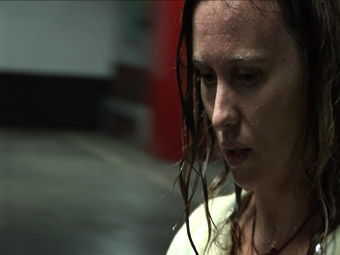
Beth Buchanan as Ophelia, The Tragedy of Hamlet, Prince of Denmark
IT WAS NOT AN AUDIENCE OF CINEPHILES; INDEED, IT WAS NOT YOUR USUAL FILM FESTIVAL AUDIENCE AT ALL. OSCAR REDDING’S THE TRAGEDY OF HAMLET, PRINCE OF DENMARK WAS ABOUT TO HAVE ITS WORLD PREMIERE AT THE 2007 MELBOURNE INTERNATIONAL FILM FESTIVAL, AND THE CITY’S THEATRE-MAKERS, THEATRE-GOERS, AND EVEN A FEW OF ITS THEATRE CRITICS, HAD FLOCKED TO THE RMIT CAPITOL THEATRE IN AIR-KISSING, TURTLENECKED DROVES.
While I had not been around at the time of A Poor Theatre’s well-received 2004 production of the play, which Redding had staged with little money in an abandoned shopfront in a Melbourne suburb, I had heard very positive things about it from people in the know. Nevertheless, I was feeling dubious about its cinematic reincarnation. The last thing I was in the mood for was two hours of theatre pretending to be cinema.
My concerns, however, were almost entirely unfounded. Borrowing heavily from the cinematic language of Dogme95, the film caught me off guard with its motion sickness-inducing cinematography, narcotic imagery, brutally distorted sound design, and—in a not always successful attempt to evoke the technical limitations of digital video—its deliberate use of frame dropout.
“I stole as much as I could from the Dogme films”, Redding confirms over coffee six months later, half way through the film’s 10-day season at Melbourne’s Malthouse Theatre. “Festen [director, writer Thomas Vinterberg, Denmark, 1998] is still one of my favourite films. It’s an extraordinary piece of work. When you watch a film like that work so successfully and so powerfully, you can’t help but think that you might be able to do something similar.” He adds, laughing, “I don’t know if I did that, but certainly having that mentality made it a hell of a lot easier to make the film.”
“And to what extent were you conscious of making a film”, I ask, “and not merely a piece of filmed theatre?” At a time when the vast majority of Australian filmmakers remain stubbornly reliant on theatrical and literary storytelling models, instead of on cinematic or even televisual ones, Redding’s film strikes me as a breath of fresh air. “Oh, I always approached it as a film”, he replies. “We’ve all seen the little video snippets of theatre shows before. They’re terrible.”
Upon closer inspection, however, The Tragedy of Hamlet retains a number of theatrical elements beyond the obvious one that is its text, and these in turn grate against its more cinematic components to compelling and disconcerting effect. Indeed, much of the film’s formal interest is derived not from the smooth translation of the original production from stage to screen, but rather from the tension that exists between the two forms at their points of coincidental intersection.
The most obvious and well-explored of these points is the image and its frame line, and the logic by which this frame line operates in both the theatre and the cinema. In their more inventive moments, Redding’s images exist somewhere between the two forms, the indexical, practical geography of his scenes giving way to an inherently theatrical spatial and causal logic rooted in the bent psychology of the mad-as-a-hatter prince. In this configuration, the frame lines function much like the wings on either side of the theatre’s proscenium arch, the very structure of which, like the frame of a painting, delimits a space or field, whereas montage, and particularly the continuity editing of classical cinema, creates an open, contiguous space that logically continues beyond the edge of the frame.
Held in close-up for much of the film, Richard Pyros’ Hamlet is forever being surprised by the incursion of others into his frame, even when logically he would have seen or heard them coming a hundred metres away. In the film’s most impressively choreographed sequence, shot in Melbourne’s Degraves Street underpass, the physics of the various characters’ entrances are very often implausible, but the manner in which they suddenly appear is always dramaturgically and tonally appropriate. Hamlet’s self-absorption and claustrophobia become the terms by which the image operates, and his existential anxiety becomes as much about the non-being on the other side of the frame as it is about dying and sleeping no more.
Hamlet’s psychological state is further echoed in the film’s more self-reflexively cinematic elements. Far from offering a disembodied or omniscient point-of-view, the camera is constantly being highlighted as a subjective, embodied participant in the proceedings: the film opens with the cameraman shooting his own feet, and he can later be seen reflected in the mirror of Gertrude’s bathroom, putting the camera down on a stool and leaving.
“I love the premise of it”, says Redding, “and I think it works exceptionally well for Shakespeare….having a handheld, documentary camera there suits the style of Shakespeare, the immediacy of his writing. It also gives the characters someone to talk to.”
Indeed, with the exception of a late scene in The Melbourne Waiters’ Club, in which Hamlet is not present, the wildly physical handheld camera is the prince’s constant companion. In my own, slightly eccentric, reading, the camera can in fact be taken as an external manifestation of the character’s soul. As Hamlet’s madness becomes increasingly more pronounced as the narrative progresses, so too does the camera begin to malfunction: the tape begins to jam, the sound and image drop out, and the whole thing becomes increasingly difficult to watch. Like a 1970s flicker film, the form begins to wound the audience, performing an optical and aural violence upon them—Hamlet’s own internal violence rendered cinematically. “Till then sit still, my soul”, he whispers at one point, though the camera, like the bug-eyed prince himself, cannot help shaking.
“There are a lot of people who find it difficult to watch and there are a lot of people who find it unbelievably engaging, and I think it depends on who you are”, Redding says. “I don’t think it’s an easy film to watch in the sense that it certainly doesn’t meet you half way.”
Instead, The Tragedy of Hamlet, Prince of Denmark meets itself half way. Existing somewhere between cinema and theatre, it employs the formal and logical resources of each to reflect on and illuminate the other, whilst simultaneously making manifest the internal tensions of one of the most famous fictional characters in history, which in turn become the film’s own. The result is one of the more interesting experiments in recent Australian cinema: an intelligent, violent, unrelenting exploration not only of this particular story, but indeed of the ways in which we might tell it, “with th’ occurrents,” to quote the Bard, “more and less, which have solicited.”
The Tragedy of Hamlet, Prince of Denmark, writer William Shakespeare, screenplay, direction Oscar Redding, performers Richard Pyros, Steve Mouzakis, Brian Lipson, John Francis Howard, Heather Bolton, director of photography Ari Wenger, producers Aleks Radovic, Oscar Redding, Richard Pyros, 120 mins, 2007; Tower Theatre, CUB Malthouse, Feb 26-March 8
RealTime issue #84 April-May 2008 pg. 19
© Matthew Clayfield; for permission to reproduce apply to realtime@realtimearts.net

Historical print referenced by Srinivas Krishna
THE ENGLISH POET PETER REDGROVE’S THE BLACK GODDESS AND THE SIXTH SENSE (BLOOMSBURY, LONDON, 1987) OFFERS REMARKABLE PERSONAL AND LITERARY ACCOUNTS OF ‘WEATHER DEPRESSION’, A CONDITION NOW UNDERSTOOD TO BE WIDESPREAD AND TREATABLE BY, AMONG OTHER MEANS, ADDITIONAL DOSES OF LIGHT. MELBOURNE’S FEDERATION SQUARE, GEARING UP FOR ITS THIRD LIGHT IN WINTER EVENT, OFFERS THE PUBLIC RESPITE FROM THE NARROWING LIGHT OF THE IMMINENT WINTER SOLSTICE.
Light in Winter’s director, Robyn Archer, tells me that the event is “not just pretty lights or making the square a decorative domain.” Lighting designer Nathan Thompson (of The Flaming Beacon design group) will, she says, “warm” Federation Square, nine Melbourne communities will present works in light and Canadian filmmaker Srinivas Krishna will premiere his multiple LED-screen, free-standing installation, When Gods Came Down to Earth. Like other innovative filmmakers—Peter Greenaway, Atom Egoyan—Krishna has turned to making installations as an alternative way to explore and expand his vision.
srinivas krishna’s gods
Krishna’s When Gods Came Down to Earth will screen 24 hours daily for four weeks from June 12, a slowly morphing stream of images from the Hindu pantheon as filmed recently, says Archer, on the streets of Mumbai, drawing on posters, statuary, ritual face painting and shrines. Krishna’s creation is anticipated to be richly coloured, sensual and contemplative, a welcome polytheistic counter to monotheism’s cooler often wintry artistry.
Archer says that Krishna has long wanted to make The Gods… She explains that the filmmaker has been particularly interested in how the vivid public displays of the gods emerged late in India’s history, particularly during British rule and with the advent of three-colour processing, and even moreso in the 60s with the arrival of the Beatles in India. Most people could not access temples, so posters suddenly allowed them to have the gods in their homes and on the streets—and now they can download them too.
The images in Krishna’s installation, says Archer, will be very stylised, slow moving, focusing on detail and creating a number of narrative strands built from public images of the gods. Clearly, When Gods Came Down to Earth will be an immersive, contemplative experience, generating inner warmth on cold days and nights and, possibly, reflections on the nature of belief and worship.
srinivas krishna: filmmaker
Srinivas Krishna was born In Madras, India, grew up In Toronto, studied history and painting at the University of Toronto and then cinematography at Philadelphia’s Temple University. He is best known for his 1991 feature, Masala (referring to the spice mix and the film’s mixed means). Directed, written, produced by and starring the then 26-year-old artist, it’s a wild displacement of the Hindu gods from ethereal realms into the everyday of Canadian domesticity, television production, sport (the god Krishna as an ice hockey star), Bollywood and the VCR as a means of communicating with deities. In 2002, the British Film Institute voted Masala the Best South Asian Film of the 20th century.
Krishna’s other feature films include Lulu (1996), about a mail-order bride from Vietnam, which premiered in the Official Selection of the Cannes Film Festival. After Lulu, his work has included directing dance films and creating and producing television dramas and mini-series, writing stage plays and creating installations. He is currently writing a sci-fi thriller based on the Nebula-award-winning novel, The Terminal Experiment, by Canadian author Robert J Sawyer and is directing his first documentary, Ganesh, Boy Wonder.
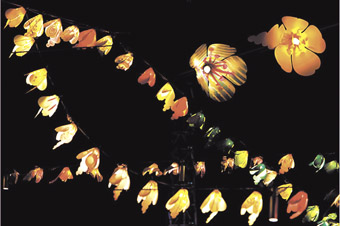
The Japanese community’s contribution to The Gift of Light, Light in Winter, 2007
photo David Simmonds
The Japanese community’s contribution to The Gift of Light, Light in Winter, 2007
the gift of light
On June 21, in The Gift of Light, nine of Melbourne’s communities—Aboriginal, Japanese, African, Indian, Burmese, Chilean, Turkish, Vietnamese and Afghani—will install light-based works in Federation Square. Each has worked on their project with a funded artist. The installations will, for the first time, all be “switched on at once” and be collectively in place until July 5, adding new dimensions to Nathan Thompson’s re-lighting of the square. Archer says that six communities were involved in the 2007 event (their creations documented on video) and the aim is to gradually enlarge the number of communities participating, to expand the sense of what light means in different cultures and to share that.
Light in Winter also furthers the sense of Federation Square as a truly public space, not just one for hire. Archer sees it as “a great playground” with the square’s chief executive officer, Kate Brennan, strengthening its association with the arts and filling gaps in the city’s cultural life.
For the darkest month of the year, Melbourne’s citizens will be able to repair to Federation Square for enlightenment and soulful succour.
Light in Winter, artistic director Robyn Archer, producer Federation Square, Melbourne, June 5-July 5; www.fedsquare.com
RealTime issue #84 April-May 2008 pg. 20
© Keith Gallasch; for permission to reproduce apply to realtime@realtimearts.net
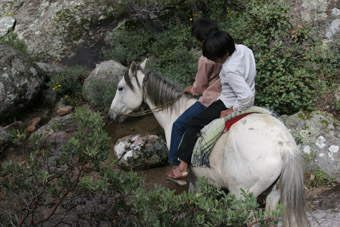
Cochochi
CLARE STEWART IS HAPPY IF A LITTLE FLUSTERED WHEN WE SPEAK IN LATE MARCH. SHE’S CLOSE TO SETTLING THE PROGRAM FOR HER 2008 SYDNEY FILM FESTIVAL, BUT NOT CLOSE ENOUGH TO REVEAL ALL, NOT UNTIL MAY 8. DESPITE WHAT SHE DESCRIBES AS “A SOFT YEAR FOR FILM”, GIVEN DISAPPOINTING SHOWINGS AT THE BERLIN, ROTTERDAM AND SUNDANCE FESTIVALS, SHE ARRIVED HOME FROM HER 2007-08 PROGRAMMING TRAVELS KNOWING THAT SHE NONETHELESS HAD “A WEALTH OF GOOD FILMS TO CHOOSE FROM A HUGE VOLUME OF NEW MATERIAL.”
Stewart’s search for good films took her to New York and festivals in Toronto, Rio de Janeiro (where she was on the film festival jury), Pusan in Korea, Rotterdam and Berlin. She mentions in passing that the Brazilians were keen to hear what Australians thought of the films she’d programmed from their country for the 2007 Sydney Film Festival. Those films indicated, she said, a strong, diverse Brazilian film culture if not a film movement as such; elsewhere a new wave of Mexican auteurs were making their mark in international festivals. I ask about Australian films in Stewart’s 2008 festival. She can’t name names, but says the 2007 trend for “powerful low-budget, digitally made Australian features, experimenting with story-telling, continues.”
competition
Stewart mentions that the renowned Pusan Film Festival is reaching a point in its rapid growth where it will need to reconsider its scale. I comment that Australian film festivals too are going through some significant changes themselves and wonder how competitive the festival scene, or perhaps I should have said festival industry, is becoming. The Sydney and Adelaide festivals now offer large money prizes, both for 12 international films in competition; Adelaide and Melbourne offer production funding for new films, Melbourne a co-financing marketplace and Sydney something similar, if of a different order. There’s a growing number of associated events and alliances, often with a marketing dimension. Australia’s international film festivals are, without doubt, mutating, extending their reach beyond satisfying film buffs and showcasing. But let’s hope that they don’t, like their arts festival counterparts, all start to look and function in the same way.
Clare Stewart’s cheery retort is collegiate: “Not competitive, richer!” She thinks these developments across the festivals are good for Australian film and screen culture. Given that the major film festivals in Australia’s capital cities (Adelaide’s February-March biennial aside) run almost consecutively from June to August, there’s little in the way of direct competition (except for the lean hope perhaps of pulling audiences across borders). But festival publicists are letting loose with the rhetoric. The Adelaide Film Festival has re-visioned the film festival model over a very short period and quickly gained international notice. When it won The Inside Film Magazine IF Award for Festival of the Year, 2007, and was included in Variety’s Top 50 International Film Festivals, the AFF website declared “another ringing endorsement of one of the youngest but most dynamic and innovative festivals in the world.”
Adelaide’s announcement of its Natuzzi International Award For Best Feature Film, with a cash prize of $AUD25,000 was soon followed by Sydney’s $60,000 (from the SFF’s principal sponsor, Hunter Hall Investment Management) and with its declaration, “The Sydney Film Festival is Australia’s only film festival to have a FIAPF-accredited Official Competition” (FIAPF, the International Federation of Film Producers Associations, is the regulator of international film festivals).
In a variation on Adelaide’s Festival Investment Fund (AFFIF, initiated in 2003) Melbourne’s Premiere Fund?will support “a number of quality feature-length projects that will have their International premiere at MIFF”, with the fund as “a strategic minority co-financier.” Melbourne’s 37 South: Bridging The Gap, operated by its industry programs unit, is “Australia’s only film co-financing market in a film festival environment [enabling] Australian producers with market-ready feature-length projects to meet with key international film co-financiers in Melbourne.”
prizes
On the prizes front, Sydney will be looking for “new directions in film”, all contenders will screen as Australian premieres and will all ‘”have emotional power and resonance; be audacious, cutting edge and courageous; and go beyond the usual treatment of their subject matter.” Adelaide says, “Our jury is looking for a distinctive voice, bold storytelling, and creative risk-taking—above all, a film that genuinely engages and transports the viewer.”
Stewart says the the Sydney Film Festival prizes are all about visibility: “they leverage the standing of Australian film locally and internationally with a high-profile jury; the competition films will enrich the program; and each film will be accompanied by two significant international guests.” The guests won’t simply provide glamour (each film in competition will have its own red carpet Australian premiere), but will also provide career talks and meet local makers in groups and one-to-one sessions, not only exchanging information and ideas but also opening up the possibility of collaboration and co-production. No wonder Stewart refers in passing to these directors and producers as “enhanced guests.” The series of meetings and other industry events will be managed by the festival’s new Industry Liaison Officer, Kristy Matheson, working with a wide range of government agencies from Events NSW to the Department of Tourism and FTO (NSW Film & Television Office), which will offer the festival’s guests familiarisation tours about working in Australia. “It’s an integrated approach”, says Stewart.
I imagine then that choosing the 12 films for competition could be quite a challenge. Film quality is paramount but getting the right kinds of artists and producers who will provide red carpet glamour and benefit Australian film culture with their experience and wisdom suggests several other layers of criteria. But for Stewart, a sense of democracy overrides all other concerns, as she has witnessed in the Berlin and Venice festivals “where the films of well-known and unknown makers sit side by side in competition, sharing the same visibility.”
program: first glimpse
As in Stewart’s 2007 festival, diversity is the key, maximising choice and simultaneously building niche audiences. The Kids’ Festival continues after an “enormous response” for its initial season; Screen & Music at the Metro music venue again takes aim at the target youth-market (with Stewart hinting at some remodelling, making more palpable connections between festival screenings and Metro events). One film that should make that connection is Anvil, a 2008 Sundance hit. Stewart describes the film as “a documentary in the mockumentary style—but it’s the real thing.” It’s about a Canadian band, Anvil, whose early 1980s very heavy metal prefigured the likes of Metallica, but they never made it and “went straight into obscurtity.” Nonethless the band still performs and the film follows a recent, mismanaged European tour, in which the band members invested and blew all their savings.
mexican wave 2
Stewart is impressed with recent Mexican filmmaking and has secured three of the most acclaimed feature films currently enjoying attention on the international film circuit. She describes the films as “vibrant, diverse and part of a movement, the next generation on from González Iñárritu [Amores Perros, 21 Grams, Babel], Alfonso Cuarón [Great Expectations, Y tu mamá también, Children of Men] and Guillermo del Toro [Cronos, Hellboy, Pan’s Labyrinth].”
Rodrigo Plá was born and educated in Uruguay and studied film in Mexico City. His first feature is La Zona, to a screenplay by Laura Santullo from her own short story. Three young men from a slum break into a wealthy gated estate; there’s violence, a death and an appalling vigilante response from a community that is a law unto itself (and allowed that right by the state). This is a community that has, in turn, imprisoned itself—oblique echoes of Bunuel’s The Exterminating Angel (made in Mexico in 1962). Plá’s protagonists are two young men from either side of the class divide, ironically united by violence. Described variously as a bleak thriller and hyperreal, La Zona, says Stewart, is an incredibly assured film.
Cochochi (2007), the first feature directed by Israel Cárdenas and Laura Amelia Guzmán (he studied communications in Mexico, she attended film school in Cuba), and made with non-professional actors, is set in the Sierra Tarahumara of northwest Mexico. Stewart says the appeal of the film resides more in its ethnographic fidelity to the lives of the indigenous Raramuri than in its simple but affecting plot. Two boys, one committed to his culture, the other eager for the world beyond, lose a borrowed horse while delivering medicine to a remote community, and are then themselves separated.
Stewart describes Blue Eyelids, directed by Ernesto Contreras from a screenplay by Carlos Contreras, as “a bittersweet romance, melancholy and expectant, elegant and surprising.” A withdrawn woman working in a company that makes uniforms wins a holiday trip for two to a beach resort. She’d like to take someone with her. The search yields a man of like character and inevitable problems. For some reviewers, Blue Eyelids recalls Eric Rhomer’s brilliant The Green Ray (1986). Stewart promises as well a set of Mexican shorts and documentaries to accompany this promising threesome.
retro kerr
The 2008 retrospective is a curious one; rather than being dedicated to a filmmaker, it’s based around a film star who sometimes worked with great directors—Deborah Kerr, who died in October 2007. She was in the pantheon of my childhood film gods and goddesses of the 50s and into the 60s in films as remarkably different as Michael Powell and Emeric Pressburger’s The Life and Death of Colonel Blimp (1943), Black Narcissus (Powell and Pressburger, 1947), Quo Vadis (Mervyn LeRoy, 1951), From Here to Eternity (Fred Zinneman, 1953), The King and I (Walter Lang, 1956), Heaven Knows, Mr. Allison (John Huston, 1957), Separate Tables (Delbert Mann, 1958), Bonjour Tristesse (Otto Preminger, 1958), The Sundowners (Fred Zinneman, 1960) and The Night of the Iguana (1964). Although she sensitively played more than her fair share of shy, retiring, virginal types (a nun twice, the chaste heroine of Quo Vadis, the spinsters in Separate Tables and The Night of the Iguana), it was a capacity to suggest both intelligence and desire stirring beneath a wary facade that captured her a loyal audience, as well as a very English and un-Hollywood beauty, not least when her characters’ passions erupted.
From Kerr’s almost 50 films, although many are not available now, Stewart will be choosing eight, most likely including the two Powell and Pressburger films and From Here to Eternity, all welcome for a rare appearance on the big screen.
festivals: where to?
I grew up with and thrived on the intimate film festivals of the 60s and 70s, small programs with a richly diverse arthouse homogeneity and rigour, and a strong sense of community—there was a good chance most of the audience would see most of the films. As festivals have grown larger, that sharing has diminished (and how many films can you now budget to see?)—programming strands multiply in respect of age and special interest groups, forms and media and, increasingly, the demands of the market place—Australia’s film festivals nurture new films and become another nexus with the greater film world. With its prize money and industry strategies, Sydney Film Festival joins the mutating fold, adapting and innovating. Whether its red carpets will generate the audience numbers it so desperately needs is another matter, but the desire to pick winners in order to benefit local talent suggests its heart is in the right place.
Sydney Film Festival, June 4-28, www.sydneyfilmfestival.org/
RealTime issue #84 April-May 2008 pg. 21
© Keith Gallasch; for permission to reproduce apply to realtime@realtimearts.net

The Black Balloon
photo Mark Rogers
The Black Balloon
THE BLACK BALLOON IS A COMING OF AGE STORY ABOUT FAMILY SET IN THE AUSSIE BURBS. IT’S ALL RED BRICK BUNGALOWS, CYCLING ON THE FOOTPATHS, HILLS HOISTS AND PATIOS. EVERYONE IS WHITE, MIDDLE CLASS AND APPARENTLY CONTENTEDLY ORDINARY. THIS IMPRESSION IS REINFORCED BY CASTING RHYS WAKEFIELD, BEST KNOWN FOR HIS WORK ON THE SOAP HOME & AWAY, IN THE CENTRAL ROLE. BUT THE BLACK BALLOON SUCCESSFULLY EXCEEDS A SIMPLE REHEARSAL OF TIRED AND CONVENTIONAL STEREOTYPES ABOUT YOUNG AUSTRALIANS GROWING UP IN THE SUBURBS. THIS IS NOT JUST BECAUSE THE BLACK BALLOON TAKES ON THE RARELY EXPLORED SUBJECT OF AUTISM AND ITS IMPACT ON FAMILY LIFE.
This first feature film from Australian director Elissa Down made headlines earlier this year when it was awarded the Crystal Bear for Best Feature in the Generation 14 programme of the 58th Berlin International Film Festival. Produced by Tristram Miall, also behind successful Australian titles such as Strictly Ballroom and Looking for Alibrandi, The Black Balloon has already made almost a million dollars at the Australian box office.
The Black Balloon invites us into the wild world of fifteen-year-old Thomas Mollison (Rhys Wakefield) and his family—Mum (Toni Collette), Dad (Erik Thomson) and Thomas’ autistic brother Charlie (Luke Ford), plus a baby well on the way. When we enter the story, the Mollison family is moving into yet another new house, relocated again because of Dad’s army job. A bit of a loner, Thomas meets Jackie (Gemma Ward) who surprises him by taking the impulsive antics of his brother in her stride. Thomas’ family is an essentially strong and happy unit but always under pressure because of the constant unpredictability of looking after Charlie. As they settle into their new home, Thomas begins to come to terms with his feelings towards his brother, mixing frustration and acceptance.
Central to The Black Balloon’s success is its tightly honed script, crafted by Down and Jimmy Jack (aka Jimmy the Exploder). Everything in this film is told with a powerful and carefully judged economy. The film resists constant and explicit explanation, instead allowing the story to grow through intimate attention to small everyday exchanges and interactions. It appears to be structured as a series of vignettes. The narrative is entirely linear and yet, as we jump from one scene to the next, it is as if we are not moving anywhere, just settling in and immersing ourselves in the daily moments of this family.
The performances cultivated from this script are rich and intimate. Ford is absolutely impressive as Charlie, a character who has almost no lines at all and, in distinct contrast with Wakefield’s Thomas, a very limited range of available facial expressions to communicate his character. Collette (who also executive produced this film) extracts a beautifully strong, joyful quality from her character, a homely suburban Super Mum resolutely committed to the wellbeing of her children.
Rhys Wakefield’s carefully nuanced performance is captured beautifully. The subtlety of his responses and actions is allowed to speak for itself, without extraneous dialogue. We regularly engage with his character through gentle close-ups. The camera takes the time to watch him slowly and awkwardly stumble to Jackie’s house after a major bust up with his brother. We lie in bed with him in the mornings soaking up the familiar, repetitive sound of Charlie beating the concrete with a wooden spoon.
The exquisite opening title sequence captures all the understated qualities of the film, setting the audience up to be attentive to the intimate details to come. As each credit appears and disappears over images of the family moving into their new home, the names of all of the objects in the image are simultaneously spread across the screen, labelling everything we can see. They disappear with each credit, only to appear again and name everything in each room of the house.
This strategy, which makes reference to the later revelation of Thomas’s disappointment at Charlie’s losing the ability to speak, created a curiously beautiful intimacy. Sitting back to take pleasure in the overall effect of this superimposition, I was at the same time moved to constantly and carefully scan each image in an attempt to consider each word in relationship to the thing it named.
This attention to detail gives the vignettes continuity, allowing the film to move, even in its last moments, from a delicate double dancing monkey act to the final scene in a bathtub. Ultimately, it’s what makes The Black Balloon get under the skin.
The Black Balloon, director Elissa Down, writers Elissa Down, Jimmy Jack, cinematography Denson Baker, editing Veronica Jenet, music Michael Yezerski, producers Tristram Miall, Sally Chesher, Toni Collette, Jimmy Jack
RealTime issue #84 April-May 2008 pg.
© Megan Carrigy; for permission to reproduce apply to realtime@realtimearts.net
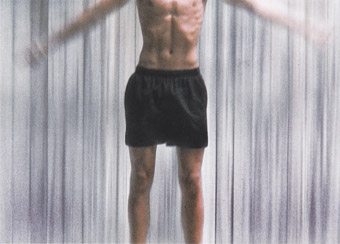
Alt I Alt
THE 5TH BIENNIAL REELDANCE FESTIVAL CELEBRATES THE MEETING OF DANCE AND FILM WITH A SELECTION OF CUTTING EDGE WORKS FROM AROUND THE WORLD AND A SPECIAL FOCUS ON DANCE AND MOVEMENT IN EVERYDAY LIFE WITH STYLES RANGING FROM BALLROOM AND FLAMENCO TO HIP HOP AND PARKOUR.
In their participatory take on the everyday, international guests, the UK artists Katrina McPherson and Simon Fildes, have transformed a photo-booth into the Move-Me.COM Booth, where you can make your own short dancefilms which are then uploaded to Move-Me’s website (RT83, p24). Booth visitors choose choreography to perform from a selection of artists, including Deborah Hay, Stephen Petronio and Nigel Charnock and then track their film on the associated website (www.move-me.com). The booth will travel to three Australian cities and two in New Zealand.
From the everyday of another era comes swing: at several of ReelDance’s tour stops watch out for a swing club with live band, projected archival swing dance footage and dancing demonstrations. And in Melbourne a Parkour performance, Get A Grip: L’art du Deplacement, will be staged and a documentary on the form shown at ACMI.
This year’s festival has 11 Australian and New Zealand touring partners and eight screening sessions including a feature film stream and major new documentaries on Les Ballets C de la B and Pina Bausch, dance film for children in Kidreels, a music video program (in collaboration with Oberhausen Film Festival’s MuVi) and the ReelDance Awards for new Australian and New Zealand shorts and documentaries which will be presented in Sydney on May 18. The judging panel for 2008 are film directors Christina Andreef, Ana Kokkinos and Samantha Lang, and choreographers Anton and Meryl Tankard.
To its ever expanding touring network (from Sydney, Melbourne, Brisbane, Adelaide and Perth to Cairns, Lismore, Noosa and Christchurch), its awards, its screening of the latest dance films from around the world (along with significant rarities), ReelDance is now adding masterclasses to its program. ReelDance does more than play a definitive role in promoting Australian dance film: it is an increasingly significant part of Australian screen culture, creating new opportunities for filmmakers and nurturing new film idioms for audiences to relish. RT
ReelDance International Dance on Screen Festival, touring May 1-Oct 12, www.reeldance.org.au
RealTime issue #84 April-May 2008 pg. 22
© RealTime ; for permission to reproduce apply to realtime@realtimearts.net
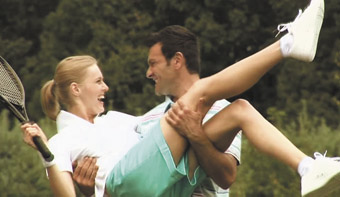
Justine Cooper, Havidol series (2007)
courtesy of the artists
Justine Cooper, Havidol series (2007)
A SHOW THAT WANTS US TO THINK ABOUT CONSUMPTION HAS ITS WORK CUT OUT FOR IT. IT’S TO THE CREDIT OF BRISBANE’S GALLERY OF MODERN ART’S SUMMER MOVING IMAGE SHOW, THE LEISURE CLASS, THAT IT MAKES US WANT TO.
While downstairs, to the regular ‘ka-ching’ of the gift shop cash registers, the Andy Warhol machine churned away profitably, upstairs, the media gallery housing The Leisure Class was the stage for a more reflective nexus of art, consumption and contemporary culture. Inspired by foundational anti-consumerist Thorstein Veblen’s 1899 influential monograph, Theory of the Leisure Class, the show comprises a tight selection of video art, performance documentation, animation and a short cinematheque program.
In Aernout Mik’s Pulverous (2003), a team of dead-eyed artworkers engage in a slow-motion ballet of product wreckage. These scenes of supermarket destruction are a perfect, unabashedly literal playing out of Veblen’s concept of ‘conspicuous waste’ which typifies the leisure classes. The psychogeography of the supermarket is targeted by a number of other artists in The Leisure Class. It’s hard not to smile at the deadly serious expression on Christian Jankowski’s face in his video Die Jagd (The Hunt; 1992/1998) as we watch the artist conduct his self-appointed quest to eat only food that he shoots on the supermarket shelves with a bow and arrow.
A more sustained grocery attack is found in French artist Mathieu Laurette’s project Apparitions: Money-Back Products (1997), an installation displaying the outcomes of that artist’s successful scamming of products, vouchers and reimbursements intended for unsatisfied consumers of branded goods. Laurette himself presents as a playful trickster character; we see him on French daytime TV, cheerfully relating to an eager media the strategies of deception which enabled him to live entirely on dubious gains. What is most interesting about this performance documentation is the reaction of the national media: French television, perhaps sensing a kinship with the artist’s methods (if not his ideals), seems more interested in his processes than troubling themselves with any difficult questions about the morality of his (essentially dishonest) project. Laurette’s work must of course be seen in conversation with that of the acknowledged patron of French anti-consumerism, Guy Debord, whose seminal film work, Society of the Spectacle (1973) features prominently in the show and, as the 40th anniversary of May ’68 approaches, seems more relevant than ever.
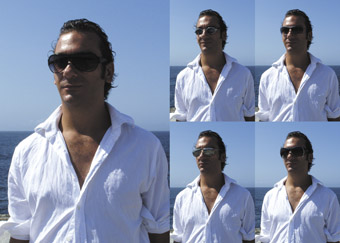
Lilly Hibberd, Endless Summer (2007)
courtesy of the artists
Lilly Hibberd, Endless Summer (2007)
In contrast to the dense, hectoring but nonetheless potent address of Debord’s classic film essay, some of the Australian artists in the show address commodity fetishism through the lens of video art. Both Justine Cooper and Lily Hibberd take aim at the aspirational consumer, and there is a visual similarity between the smiling, shiny people in Cooper’s Havidol series (2007) and the bronzed fashionista in Hibberd’s Endless Summer (2007). Hibberd’s consumer is a leisure class archetype of the sort so deplored by Veblen: the man featured in this video slideshow proudly displays his 37 pairs of obscenely expensive designer sunglasses, while his voiceover narrates an unreconstructed lust for the glamour they supposedly impart. Watching these slides, it’s hard not to recall Veblen’s words about how “[i]t is especially the rule of the conspicuous waste of goods that finds expression in dress” since items, such as sunnies, “afford…an indication of our pecuniary standing to all observers at the first glance.” The subject’s pompous narcissism notwithstanding, we might also be inclined to extend some pity towards one so afflicted with affluenza if we also recall Debord’s damning observation that “the object that was prestigious in the spectacle becomes mundane as soon as it is taken home by its consumer and by all its other consumers.”
The aspirational desire to ‘have it all’ is inventively seized on by Justine Cooper in her faux advertisements for a faux lifestyle drug, the “mood elevator” Havidol. The titles convincingly capture pharmaceutical marketing-speak, sending an ominous, Orwellian shiver down the spine: I Worry Less; I Used to Wake up Feeling Great; Just What I Needed; and Everyone Should be Able to Live Life to its Fullest. The ads feature shiny, smiling consumers blissfully extolling the virtues of the new drug as they subtly persuade the viewer of her or his (remediable) inadequacy. Each of these mock advertisements is absolutely pitch perfect, capturing at once the insidious power of Big Pharma and the false consciousness which has created a market niche for precisely such a contemporary soma. Cooper’s bold critique of “the commodity as spectacle”, brilliantly deploys the rhetorics of contemporary advertising aesthetics in a textbook “communication that includes a critique of itself.”
A détournement of a different kind is found in Australian Emile Zile’s video depicting the youthful artist’s 1997 appearance on the gameshow The Price is Right. In Larry Emdur’s Suit (2002), we see the artist cheekily mimicking the host’s plastic smile and enthusiastic gestures with boisterous, laugh-out-loud exaggeration. This intervention is belly-of-the-beast stuff, and though the footage has been circulating solidly since it was released, for me at least, it never ages. A similar activist drive is evident in Swedish artist Nathalie Djurberg’s New Movements in Fashion (2006) which depicts an array of puppets changing in and out of the stereotypical garb signifying socially acceptable roles for women: nice girl, businesswoman, porn star. There is something utterly compelling, repugnant, yet bizarrely attractive about these rough-hewn puppets tearing handmade costumes from each other’s bodies. As they fight, file, fuck, study and simper, the puppets become increasingly grotesque and, ultimately, an embodiment of the uncanny. Seen in the history of feminist animation, Djurberg’s badly-behaved ‘girls’ remind us of Freud’s insistence that “what is most frightening… what arouses dread and horror…is obviously the opposite of ‘homely’.”
The visitor’s entry to The Leisure Class is framed by Penelope Umbrico’s photo-collage, Suns from Flickr (2006-7). On its own, this visually arresting assemblage tells us that people—lots and lots of people—like to take nice photos of sunsets. However, seen in the context of the show as a whole, new meanings emerge as we reflect on the implications of online social networking in the bigger picture of leisure, consumption and waste. The conspicuous waste here, the show seems to be saying, is not of material goods, but rather of time: today’s leisure class can afford the hours of internet time spent on the meticulous, public artificing of the self to which sites such as Flickr are devoted. An impeccable online presence is, as Veblen would have it, dependent on “practices of conspicuous leisure with no practical value.”
One response to this de-materialisation of conspicuous consumption may be in the segment from Antonioni’s Zabriskie Point (1970) which the viewer subsequently encounters on entering the media gallery. Suggesting a radically material remedy to Debord’s diagnoses of the spectacle as “capital accumulated to the point that it becomes images”, the film’s famous climactic sequence, featuring the glorious (imagined) explosion of the building in which scheming capitalists have been plotting a major land grab, showers the space with warm light and the aching drones of Pink Floyd.
The Leisure Class, curators Kathryn Weir, Rachel O’Reilly, Queensland Gallery of Modern Art and Australian Cinematheque, Oct 13, 2007-March 30, 2008
RealTime issue #84 April-May 2008 pg. 23
© Danni Zuvela; for permission to reproduce apply to realtime@realtimearts.net
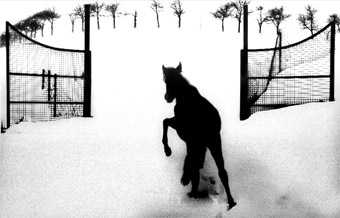
Abbas Kiarostami
ABBAS KIAROSTAMI IS MOST FAMOUS AS A FILM DIRECTOR, BUT HIS ARTISTIC OEUVRE EXTENDS FAR BEYOND THE SCREEN. HE HAS WORKED EXTENSIVELY IN BOTH VIDEO AND PHOTOGRAPHY, BUT MOST IMPORTANTLY HE IS A POET—LITERALLY IN THE SENSE OF HAVING PUBLISHED POETRY, FIGURATIVELY IN THAT A POETIC SENSIBILITY INFORMS ALL HIS WORK. IN HIS FILMS AND PHOTOGRAPHY, THIS SENSIBILITY IS OFTEN EXPRESSED THROUGH A SIMULTANEOUS REFLECTION UPON WHAT IS SEEN—THE IMAGE’S CONTENT—AND THE NATURE OF THE IMAGE ITSELF. THE CINEMATIC FRUITS OF THIS APPROACH ARE RICHLY EVIDENT IN KIAROSTAMI’S FILMS, BUT AUDIENCES IN BEIJING RECENTLY HAD A CHANCE TO APPRECIATE HIS LESSER SHOWN PHOTOGRAPHY WITH AN EXHIBITION OF STUNNING BLACK AND WHITE LANDSCAPES.
The exhibition fell roughly into two halves, with all the images in high contrast black and white. The first comprised a series of roads winding across otherwise untouched landscapes. The second was a collection of natural scenes covered in thick snow. But as is often the case with Kiarostami’s cinema, this basic description of seemingly prosaic content fails to convey the effect of his work’s rich multi-layering.
Kiarostami has long had an obsession with road trips, from the protracted meandering through Iran’s parched countryside in A Taste of Cherry (1997) to the endless dissections of Tehran in Ten (2002). But his filmic journeys are never straightforward linear progressions, nor do they ever reach any conclusive endpoint. Similarly, the roads in his photographs trace twisted paths across uneven, mountainous terrains, disappearing around bends or over the horizon before reaching any destination. The images capture the coarse surface of the rugged landscapes in fine detail, but it’s impossible to tell if the soil is covered in grass or is simply mottled clay baked dry by the sun. The absence of colour reduces everything to pure texture, tactile yet barren, despite the frequent presence of lone trees. One image features a structure lost in the undulating terrain; a small, crumbling edifice gradually being absorbed by the surrounding hills.
Kiarostami creates a tension between the twisted forward momentum implied by the roads and the sense of quiet stasis emanating from the landscapes. But even the sense of movement in the roads feels strangely ossified; rather than holding the promise of progress and change, the deserted byways look more like markers of journeys past—transitory passages lost to time. The impression is bolstered by the fact that many are little more than dirt tracks. Even when they are modern blacktops, the absence of traffic makes them look like the abandoned remnants of a lost civilization rather than functioning highways.
Kiarostami’s snowscapes exude a similarly ghostly atmosphere, though unlike the road shots most contain obvious signs of life. In one image of a snow-covered mountain range, for example, a large flock of birds flies across the foreground. However, Kiarostami’s use of extreme high contrast reduces the birds to black holes winging their way across mountain-shaped expanses of white. The presence of life is expressed as a kind of absence—a shadow left the in wake of a fleeting moment. Many of the snowscapes have the same effect. The most striking example is a horse reduced to a featureless silhouette, struggling through thick snow.
One image in particular is emblematic of Kiarostami’s approach in this series of photographs. A tree trunk in close-up—again rendered in pure black—is surrounded by a field of virgin snow. Behind, the tree’s stark shadow falls across the white landscape. Tree and shadow blend into one, blurring the line between solid object and the intangible play of light.
There’s a subtle reflexivity at work here. The photographs evacuate their natural scenes of movement and life, leaving only a frozen, blank vacuum. The silhouettes don’t imply the snapshot immediacy of movement caught on the fly, but rather impressions of life left after life itself has moved on, like frozen footprints left in the snow. This is photography as a kind of ghosting, the spectral image left in life’s wake.
A single video installation in a corner of the gallery complements and extends these complex thematic concerns. Titled Ten Minutes Older, it’s a 10-minute video, shown in a continuous loop, of a toddler sleeping. Projected from the ceiling onto the floor at actual size, it gives the boy an unnervingly lifelike appearance. He twitches, smiles, dreams, rolls over and finally wakes and begins to cry before the image fades to black. A small slice of a child’s life forever replayed in the present, utilising video as a medium that both reanimates the past and locks it into a sequence of never-changing movements.
In an era characterised by a cacophony of live news clips and advertising images that render the world in an eternal present, Kiarostami’s work reminds us that film and photography offer other possibilities. His images prompt us to reflect upon the relationship of these mediums to the transience of experience and, by extension, our own mortality. With a sharp poignancy, these works remind us that every moment lived is a moment lost, and that for every one of us these moments will eventually cease, leaving behind only lifeless, fading images.
Appropriately for an exhibition so concerned with time, Kiarostami’s work was exhibited in the new contemporary wing of the Beijing Art Museum of the Imperial City, nestled snugly against the ancient walls of the Forbidden City. The museum formerly held a rarely visited collection of antique artefacts, but the space has recently been taken over by private firm, Zenith Culture International. Their creation of a contemporary wing—unveiled with the Kiarostami exhibition—signals an exciting addition to Beijing’s rapidly evolving cultural landscape.
Abbas Kiarostami solo exhibition, curators Shi Li-Sanderson and Cui Qiao, Beijing Art Museum of the Imperial City (BAMOIC), People’s Republic of China, Jan 26-March 6
RealTime issue #84 April-May 2008 pg. 24

Ward 13
IN COMPILING A PROGRAM OF AUSTRALIA’S BEST ANIMATION SHORTS FOR FLICKERFEST, CURATOR ANTHONY LUCAS CHOSE FILMS THAT INSPIRED HIS OWN ANIMATION CAREER, INCLUDING TV COMMERCIALS. LUCAS DESCRIBES THE PROGRAM AS “A RETRO VIEW JUMPED UP ON TANG, WEARING GOLDEN BREED STUBBIES, RIDING A MALVERN STAR, WITH THE STREAMERS COMING OFF THE HANDLEBARS, DOWN TO THE MILK BAR FOR A CHIKITO.” MEANING WE’RE IN THRALL TO AN AUSSIE SUBURBIA AS DISLOCATING AND UNCANNY AS THE BEST GOTHIC HORROR, BUT WITH BETTER JOKES.
In Darra Dogs (1993), the veteran filmmaker Dennis Tupicoff narrates his childhood in the bleak, industrial Brisbane suburb of Darra. Centrally, it’s the story of how the death and disappearance of Tupicoff’s pet dogs traumatised him into adulthood, but there’s no treacly sentimentality, just the grimmest fatalism reflected in the animation, with its hard, etched lines tracing maps of pain against stark, primary colour backgrounds. Still, the dogs themselves are rendered beautifully, even the scene in which Tupicoff comes across a rotting canine carcass in a lake. The scene is a work of art in a visionary film, and Darra Dogs is a deeply affecting testament, hewn from bare trauma, its images recorded as if directly from the mind’s eye.
Sarah Watt’s Local Dive (1988) resolves in a more upbeat fashion as a socially awkward girl uses the local swimming pool as a wormhole into fantasy. Contrasting sharply with the banality of the other patrons, she dives underwater where she imagines herself as a marine creature, alternately graceful and predatory. Watt’s paint-on-glass technique brilliantly evokes the psychedelic awkwardness of youth.
The fondly remembered TV ads (despite the lamentable absence of Mr Sheen) are mostly taken from the 70s and earlier, contrasting the late period angst with the sheer jouissance of a young nation finding its feet. The first of two Life Be In It ads (both 1977) joyfully scrolls from screen top to screen bottom, innocent tableaux taken from city and country life (before 21st century affluenza and alcopops apparently made the streets and parks unsafe). In the second, the famous fat, alcoholic Norm, symbol of a nation, makes an appearance. The moment when he decides to go for a walk instead of pursuing the sedentary life is hilarious. The animation pauses, the familiar jingle slows down, and Norm takes a mighty step up from his armchair and out into the world. It’s presented with all the gravitas of Neil Armstrong’s Moon landing until the spell is broken by a live action John Newcombe at Mission Control. Sporting a handlebar moustache you could land an Apollo capsule on, Newk congratulates the cartoon fatman with a matey thumbs up and the impenetrable call sign, “Bewdy, Norm.”
In the ad for KO Hairspray (1977), two blokey, boofheaded bears discover the camp joys of personal grooming, while the SPC Baked Beans & Spaghetti ad (“for hungry little human beans”) has a typically maddening Mike Brady jingle and trippy animated spag and beans that morph into musical notation. The Life’s a Ball ad for Jaffas features zoot-suited characters breakdancing like an animated version of Duran Duran’s Rio album cover, while the iconic Mortein ad (1962) starring Louie the Fly renders the tedious chore of catching and killing household vermin a game of fun and intrigue for all the family via the smokescreen of catchy jingles, noir animation and the bland, neutral typography of the Mortein can.
Bertie the Aeroplane appears in a classic Aeroplane Jelly ad from 1942, in which he surprisingly discovers UFOs, described by the narrator as “flying saucers.” But the first widely reported sighting of a UFO, and the first use of the term “flying saucer” to describe it, was by the civilian pilot Kenneth Arnold in 1947. So was Aeroplane Jelly in on some giant conspiracy? Was this seemingly innocuous food combine using the cloak of homely consumerism and the “aw, shucks” cuteness of a fat, wobbly, anthropomorphised plane to expose Australians to the truth a full five years before the rest of the world?
The program also features Leisure (1976), Bruce Petty’s film about the need for leisure time in a society increasingly dominated by industry and work. At times it comes on like some sci-fi public service announcement beamed in from a far-future utopia in which all crime and dissent has been eliminated. Spouting aphorisms like “In order to make life more certain, humans took up industry” and “the new challenge for humans is leisure”, I couldn’t quite work out if it was having a lend or not. Philosophically, Petty, the famous Australian newspaper cartoonist, appears to be completely serious, making the point with virtuosic style incorporating line drawing and collage, like a more stately Terry Gilliam. Even more bizarre, this complex meditation on the nature of existence won the 1976 Best Animated Short Film Oscar. Who said the Academy had no taste?
Adam Elliot is also featured, and he of course repeated Petty’s Oscar win with Harvie Krumpet in 2003. But Lucas makes room for Elliot’s Cousin (1998) instead, a black-and-white, rawer, darker Krumpet prototype. Lucas himself got in on the Academy act in 2006 with a nomination for The Mysterious Geographic Explorations of Jasper Morello, but of his own work he’s chosen to include Slim Pickings, a sweet little claymation about a green alien alone on a small planet who has run out of food. The Little Prince influence is obvious, yet smartly integrated.
Ideally, Peter Cornwell’s Ward 13 should also have been nominated for the 2003 Best Animated Short Film Oscar—perhaps it should even have won. It’s a remarkably accomplished tale of a road-accident victim who wakes up in a hospital of horrors, fending off tentacled mutants, nurses in Halloween-style hockey masks, two-headed dogs and orderlies wielding bone saws. With no dialogue, this stop-motion masterpiece is told kinetically. Its set piece is a jaw dropping scene with hospital bed trolleys and wheelchairs used as escape vehicles and walking sticks wielded as Ninja swords, rivalling Mad Max 2’s lauded chase climax for inventiveness and (stop) motion sickness.
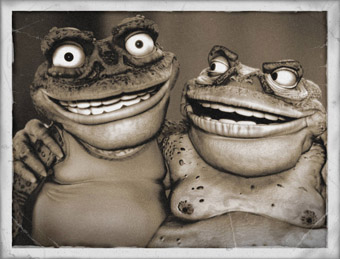
Cane Toads
Wendy Chandler’s Union Street (1990), a tale of street-level suburban machinations, is narrated by Andrew Denton and is beautifully ‘acted’, with fabulous photographic cut-outs coloured in and collaged, providing a graphic match for the intricately plotted drama. Lucinda Clutterbuck’s Tiga (1989) eulogises the Tasmanian Tiger with reminiscences from locals, a sumptuous soundtrack and variegated rotoscoping. Max Bannah’s sardonic One Man’s Instrument (1990), about a man who makes flora flourish amid the concrete jungle by playing his trumpet, is one of two films with distressing close-ups of a character’s penis and testicles; Bannah has the old meat and two veg literally pissing on the man’s dream, crass urbanisation winning out. Andrew Silke and David Clayton’s Cane Toads (2002) is a fine example of CGI (rare among these films), starring Baz, the horny-skinned animal version of Life Be In It’s Norm, except that Baz doesn’t take great strides, instead getting mangled for his efforts to better himself in a number of bloody and imaginative scenarios.
Anthony Lucas deserves praise for assembling this excellent program, and the inclusion of the TV ads was inspired. Assuming you’re of a certain generation, the frisson of recognition they provide reminds us that the inclusion of the words ‘animation’ and ‘Australian’ in the same sentence is not such a strange concept. And even if you’re not of that generation, the chance to see where the luminaries collected here might have gained inspiration from is invaluable. With its trip through the shimmering talent of Tupicoff, Petty, Watt and Cornwell, the program very effectively counterbalances any suggestion that Australian animation had no pulse pre-Krumpet.
As for themes, well, there is the Aussie gothic but if we’re going to read ‘Australianness’ into the program, let’s think in terms of “quality” rather than cultural cliche. After all, as Peter Cornwell said when asked why the Academy has suddenly embraced Australian animation, “There’s a different Australian sensibility, but it is really difficult to say what that is. We don’t really have an animation industry. There’s so many obstacles that you really have to be passionate about finishing it, you’re not just cynically making it for the market.”
Well said.
Flickerfest 17th International Short Film Festival: The Bold, the Brave & the Best—Celebrating 30 years of Australian Animation, curator Anthony Lucas, 124 minutes, Flickerfest national tour, Jan-March 2008
RealTime issue #84 April-May 2008 pg. 25
© Simon Sellars; for permission to reproduce apply to realtime@realtimearts.net



































































